The lions of Africa: expert advice on how to see them on your next safari
Sep 8, 2022 • 7 min read
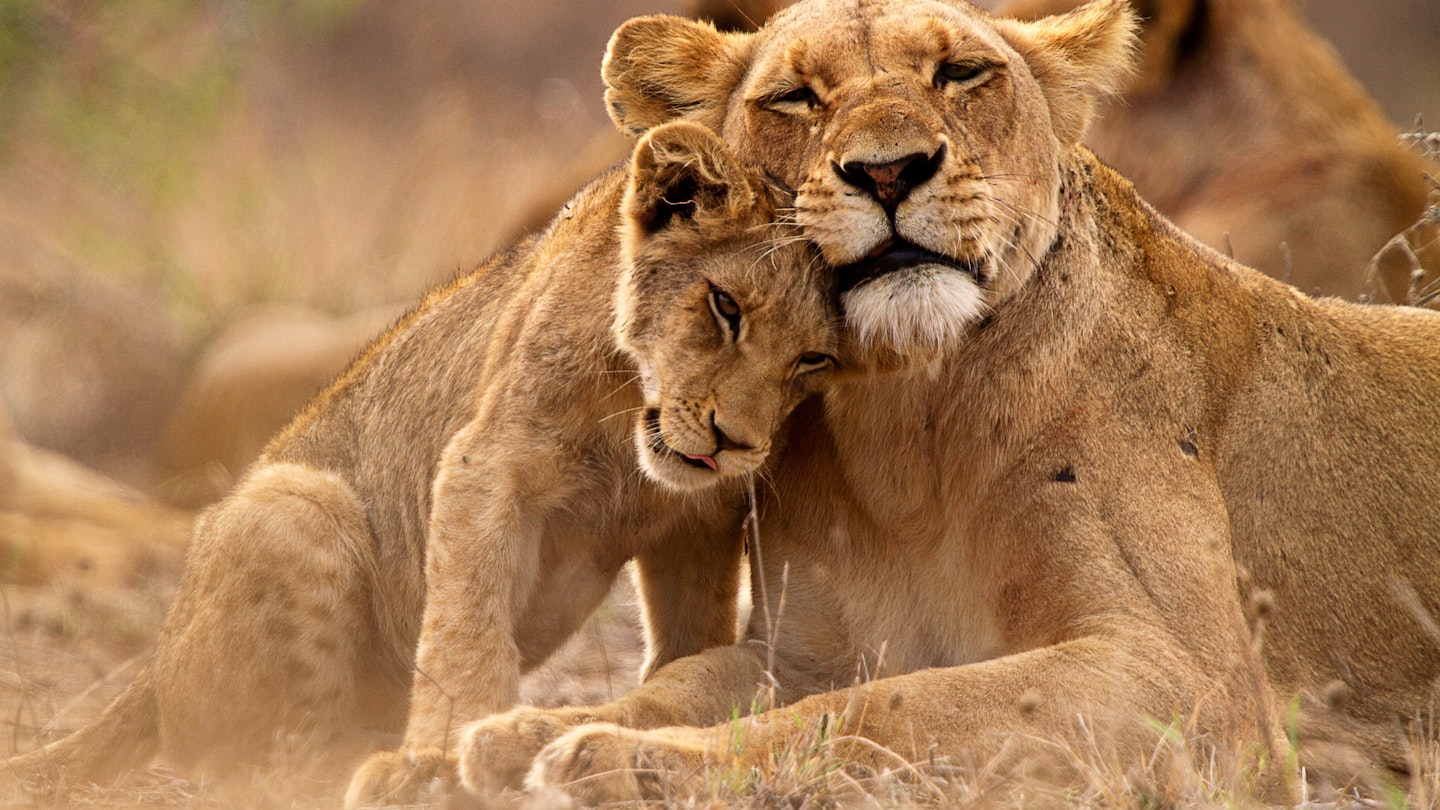
Observing the social aspect of lions' lives is one of the most memorable elements of an encounter with the species © Thomas Retterath / Getty Images
Few experiences in Africa live longer in memory than the first time you see a lion.
Lithe and ferocious, lions are without rival as Africa’s apex predator and carry on their body what one lion expert described as an “aura of impending violence”. The epitome of wild Africa, they are also the most sought-after prize on any safari to East Africa or Southern Africa for their combination of grace and grandeur, charisma and gravitas. Here we introduce you to the king of Africa’s cats, and tell you where's best to see them.


Africa’s biggest cat
Second in size among felines only to the tiger, lions are easily Africa’s largest cat species. Males can be over 2.5m long, 3.5m if you include the tail. The heaviest wild male lion recorded weighed in at a rather hefty 272kg. Females generally weigh between 110kg and 168kg. Lions can eat up to 25% of their own body weight in a single session and, on such occasions, even male lions can appear pregnant, so swollen are their bellies.
Female lions can live up to 18 years in the wild; males have been known to live up to 16, but rarely make it past 12. Lions can live up to 27 years in captivity.
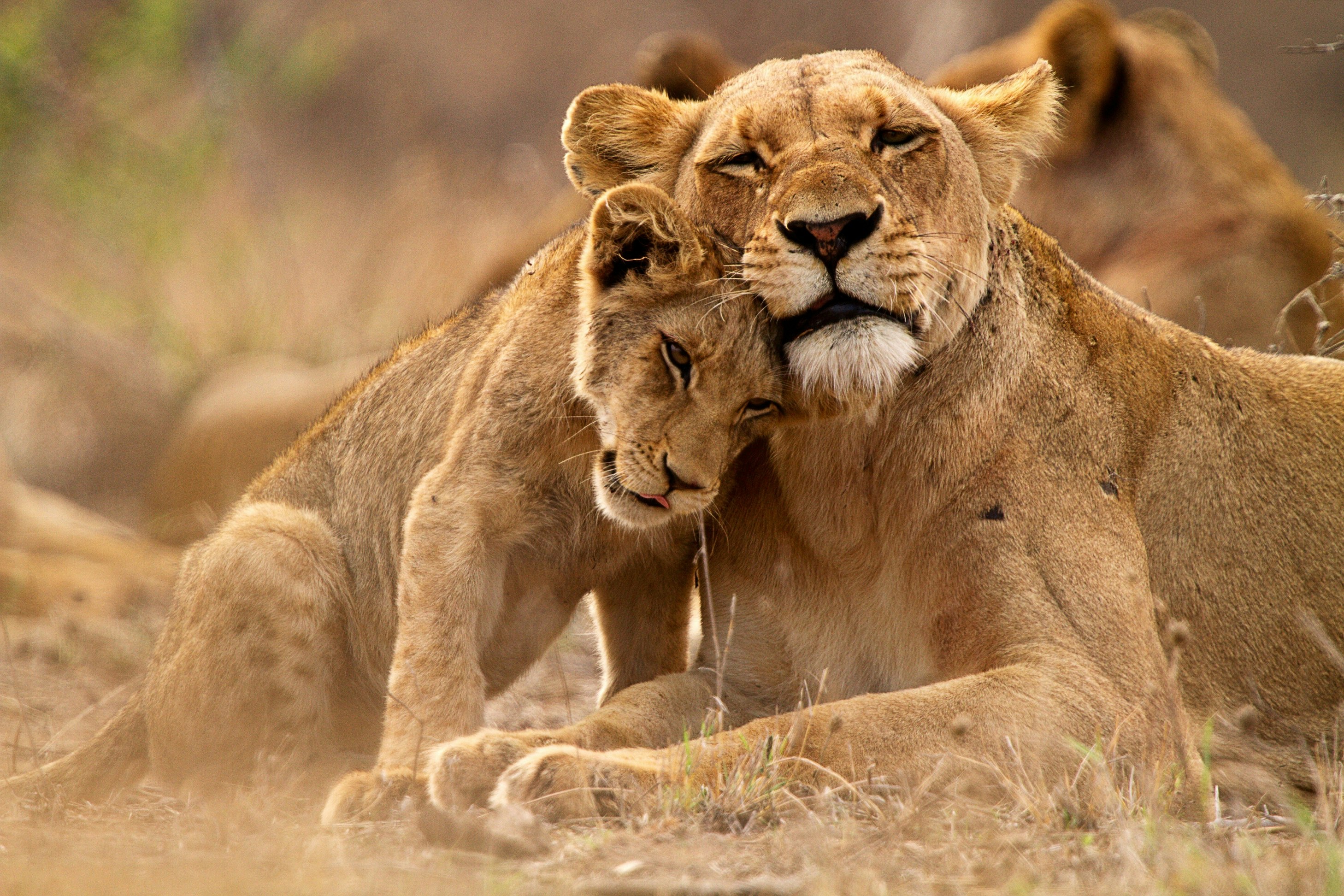
A social beast
There are 38 species of wild cats in the world, and the lion is the only social cat among them. Lions live in prides which can include more than 30 individuals, although many prides are much smaller, especially in areas where pressure from human populations is high, or in regions where prey is scarce.
A multi-generational sisterhood of lionesses forms the core of nearly every pride. Females born into the pride will, in many cases, remain with their sisters and mothers, aunties and grandmothers throughout their lifetimes. Together this formidable team of lionesses raises the pride’s cubs and inhabits a defined home range that can be as small as 35 sq km, or as large as 1000. They hunt as a team, defend their territory together against intruders, and raise cubs in a collective creche-like environment.
Safari animals: the story of rhinos (and the best places to see them)
Lion pregnancies last between three and four months and, when they are ready to give birth, lionesses retreat to a secluded place where the cubs are born. The average size of a litter of lions is between two and four, but as many as seven have been recorded. Cubs cannot open their eyes until around ten days after birth, and mothers keep their cubs hidden until they are around eight weeks old. Despite the protection afforded by the pride, lions are particularly vulnerable during their first two years of life.
When they reach adulthood, which for lions usually occurs between two and four years of age, the young males will leave their natal pride and search for a territory of their own – this is nature’s way of ensuring that sexually mature males do not mate with their own relatives. They will often join with brothers or cousins to form a coalition and, largely nomadic, these dispersing males will wander until they can successfully challenge a resident male (or males) for control of a pride. Once in control, they will patrol their territory, sometimes remaining on their own with the other coalition male(s), sometimes hanging out with the pride females and cubs.
Where to see rhinos on safari in Africa in 2022
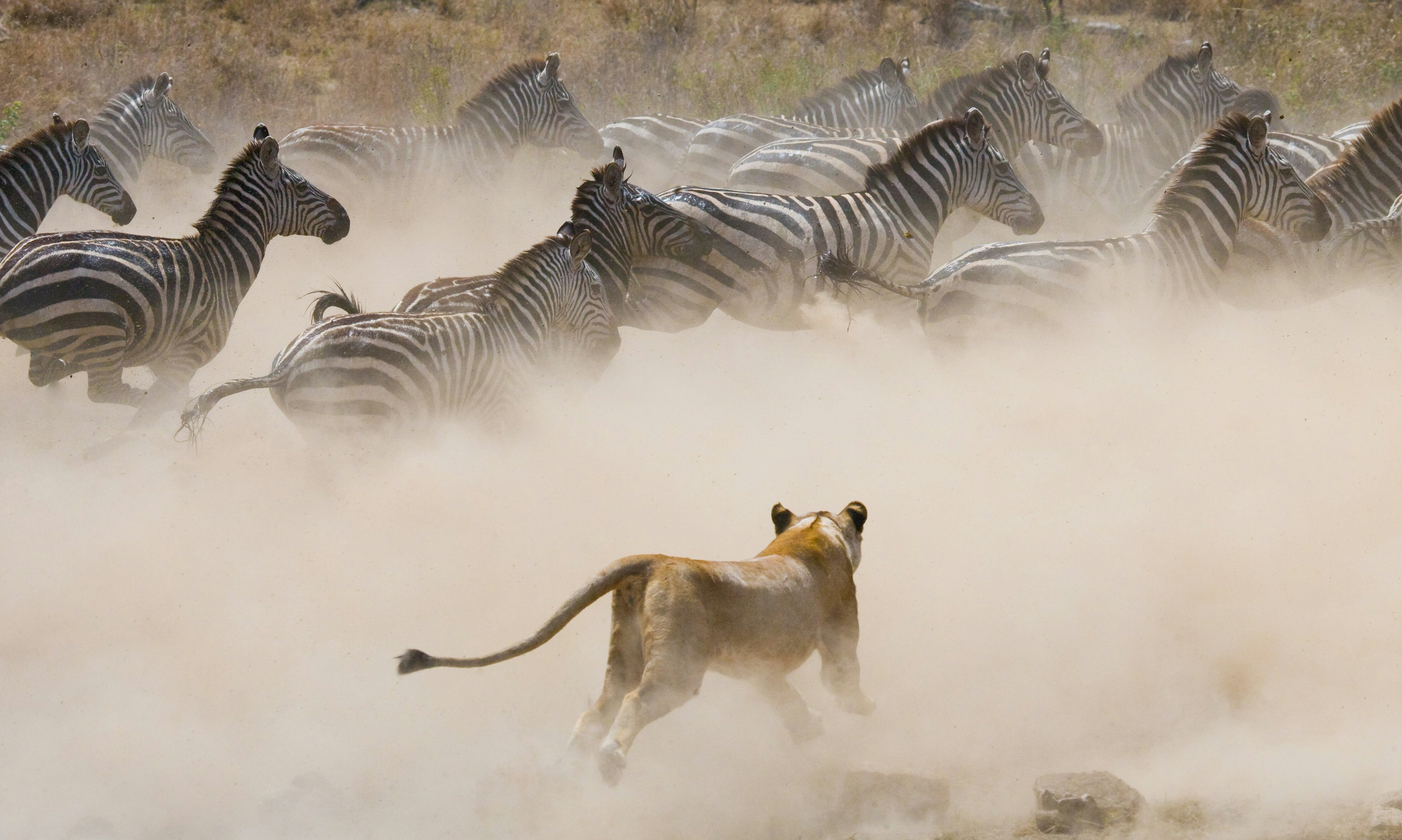
What lions eat
Lions are great opportunists and will eat springhares, elephants and most animals in between. Their favorite prey varies from one region to the next, but their diet often includes zebra, warthog, buffalo, wildebeest, impala, gemsbok, and warthog. One pride of lions even learned to hunt seals along Namibia’s northern coast. Lions also hunt giraffes – this is a particular specialty in Tanzania’s Selous Game Reserve . Lions commonly hunt elephants in Zimbabwe’s Hwange National Park, especially late in the dry season (September and October); the weight imbalance between lions and elephants, which can weigh 3.5 tons, is the greatest disparity between predator and prey in the animal kingdom. Even one-tonne buffaloes can weigh more than seven times that of the adult lioness bringing it down.
A day on safari in Africa: what you can expect in camp and in the wild
Although lions are skilled hunters and can reach a top speed of 93km/h, they rely on short bursts of speed rather than stamina – a typical lion hunt requires that lions stalk their prey to within around 15m before launching their attack. And despite such skills, their recorded success rate as hunters can be as low as 15% and never higher than 38.5% – in other words, significantly more than half of all lion hunts end in failure. And contrary to popular belief, lions routinely scavenge a significant proportion of their meals.
Lions will also eat domestic livestock, especially cows, and donkeys. With human beings and lions living in ever-closer proximity, such killings are a major cause of human-lion conflict, with many lions killed in retaliation.
Protecting rhinos from poachers in Africa - what it's like working on the frontline

King of the jungle?
Contrary to popular lore, the lion has never been king of the jungle: they are most at home out on savannah plains or in open woodlands. Lions can adapt to many different habitats, from dense woodlands in Ethiopia and Uganda to semi-arid environments such as Botswana’s Kalahari and the Skeleton Coast of northern Namibia. Although lions, like most cats, aren’t particularly fond of water, they have learned to become strong swimmers in Botswana’s watery Okavango Delta .
Are you ready for a self-drive safari?
The largest lion populations are in East and Southern Africa; some estimates suggest that half of Africa’s lions live in Tanzania . There are small lion populations elsewhere, including the Gir Forest, in the Indian state of Gujarat , and West Africa (where the lion is listed as Critically Endangered). The largest lion populations are in Selous Game Reserve and Ruaha National Park (Tanzania), the Serengeti -Masai Mara (Tanzania and Kenya ), Kruger National Park (South Africa) and the Kavango-Zambezi Transfrontier Conservation Area (which spans Angola, Botswana, Namibia, Zambia and Zimbabwe).
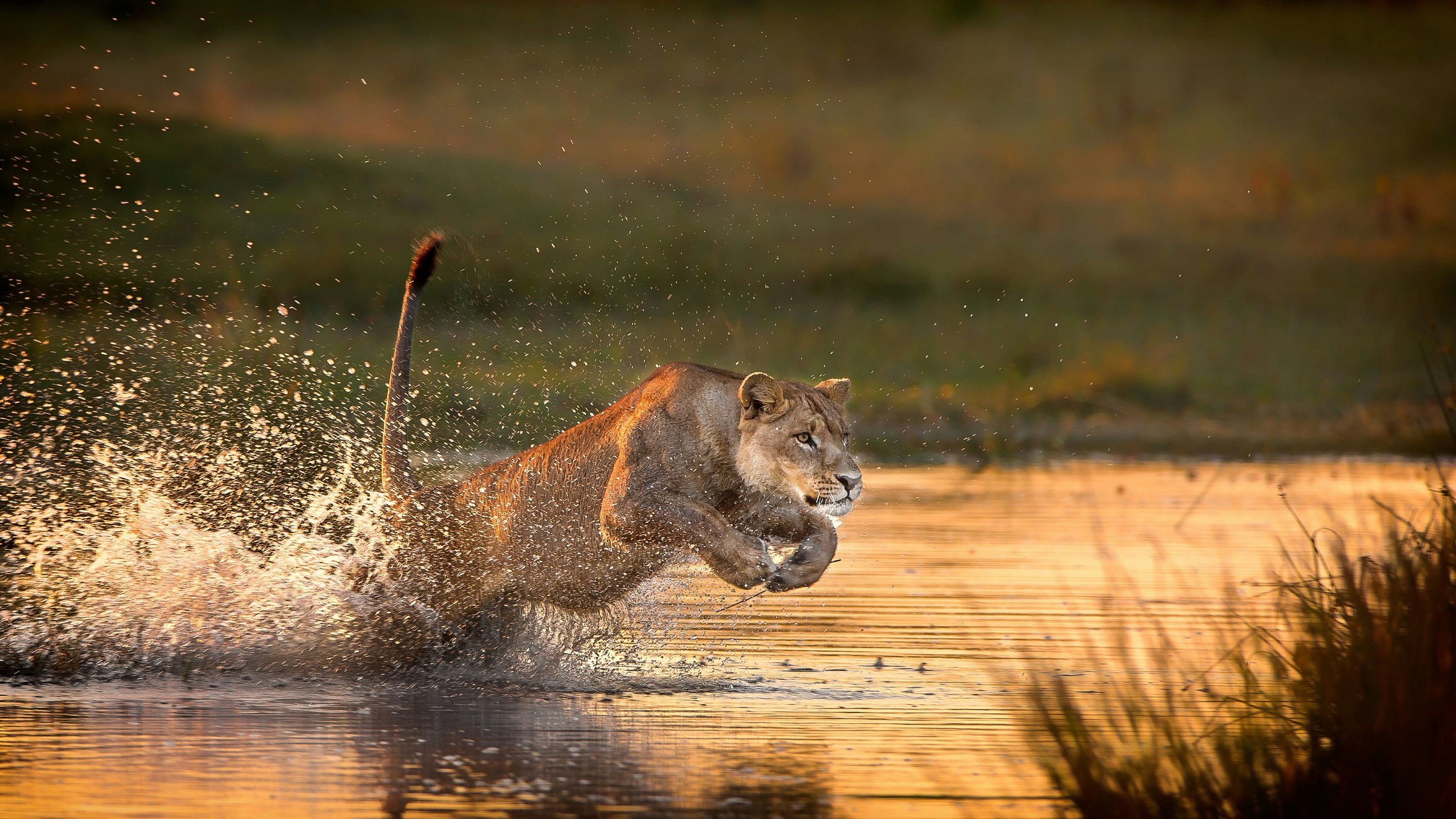
The best places to see lions on safari
Northern Botswana has excellent lion-watching territory, including Moremi Game Reserve and elsewhere in the Okavango Delta, Chobe National Park (especially the Savuti region) and the Central Kalahari Game Reserve.
Kenya is home to around 2000 lions, with sightings possible in Masai Mara Game Reserve and the surrounding community conservancies, Amboseli , Tsavo East and Tsavo West and Lake Nakuru national parks, as well as Samburu National Reserve and the conservancies of the Laikipia Plateau .
Wild times: a guide to the best national parks in Kenya
There aren’t many places in Namibia where you can see lions, but Etosha National Park in the country’s north is a brilliant exception. Khaudum National Park and the emerging parks of the Zambezi Region (formerly the Caprivi Strip) are quieter alternatives.
Beyond safaris, these are Namibia’s most awe-inspiring experiences
South Africa
Lions have been reintroduced onto many private reserves in South Africa. Otherwise, Kruger National Park is one of the world’s best places to see lions. Madikwe Game Reserve and Kgalagadi Transfrontier Park are less busy but also filled with lions.
The top 19 beaches in South Africa for sand, surf and scenery
This is prime lion-viewing land, and includes the Serengeti National Park, Ngorongoro Crater and Tarangire National Park in the north, and Selous Game Reserve and Ruaha National Park in the south.
Tanzania: an epic safari following the Serengeti's Great Migration
A much-underrated lion-watching destination, Zambia’s South Luangwa National Park is excellent, with North Luangwa and Kafue national parks offering wilder experiences.
Unforgettable adventure activities in Zimbabwe and Zambia
Hwange National Park is one of Africa’s best national parks and lion sightings are common. Mana Pools is another park with a healthy lion population that you can watch while on a walking safari.
8 vital things to know about South African safaris
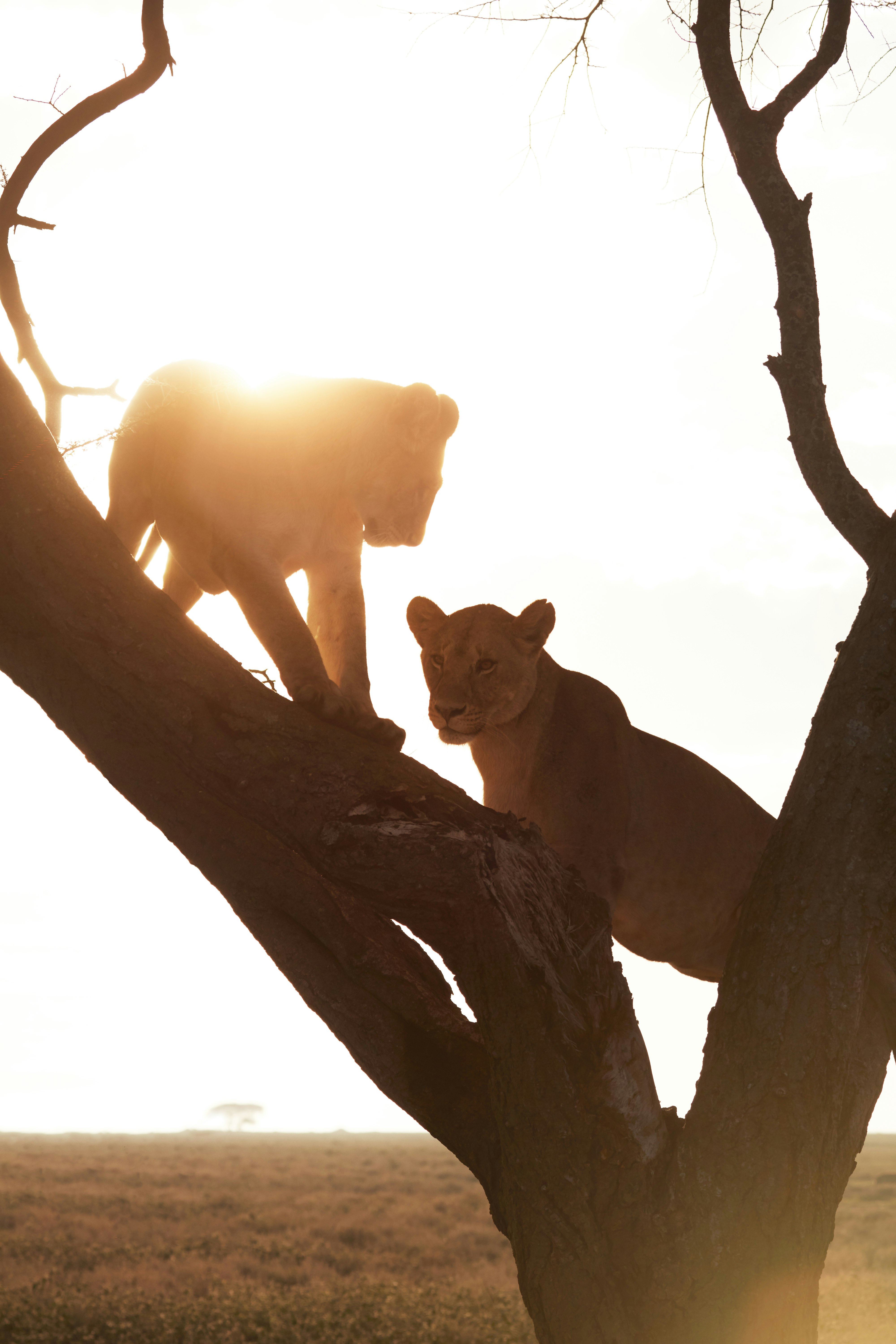
Lions in peril?
There are more rhinos, more elephants and more gorillas than there are lions in Africa. No one really knows how many lions there were in Africa a century ago, but most estimates suggest that it was more than a million. A study in 2019 estimated that there were just 22,509 left on the continent and that lions have disappeared from 95% of their former range.
Many lions live in isolated populations that may not be viable in the long term, and just 40% of Africa’s lions live within the boundaries of protected areas. Just eight countries are believed to have at least 500 adult lions: Tanzania, Botswana, Kenya, Mozambique, South Africa, Zambia, Zimbabwe and Namibia.
The lion is listed as Vulnerable by the International Union for the Conservation of Nature (IUCN).
Where to go for your first safari in Africa
This article was first published Oct 28, 2019 and updated Sep 8, 2022.
Explore related stories
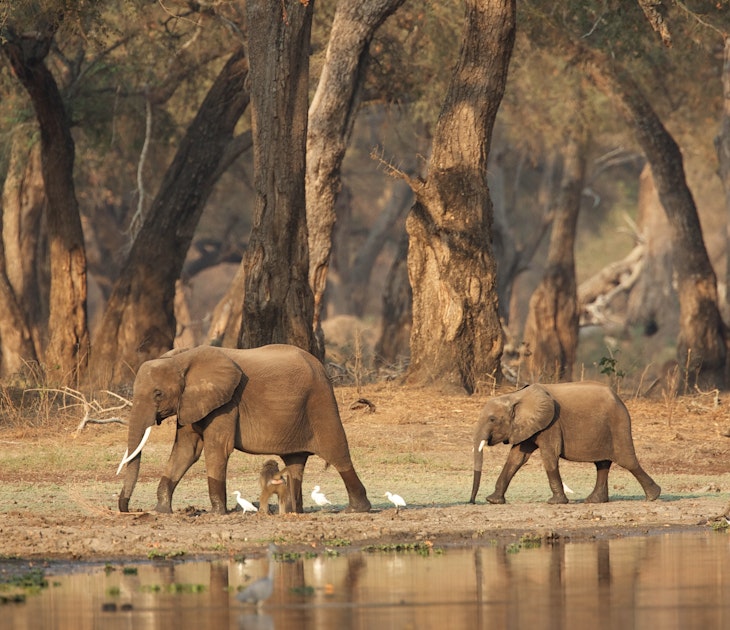
National Parks
Apr 25, 2024 • 7 min read
The African elephant is perhaps the most enduring symbol of nature’s grace and fragility. Here’s where to spot one (or many) in the wild.
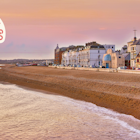
Aug 16, 2023 • 6 min read
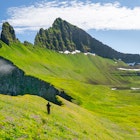
Dec 6, 2022 • 10 min read
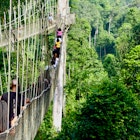
Nov 22, 2022 • 6 min read
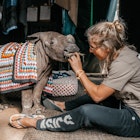
Aug 23, 2022 • 10 min read

Aug 18, 2022 • 6 min read
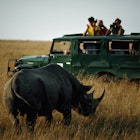
Aug 16, 2022 • 6 min read
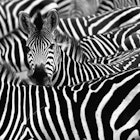
Jan 18, 2022 • 7 min read
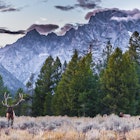
Dec 2, 2021 • 5 min read
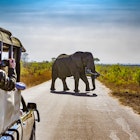
Oct 5, 2021 • 8 min read

- Find Your Tour
- Heavy Discount
- Enquire / Contact Us
- Send an Inquiry
- Map of Africa
- Contact Details
- African Safari Cost
- Travel Insurance
- Custom Safaris
- All Budget Safaris
- Africa Camping Safaris
- African Safaris for Seniors
- Exclusive Small Group Camping Safaris
- Gorilla Trekking Safaris & Tours
- Lodge Safaris
- Short Stay Tours
- All Overland Tours
- Camping Overland Tours
- Exclusive Overland Safaris
- Lodge Africa Overland Tours
- All Family Safaris
- Family Camping Safaris
- Family Lodge Safaris
- Family Safaris in East Africa
- Family Safaris in Southern Africa
- All Adventure Travel
- Great White Shark Diving
- Walking Safaris & Hiking Tours
- Chobe National Park
- Etosha National Park
- Garden Route
- Kilimanjaro
- Kruger National Park
- Ngorongoro Crater
- Okavango Delta
- Sabi Sands Game Reserve
- Serengeti National Park
- South Luangwa National Park
- Victoria Falls
- Zanzibar Island
- Masai Mara Conservancies
- Namib Desert
- Pilanesberg National Park
South Africa
- Kingdom of eSwatini
- Dar es Salaam
- Johannesburg
- Livingstone
- Antananarivo
- Port Elizabeth (Gqeberha)
- Adventure Travel & Activities
- Africa Beaches & Islands
- African Animals & Conservation
- African Culture
- Best Things to Do
- Big 5 Safari
- Bucket List Ideas
- Family Safari
- Overland Africa & Budget Safaris
- Places in Africa
- Safari Costs & Budgeting
- Travel Tips & Planning
- Where to See
- Botswana (Okavango Delta +)
- Cape Town + Garden Route
- East Africa
- Kenya (Masai Mara +)
- Kruger + Sabi Sands
- Morocco + Ethiopia
- Namibia (Etosha +)
- Rwanda + Uganda
- South Africa, Lesotho + Eswatini
- Southern Africa
- Tanzania (Zanzibar, Serengeti +)
- Zambia, Zimbabwe + Malawi
- Safari Costs
- Client Reviews

Where to see lions in Africa (best places for an African lion safari)
The most iconic animal in Africa, the lion is synonymous with the African safari experience. So, where are lions in Africa? If you are planning an African lion safari or dreaming of seeing these African big cats in the wild one day, this post will tell you all you need to know about the best places to see lions in Africa.
Lions used to roam freely across most of Africa, Europe, the Middle East, and Asia. As human populations developed and expanded, lions have gradually been confined to smaller and smaller habitats. Today, populations of wild African lions are limited to major African parks where there is enough food for these majestic predators, as well as sufficient land for them to roam.
The best places to see lions in Africa (in the wild) are in southern and eastern Africa. In particular, the best African lion safari countries include Tanzania, Kenya, Namibia, Botswana, and South Africa.
While all lions in Africa are the same species ( Pantera Leo) , not all lion safari destinations are equal. While you can see these apex predators in Tanzania, Kenya, Zambia, Botswana, Namibia, Zimbabwe, and South Africa, different destinations promise different kinds of African lion safari sightings. Remembering that African lions are wild animals and that sightings are never guaranteed, certain African lion safari destinations have developed reputations for particular kinds of lion sightings.

This guide answers the question, "Where are lions in Africa?" and looks at the best places to see lions in Africa. From tree-climbing and desert lions to the densest African lion populations, the fiercest lions, and the wildest lion safari destinations. Read on to find out everything you need to know about lion safari destinations in Africa.

See Lions in Africa to get tips for your African lion safari and find out all about these African big cats.
1. Where are lions in Africa the most abundant? - Serengeti and Masai Mara
The Serengeti-Mara ecosystem is famous for having the highest population density of lions in Africa, making it one of the very best places to see lions in Africa. Lion numbers are dependent on food and space. With the continuous migration of over 2 million wildebeest, zebra, and other antelope, lion numbers are not surprisingly high. In terms of sheer abundance, the setting of the Great Migration cannot be beaten. Spanning Kenya and Tanzania, the open savannah landscape of the Serengeti-Mara plains is a fantastic spot for an African lion safari.
“Nowhere else in Africa supports quite such a concentrated abundance of hoofed meat, amid such open landscape, and therefore the Serengeti is a glorious place for lions and an ideal site for lion researchers”
– David Quammen, National Geographic Magazine
To see lions on safari in Tanzania you should visit the Serengeti National Park. The Seronera region of central Serengeti is famous for lion safari sightings. High season from July to October, has amazing lion sightings as well as some remarkable game viewing. If the drama of the Grumeti and Mara River crossing is on your hit list, you should visit from June to September. If you are not a fan of large crowds then the low season, November to March, will give you a more relaxed atmosphere in which to seek out the roaming lion prides that call the Serengeti home.
- Serengeti Safari Packages
In Kenya, the top African lion safari destination is the Masai Mara National Park. The lions here were made famous by the BBC nature documentary series “The Big Cat Diary”. The Masai Mara high season starts around July when hundreds of thousands of wildebeest begin migrating across the Mara River into the Masai Mara National Reserve from the Serengeti. The wildebeest herds follow the fresh and succulent grasses that come after good rains. Remember that lions do not migrate. Pride lands are set up along the migration routes and the lions merely exploit the movement of these animals. In addition to the lions, the Masai Mara is also famous for cheetah populations that thrive on the wide-open grasslands.
- Masai Mara Safaris
back to the menu

2. Where are the biggest lions in Africa? - Duba Plains
The biggest lions in Africa are found on the Duba Plains in Botswana. Permanent water and nutritious grasses make the Duba Plains in the northern reaches of the Okavango Delta the perfect habitat for buffalo. Lions love buffalo. Almost a ton of meat that kicks and stabs with horns is a worthy prey for the king of the jungle.
The Duba Plains lions have evolved into powerful and unique specimens which is why this is one of the best places to see lions in Africa. They are the only (known) group of lions that seem to enjoy the water. Furthermore, constantly running through shallow water and taking down buffalo is the kind of workout that has resulted in the Duba Plains lions being about 15% larger than other lions. Another unique quirk is that these lions have adapted to hunt during the day, which is perfect for some epic game encounters.
The Duba Plains have pleasant daytime temperatures from March to August, but August is the most popular amongst safari-goers to the Delta. Temperatures are mild and slipping through the canals on a mokoro amongst the throngs of animals is one of the highlights of any safari adventure in Africa.
- Okavango Delta Safaris

3. Where are lions in Africa the most ferocious? - Savuti Marsh
In the arid Savuti region of Chobe National Park, a mega-pride of 30 lions faced an unprecedented challenge when the Savuti channel dried up. With a decline in water and lush vegetation, the ungulate population dwindled, posing a serious threat to the predators' food supply.
In a remarkable display of adaptability, the mega-pride formed and turned to an unconventional but abundant source: elephants. Forced by the necessity to target these massive creatures, the lions of Savuti became skilled elephant hunters, successfully taking down an estimated 74 elephants over three years. This extraordinary behaviour, which has been passed down through generations, defies traditional notions of lion prey preferences and draws wildlife enthusiasts and filmmakers to the Savuti region, eager to witness and document this unique survival strategy. Today this part of Chobe is still one of the most exciting destinations for an African lion safari.
- Savuti Marsh Tours

4. The best place to see lions in Africa hunting
The best places to see lions in Africa hunt are the banks of the Mara River in the Masai Mara National Reserve of Kenya and at the southern end of the Serengeti, during the calving season. Both locations are saturated with wildebeest at different times of the Great Wildebeest Migration . The wide-open plains are gold for those looking to witness the power of African lions hunting and the drama of a lion kill.
At the Mara River, the most iconic point of the great wildebeest migration, animals queue on mass to cross the perilous, crocodile-infested waters. The lions are waiting in ambush and between July and August is a great time to witness this spectacle.
Wildebeest calving season happens in January and March at the southern end of the Serengeti. The wildebeest gather, near Maswa and Ngorongoro, to have their young before the northward migration begins. Young animals must learn to run within minutes. Lions lie in wait for the comparatively easy pickings.
Difficult to stomach but fascinating to watch, lions in action – doing what lions do – is a once-in-a-lifetime experience, not for the faint of heart.
- Masai Mara Safaris (Kenya)

5. The best places for an African lion safari in Kruger National Park
Southern Africa’s most famous and most iconic national park is a must-visit for an African lion safari. Located in South Africa, the Kruger National Park is not only SA’s premier safari destination but also home to the majority of South Africa’s wild lions. This reserve is roughly (at just under 20,000 km²) the size of Wales. So if it is a lion safari you are after, you need to pay special attention to geography and climate.
Hot and dry in the northern reaches of the park, the lion density is about 6 lions per 100 km². This is because prey is harder to come by. It means that your odds of seeing what you came for are lower. South and central, where there is higher rainfall and therefore more vegetation, supports a greater number of herbivores and the lion population is almost twice that of the north. That means you are twice as likely to meet these majestic beasts. However, south and central Kruger is still pretty broad.
The best place for an African lion safari in the wilds of Kruger National Park is Sabi Sands.
Sabi Sands Game Reserve, part of Greater Kruger National Park, is one of South Africa’s top game viewing destinations. This private reserve has unparalleled game viewing due to abundant water and restricted access. While day visitors are not allowed, and only guided safaris are offered, these guides and safari vehicles have unrestricted movement around the reserve. Sabi Sands is renowned for its Big Five safari experiences, especially sightings of the big cats, lion, and leopard. Of the best places to see lions in Africa, this is one of our top favourites.
- Kruger National Park Safaris
- Sabi Sands Safaris

6. Where are white lions in Africa? - Timbavati
The white lions of timbavati have captured the imaginations of the west since the publication of chris mcbride’s 1977 book, the white lions of timbavati . sacred to the local tsonga people, “tsimba vati”, directly translated, means the place where the star lions fell to earth. these lions are sacred, mystical, and revered. the result of a genetic mutation called leucism, white lions are extremely rare..
“Timbavati Private Nature remains the only reserve in the world … where wild white lions occur regularly and naturally” William Sonnenberg
Timbavati Private Nature Reserve, north of Sabi Sands and part of the Greater Kruger National Park , is singular in the naturally occurring white lions. Occurring in two forms; white with blue eyes and pink lips, noses, and pads and brown eyes with black lips, noses, and pads. Reserved for only a lucky few, an encounter with these lions is described by many as a spiritual encounter.
In the late ’70s, two of these cubs were moved to Johannesburg Zoo for a breeding program. The resulting offspring are the estimated 400 captive white lions found around the world.
- Timbavati Safaris

7. Where to see black-maned desert lions? - Kalahari Desert
The best place to see the black-maned lions of the Kalahari is the Kgalagadi Transfrontier Park.
The Kgalagadi Transfrontier Park spans northern South Africa and Botswana and shares a border with Namibia to the west. The best time to visit the park is between the dry winter months of April and October. With little water available, animals congregate near permanent water sources. Chances of seeing special animals like the black manes lions increase as the bush thins and foliage dies off.
Black-maned desert lions are masters of the desert environment. More light-weight and slender with longer legs and larger feet, these desert-adapted lions are built for endurance. Their fur is pale gold and males sport a distinctive black mane. While large lion prides are the norm in game-rich wildlife reserves like Kruger and the Serengeti, in arid regions, prides can consist of a single mating pair, up to small prides of six members. The black-maned Kalahari Desert lions are rare and have become an icon of survival. Scientists believe that the black manes may indicate higher levels of testosterone and in turn, these black manes are more attractive to female lions.

8. Where are the man-eating lions in Africa? - Selous and Tsavo
Yes, that’s right—mane-less lions. Scientists are unsure exactly why these males do not have manes. It’s a bit of a mystery as sometimes mane-less lions are born in the same litter as maned lions in Africa. Mane-less lions are real, and if you are a lion connoisseur, then head to the Nyerere National Park (previously called Selous Game Reserve) of Tanzania. Here, mane-less lions are fairly common and are often the dominant males in their area.
A man-eater is something else altogether. Did you know that the famous man-eaters of Tsavo were mane-less? Between March and December 1898 a pair of male lions reportedly killed around 130 construction workers. Eventually, the rouge lions were shot and after being used as a carpet for a few years were sold to the Field Museum of Natural History in Chicago, USA, where they are on display today.
You can visit the site of these legendary killers and even stay at the Man-eaters Camp. The male lions at Tsavo in Kenya, generally do not have manes. The best time to visit Tsavo is between June and October and in January and February. At these times the game viewing is best and you might just get a glimpse of descendants of the legendary man-eaters of Tsavo.
- Selous Safaris in Tanzania
- Tsavo Safaris in Kenya

9. Best African lion safari day trips (Big 5 Safaris): Ngorongoro Crater
Tanzania's Ngorongoro Crater Conservation Area is part of the Serengeti Biosphere Reserve. Unique among African safari destinations, the Ngorongoro Crater is a large volcanic caldera . Encircled by the surrounding highlands, Ngorongoro is a wildlife haven. It is an ideal place to get close to wild lions in Africa as it boasts 5 prides on the crater floor. Lion sightings are almost guaranteed on safaris here thus Ngorongoro Crater is consistently rated as one of the best places to see lions in Africa.
The setting for the nearly 30,000 game animals that inhabit the crater floor is really extraordinary. Top African lion safari tip: go early to avoid the crowds, with one way in and one way out, visiting Ngorongoro Crater can get pretty busy. You can visit the wildlife-rich crater on a day trip from Arusha.
- Ngorongoro Crater Safaris

10. Best place to see lion and predator clashes: Chobe
Chobe National Park in Botswana is well known for its lion versus hyena predator clashes. Savuti, in the southern reaches of Chobe, is famous for its predator-rich safari sightings. With large prides of lions, hyenas, and leopards patrolling the woodlands these predators often clash over both territory and food. Savuti is hands down one of the best places to see lions and other predators clash.
- Chobe Safari Tours

11. Best African lion safari on foot: Zambia walking safari
Historically speaking, South Luangwa National Park is where walking safaris were pioneered. Zambia’s Luangwa Valley is home to a large population of African lions and the perfect place to do a walking safari.
When you walk in the African bush – without the safety of a vehicle – you become another animal, a part of the environment. There is something primal about this experience that is utterly unique. Walking safaris are designed for full immersion. You will leave behind the well-travelled roads and head off the beaten track. In Luangwa, you can do anything from a morning stroll to a multi-day action-packed hike, walking in the tracks of lions. Undoubtedly one of the best places to see lions in Africa, South Luangwa is arguably the best place for an African lion safari on foot!
- South Luangwa Safaris

12. Best big cities for an African lion safari: Nairobi, Cape Town, Johannesburg
Despite being famous for Big 5 safaris, African countries are modernizing and Cape Town, Johannesburg, and Nairobi are modern and cosmopolitan destinations. Cape Town is a tourist mecca, considered by many to be the most beautiful city in the world. Isn’t it reassuring to know that despite their very concrete existence in the modern world, you can still see lions only a short distance away?
Nairobi Lion Safari
Nairobi National Park is just 7km (4 miles) away from the heart of Nairobi. Lions, leopards, rhinos, and buffalos roam these Kenyan plains against the backdrop of the Nairobi city skyline. The proximity to a big city is unheard of.
- Safaris departing from Nairobi
Cape Town Lion Safari
The last lion was shot in Cape Town in 1802. These days, visitors to Cape Town will have to travel a little further to see lions and the other Big 5 animals, although not as far as you might think.
Here are the best Big 5 game reserves near Cape Town , including Sanbona Wildlife Reserve (3-hour drive), Inverdoorn Game Reserve (2.5-hour drive), Aquila Private Game Reserve (2-hour drive) and the Garden Route Game Lodge (3.5-hour drive).
These private game reserves are all malaria-free, affordable, and, most importantly, home to a variety of wild animals including the Big 5 animals of Africa.
- Cape Town Safaris & Tours
- Sanbona Safaris
- Inverdoorn Safaris
- Aquilla Safaris
Johannesburg Lion Safari
Johannesburg is not usually associated with lions and African lion safaris. However, if you have flown across the globe, a 4.5-hour drive to South Africa’s premier safari destination is not too bad. Kruger Park is world-renowned for good reason. The best place to see lions in Kruger National Park is south and central, with Sabi Sands being the top pick.
However, if this is a stretch too far, the Pilanesberg Nature Reserve is only 2.5 hours north-west of the big bad city. Pilanesberg is a fantastic Big 5 safari destination. The campsites are brilliant and the game viewing is excellent. Lions, elephants, and rhinos are common as well as a host of other herbivores. So close to both Pretoria and Johannesburg, that if you are pressed for time, it’s a no-brainer.
- Pilanesberg Safaris
- Kruger National Park Tours

13. Wildest places for African lion safaris: Ruhua and Niassa
To see African lions off the beaten path in wild terrain, you can visit Niassa Game Reserve in Mozambique or Ruaha in Tanzania. There are a few places where man has not yet made his mark. For example, while the Okavango is wild, it is also one of the most sought-after safari destinations. East Africa's most popular bucket list reserves are the Serengeti and Ngorongoro Crater. These destinations are popular for a reason but you are not going to get that alone-in-Africa, wild sort of feeling. Niassa and Ruaha are growing in popularity because of their unspoiled allure.
The Niassa Game Reserve in northern Mozambique is a fantastic lion safari destination. Difficult to access because of poor infrastructure, once there, the game viewing is indescribable. For years the reserve was lost to the public because of civil war. The war, though terrible, kept Niassa remote and wild. Today, the reserve is home to prolific game including thousands of elephants, healthy populations of African painted wolves as well as lions, hyenas, and large herds of herbivores. Niassa has three endemic species Niassa wildebeest, Johnstons impala, and Boehms zebra. The exciting thing about Niassa Reserve is that it is part of a proposed Selous-Niassa Wildlife Protection Corridor. This vast corridor would link reserves in southern Tanzania with those in northern Mozambique, creating the largest protected wildlife park on earth!
In Ruaha National Park in Tanzania, when viewing lions, you are likely to have the sighting all to yourself. Hidden away in central Tanzania and part of the 45,000km² Rungwa-Kizigo-Muhesi ecosystem , Ruaha has fewer than 6,000 safari-goers per year. That translates to about 16 visitors a day! This makes Ruaha one of East Africa’s hidden treasures.
The park itself has some remarkable draw cards. Wildly beautiful scenery studded with baobabs, Ruaha is home to 10% of the world's remaining lion population. In the Mwagusi area, African lion safari sightings are particularly good but in general, the density of predators in the park is some of the best in the country. Lastly, because of its remote location, Ruaha is excellent value for money and a brilliant African Budget safari option.
- Ruaha Safaris in Tanzania

14. Where are lions in Africa climbing trees?
Tree-climbing lions are a thing, and there are a few places where the behaviour is more common. So where are lions in Africa known to do this? Tree-climbing lions are most commonly sighted in East Africa, especially Tanzania and Uganda, with rarer sightings further south in sub-Saharan Africa. The best places to spot tree-climbing lions in Africa are Queen Elizabeth National Park in Uganda, and Lake Manyara National Park in Tanzania. The novelty of witnessing lions climbing trees makes these parks some of the best places to see lions in Africa, with a twist.
Find out where to see tree-climbing lions on safari: Best place to see tree-climbing lions in Africa
- Queen Elizabeth National Park
- Lake Manyara National Park

15. The most affordable African lion safari packages
There are many different kinds of African safari, and costs will depend on the destination, duration, season, number of people, and more. For more detailed information you can read our African Safari Cost page, but for now, here is a list of our most affordable African lion safari destinations and packages.
- Sanbona Wildlife Reserve near Cape Town
- The Kruger National Park , including Sabi Sands and Timbavati
- Etosha National Park in Namibia
- Hwange National Park - Zimbabwe
- Chobe National Park in Botswana

Plan an affordable African lion safari
There you have it, the best places to see lions in Africa, in a nutshell. If you'd like to see wild lions in Africa, African Budget Safaris has a huge selection of African safari tours to choose from.
Dive in and start planning with tips for your African lion safari and all about these African big cats . Or, get in touch with one of our passionate and knowledgeable travel experts to ask them any questions that you might have about lions, African lion safaris, or travelling to Africa in general.
African Budget Safaris specializes in private and tailor-made African Safaris on a budget, so we can customize a private African lion safari that is just right for you.
Contact African Budget Safaris today.
Andrew Hofmeyr Naturalist, Artist & Writer

Related Destinations
Explore these destinations mentioned in this post.

Private Group?
A private, tailor-made safari is within your reach. Experience all of your bucket-list safari related items on a budget now.
Similar & Related Blog Posts
Below you'll find further reading and articles related or similar to this post.

Cape Town Safari: The best Big 5 game reserves near the city (on a budget)
Cape Town is an amazing stand-alone travel destination. From the V & A Waterfront, Table Mountain, and penguins on Boulders Beach, to the Zeitz Mocca…

The Big 5 of Africa & Where to See These Famous Big 5 Animals
The Big 5 of Africa are the most often-mentioned, relentlessly searched-for and much-loved five big African animals. Spotting the Big 5 is a…

Best Malaria-Free Game Reserves for Family Safaris in the Eastern Cape of South Africa
For the best malaria-free safaris in South Africa, Addo Elephant Park and Big 5 Eastern Cape game reserves come out tops! Not only does the Eastern…

Lions in Africa: tips for your African lion safari and all about these African big cats
The African lion is the apex predator of the African wilderness. These powerful felines are one of the famous Big 5 safari animals, and there…

How the Niassa Carnivore Project Fights for African Wildlife in Mozambique
Here's a wildlife project run by truly passionate conservationists, who are fighting for the survival of lions and other wild animals in one of the…

The Predator Trap: the plight of ‘canned lions’ in Africa & how to help
The African lion conjures images of majestic white-maned predators ruling the savannah, the king of the beasts roaring loud or stalking its hapless…
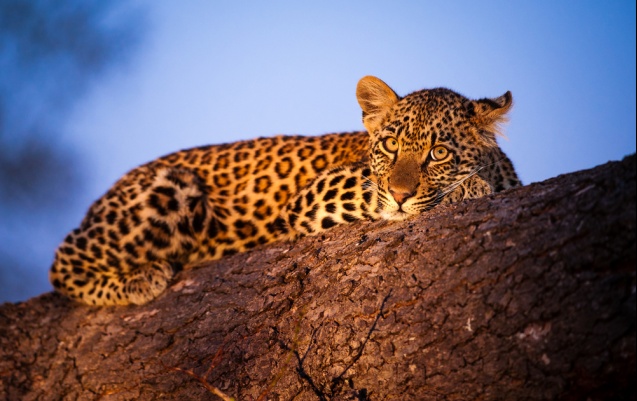
How to spot a leopard on your African safari
The first word that comes up when talking about leopards is 'elusive'. This is because they are generally solitary, and prefer to hang out in dense…

The Big Kruger Game Viewing Guide: Kruger National Park Safari Tips
Everybody should aim to go wildlife viewing in the Kruger National Park at least once. This leading South African game reserve boasts an astonishing…

How to Master Safari Etiquette in Kruger National Park
While we all know how exciting it is to see a lion or elephant in the wild, squealing with delight will send said animal fleeing. The same goes for having…

The Wild Cats of Kruger: Kruger National Park lions, leopards, cheetahs, and other African cats
Kruger National Park is home to diverse wild cats, from small genets to great big lions, and many in between. If you’re lucky, you…

Yes, lions climb trees! Here are the 4 top places to see tree-climbing lions in Africa
Wait, can lions climb trees? Oh, yes. Lions can climb trees and some lions in Africa do so more than others. These unusual lions have made it a habit to…

Stand back Big 5 animals: Bring on the Shy 5, the Ugly 5 and the Small 5 of Africa
While every person coming on a safari in Africa has the Big 5 animals – African Elephant, Cape Buffalo, African Lion, Black Rhino, and…

The Great Migration Africa: answers to your wildebeest migration safari FAQs
We have all seen the Great Migration in Africa on the internet and TV. Cleverly cut and dramatized clips of surging wildebeest herds, frothing water,…
These trips cover similar ground…

2 Day Big 5 Cape Town Safari to Aquila Game Reserve - Budget Lodge Tour
An outstanding value Big 5 Cape Town Safari to Aquila Private Game Reserve, just two hours from Cape Town. This Budget Cape Town Big Five Safari includes…
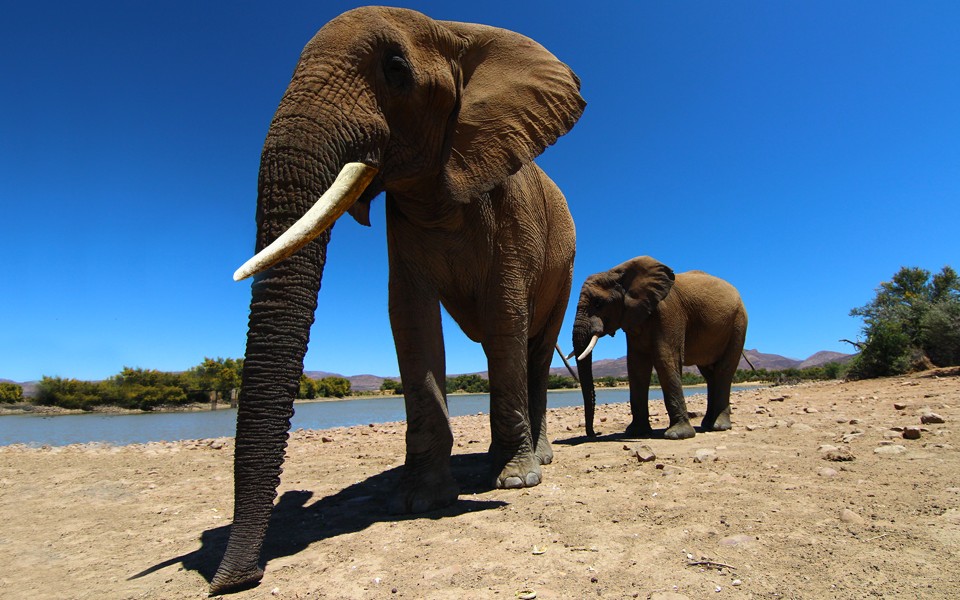
3 Day Cape Town Safari - Big 5 Budget Tour
An excellent-value Big 5 Cape Town Safari to Inverdoorn Game Reserve, only 2.5 hours from Cape Town. This Cape Town Budget Safari includes transfers, 4x4…

Full Day Addo Elephant Park Big 5 Safari
A guided full-day safari to the Big Five Addo Elephant Park. Enjoy an action-packed day of wildlife viewing with a professional guide in the malaria-free…
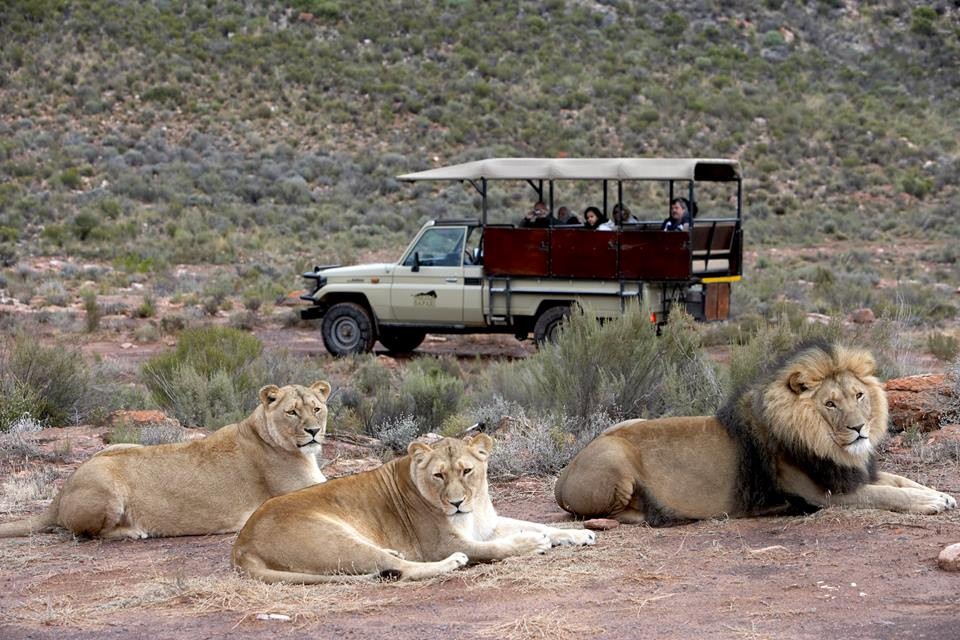
Big 5 Cape Town Safari to Aquila Game Reserve - Budget Day Tour
The perfect full-day Cape Town Safari to Aquila Game Reserve on a budget. Taste a Big 5 safari near Cape Town in Aquila private game reserve only 2 hours…

Connect with us
Useful resources.
- Get Travel Insurance
- Book Flights
- Get Car Hire
- Signup for our newsletter
Popular Destinations
Latest blogs.
- How to plan an African safari on a very tight budget: the 8-step guide to safari planning
- The 10 Safest Countries in Africa to Visit (2022 Global Peace Index Rankings)
- Best Countries to Visit in Africa? Here are 15 Amazing African Countries
- South Africa Tipping Etiquette: 8 Top Tips for Tipping in South Africa
- How Much Does an African Safari Cost? Your Budget Africa Safari Guide

Call us toll free from US/Canada on 1-888-414-6513 , or from the UK on 0-808-189-1052 . All other countries can contact us on +27 21 791 0878 .
© 2024 African Budget Safaris | Privacy | Terms | Cookie Policy | Consent Preferences
A member of the “Big 5” and perhaps Africa’s most iconic species, the African Lion is a highly sought after sighting while out on safari.
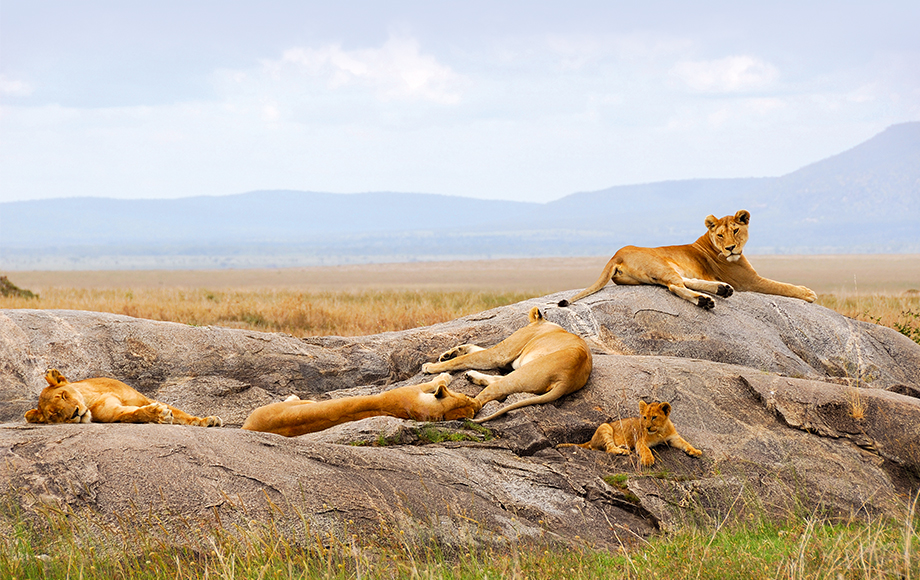
Common Name – African Lion
Scientific Name – Panthera Leo
Current IUCN Red List Status – VU
Estimated no. of mature individuals – 23,000 -39,000
Lions are capable of living in a wide variety of habitats and are found across parts of sub-Saharan Africa (mostly Southern and Eastern Africa). Lions generally stick to areas such as grasslands, shrubs and open woodland – however a small number have adapted over generations to thrive in the harsh Namib Desert in Namibia.
The only cats that live in groups – known as prides – lion prides can comprise up to 40 individuals. Though rare to see prides of this size, it is possible. More often than not, prides sizes vary between 8-25 individuals. Most of the hunting is done by female lions working as a team, and who will hunt anything from small antelope to buffalo. Some lion prides have been known to specialise in hunting even larger prey including elephant and giraffe. Males will often only help at the last moment or to bring down large prey – sometimes they run in only when the hunt is over taking the biggest share!
Lion viewing Safaris
Most lion viewing across Africa is done by vehicle on morning and afternoon game drives. It’s a thrilling experience coming face-to-face with a lion in the wild and many guests find a lion encounter to be a major highlight of an African safari. The cats may even use the vehicle as spot for shade, and guides can often find their vehicle surrounded by a handful of lions hiding from the sun.
Lions are fascinating to watch, particularly the dynamic within the pride and many safari-goers will happily watch for hours as the lions hunt or play. Playful cubs interact with one another under the watchful eye of their mothers and sometimes, the cheeky cubs might antagonise a big grumpy male.
Walking safaris offer the chance to see smaller creatures and learn more about native plants, but on occasion there is a chance to see lions – and from a very different perspective. To walk in Africa is to be a part of Africa, leaving nothing but footprints behind. Zimbabwe’s Hwange and Mana Pools national parks along with Zambia’s South Luangwa National Park are some of the best places in Africa to experience a multi-day walking safari reminiscent of a by-gone era. Both offer a truly unique experience while walking amongst Africa’s big game creates live long memories others can only dream of.
Best safaris to see lion
Timeless deserts & namib wildlife.
Discover the silent beauty of Sossusvlei, track Africa's last free-roaming rhino in Palmwag and go on safari in Etosha, Namibia's finest wildlife reserve.
Tanzania’s Northern Treasures
Experience three of Tanzania’s best known national parks and the country’s epic wildlife in Tarangire, Ngorongoro Crater and the celebrated Serengeti.
Inspiring Sights of Kenya
This superb safari incorporates the popular Giraffe Manor in Nairobi and 3 luxury camps situated in sensational gameviewing areas throughout Kenya.
Best of Zimbabwe
This safari explores three of Zimbabwe's greatest highlights: Hwange National Park, breathtaking Mana Pools National Park and Victoria Falls.
Exclusive Botswana
Take in the best of Botswana on this 12 day exclusive safari, travelling from the Makgadikgadi Pans through the Linyanti into the Okavango Delta.
Relais & Chateaux Kenya Safari
This outstanding Kenyan safari incorporates 2 Relais and Châteaux status safari camps with iconic Giraffe Manor.
Kruger and The Cape
Discover some of South Africa's best known attractions on this journey that begins with a big game safari in the world-renowned Sabi Sand and concludes in beautiful Cape Town.
Recommended places to see Lion
Namiri plains.
Situated in a little-visited, remarkably unspoilt corner of the Serengeti, Namiri Plains is where you’ll find some of East Africa’s best big cat sightings, from lion and leopard to cheetah.
Duba Plains Camp
Duba Plains Camp is an extravagant luxury safari camp set in a private concession in the Okavango Delta dubbed "Botswana's Masai Mara" for sheer density of wildlife.
Singita Lebombo Lodge
Perched high above Kruger National Park’s N’Wanetsi River, Singita Lebombo Lodge offers exceptional opportunities for intimate wildlife encounters.
Ruckomechi Camp
Set on the banks of the mighty Zambezi River, Ruckomechi Camp has been a favourite with visitors to the breathtaking Mana Pools National Park for many years.
What is a male lion coalition?
Coalitions are normally made up of 2-4 male lions (usually brothers or half-brothers) who hunt and fight off threats as a team. The more males working together, the stronger they are. It’s easier to keep control of a territory or fight an intruder if they work together.
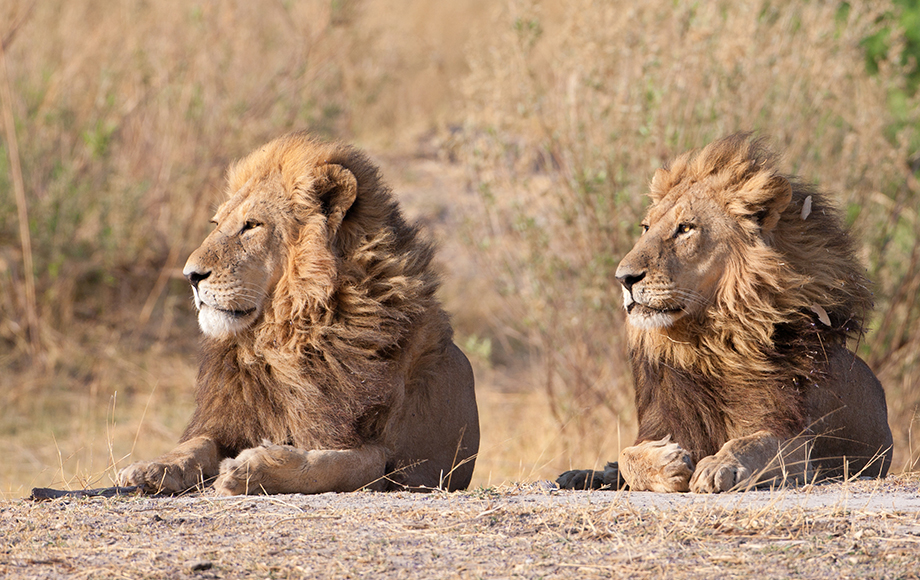
When is the best time to see lions?
Like most other animals, the best time to see these cats is during the early morning and late afternoon when they are most active. During the day, lions will often find a shady spot to avoid the heat and conserve energy.
African Lion Facts:
Sleepy cats A lion can sleep for up to 20 hours in a single day.
Hear me roar Depending on the wind direction, you can hear a lion roar from up to 7 or 8 kilometres away.
Big appetites Like other cats, lions may not know when their next meal might come from, meaning that they will consume food at an extraordinarily fast rate. This also helps to explain why they need to sleep for so long, to enable digestion.
Night vision A lion’s night vision is up to 6 times more sensitive to light than humans.
Weight Male lions are much larger than females and can weigh as much as 190 kilograms (420 pounds)Desert-adapted Lions – Also known as ‘desert lions’ these lions can live without water for extended periods. To cover long distances over the hot desert sand their legs tend to be slightly longer than ‘regular lions’, whilst their coats are slightly thicker to combat the cold temperatures at night. The best place to see these lions is in Northern Namibia.
Find out more about our tailor made African safaris. Get in touch with one of our Destination Specialists.
Subscribe below to keep up to date, find out more about our tailor made african safaris, more wildlife.
The Cape buffalo is a member of Africa’s “Big 5” and therefore a must-see for any safari-goer.
Cape Buffalo
The Cheetah is the fastest land animal on the planet and one of Africa’s most well-known and sought-after sightings when on safari
African elephants are the world’s largest land mammal and were once numerous, roaming across the whole African continent.
With their unique and beautiful colouring, giraffes are one of Africa’s most recognised animals.
Grizzly bear or grizzly is the name given to the subspecies of brown bear that inhabits North America.
Grizzly Bear
The largest cat in the Western Hemisphere, jaguars are strongly built, well-muscled predators native to the Americas
King Penguins don’t actually live on the Antarctic ice shelf, instead they prefer the sandy snowless beaches of the Sub-Antarctic islands.
King Penguin
Lemurs are endemic to the island nation of Madagascar where 107 species can be found. However each individual species is often only found in a
Leopards are graceful cats and still geographically wide-spread across Africa, including isolated parts of Morocco and Egypt.
Meerkats are found in Southern Africa and they are often seen standing on their rear legs, forever gazing out over the sweeping plains.
Orcas, informally referred to as killer whales because of their fearsome reputation, are majestic mammals.
Polar bears are found in the Arctic regions of Canada & Europe. The majority of their population are found in Canada, particularly around the
Impressively large and with horns for a nose, these prehistoric looking creatures are one of the most iconic African animals.
E-Newsletter
Sign up to receive updates about exciting journeys, special offers and more
- +256 392 176327
- +256 702 805580
- [email protected]
50 Must-See African Safari Animals

- Travel Guides
50 Must-See Animals on African Safari: The Ultimate Bucket List According to Seasoned Travelers
Nothing quite compares to the thrill of spotting wildlife on an African safari. The early morning anticipation as the sun breaks over the horizon, the rustling of leaves hinting at hidden creatures, and the breathtaking sight of a lion surveying its territory – these are moments that stay with you forever.
Having spent countless hours on safari in some of the world’s most incredible wildlife reserves, we’ve meticulously curated a list of the 50 most sought-after animals you might encounter on your African adventure. Based on extensive research into traveler preferences, online search trends, and expert recommendations, this comprehensive guide highlights the most iconic, elusive, and ecologically significant species that define the magic of the African wilderness.
We’ll share insider tips on where to find them, how to increase your chances of spotting them, and offer stunning images to ignite your safari dreams. From the iconic Big Five to the lesser-known but equally fascinating creatures, each animal plays a vital role in the intricate web of life that makes the African wilderness so extraordinary. So, prepare to be captivated as we guide you through the diverse and enchanting world of African safari animals.

1. African Lion
Enjoying the enviable position at the top of the food chain with no predators, the lion rules the wide-open African plains. The largest and grandest of all cats, lions live in small prides led by a single male. Their iconic manes and powerful roars are symbols of their strength and dominance. While primarily hunters, lions also scavenge, showcasing their adaptability in the harsh savanna environment.
How to Spot Lions
Without fear of other animals and no need to hide, they are the easiest cat to see on a game drive. Lions hunt at night and sleep during the day, sheltering from the sun under trees or thick vegetation. The best chance to see them is at dawn when they may still be hunting, or at dusk as they begin to rise for the evening. Listen for their distinctive roars, which can be heard from miles away.
Where to See Lion
You can see African Lions throughout Africa ; however, the best locations are in eastern and southern Africa.
- Serengeti National Park & Ngorongoro Crater, Tanzania: The Serengeti boasts a large lion population, offering excellent chances for sightings during game drives, especially around the Grumeti River. The Ngorongoro Crater has one of the highest densities of lions in the world, making it a prime location for observing their social dynamics.
- Masai Mara National Reserve, Kenya: The Masai Mara shares a border with the Serengeti and is another prime location for lion sightings, particularly during the Great Migration when prey is abundant.
- Kruger National Park, South Africa: Home to a significant lion population, the park offers diverse habitats for these predators, from open savannas to riverine areas.
- Okavango Delta, Botswana: The Delta is known for its large lion prides and unique opportunities to see them hunting in and around water.
- Queen Elizabeth National Park, Uganda: This park is renowned for its tree-climbing lions , a unique behavior observed in the Ishasha sector.

2. African Elephant
The African elephant is the largest land mammal on Earth, a symbol of wisdom, strength, and social bonds. These gentle giants roam the savannas and forests of Africa in matriarchal herds, displaying complex emotions and remarkable intelligence. Their enormous tusks, used for digging, lifting, and defense, are sadly a target for poachers, making their conservation a critical issue.
How to Spot Elephants
Elephants are not difficult to spot due to their size and distinctive features. Look for their large, flapping ears and long trunks, which they use for various tasks, including feeding, drinking, and communication. Listen for the rumbling sounds they make, as well as the cracking of branches as they move through the bush. Elephant dung is also a good indicator of their presence.
Where to See African Elephant
Elephants can be found in various habitats across Africa, but here are some of the best places to see them:
- Chobe National Park, Botswana: Chobe boasts one of the largest elephant populations in Africa, offering incredible opportunities for sightings along the Chobe River and in the surrounding woodlands.
- Hwange National Park, Zimbabwe: This vast park is home to large herds of elephants, often seen congregating around waterholes, particularly during the dry season.
- Amboseli National Park, Kenya: Amboseli offers stunning views of elephants with Mount Kilimanjaro as a backdrop, a truly iconic African scene.
- Addo Elephant National Park, South Africa: This park was established specifically to protect elephants and offers excellent chances to see them up close.
- Murchison Falls National Park, Uganda: This park is home to both savanna and forest elephants, offering diverse viewing opportunities. The park’s boat trips along the Nile River provide unique chances to see elephants from the water.

3. Mountain Gorilla
Mountain gorillas are powerful yet gentle giants, known for their close family bonds and surprisingly human-like expressions. These critically endangered primates inhabit the lush, mountainous forests of central Africa. Observing their social interactions, from playful youngsters to the dominant silverback, is a humbling and unforgettable experience.
How to Spot Mountain Gorillas
Mountain gorillas are some of the most notoriously difficult to track African safari animals due to their remote habitat and shy nature. To see them, you must embark on a gorilla trekking safari , led by experienced guides who know the gorillas’ territory. Be prepared for a physically demanding hike through dense vegetation, but the reward of encountering these magnificent creatures is well worth the effort.
Where to See Mountain Gorillas
You can see Mountain gorillas only in Africa in three countries:
- Uganda: Bwindi Impenetrable National Park and Mgahinga Gorilla National Park are home to roughly half of the world’s remaining mountain gorillas.
- Rwanda: Volcanoes National Park is another prime location for gorilla trekking, offering stunning views of the Virunga Mountains .
- Democratic Republic of Congo (DRC): Virunga National Park is the oldest national park in Africa and offers gorilla trekking opportunities, although the security situation in the region can be unpredictable.
Important Note: Gorilla trekking permits are required and must be booked well in advance due to limited availability. These permits contribute to conservation efforts and help fund the protection of these endangered primates.

4. African Leopard
The African leopard is a master of camouflage and stealth, making it one of the most elusive and sought-after animals on safari. Their stunning rosette patterned coat allows them to blend seamlessly into the dappled light of the bush, while their exceptional climbing skills enable them to stash their kills high in trees, safe from scavengers. Leopards are solitary creatures, often seen at night, adding an air of mystery to their allure.
How to Spot Leopards
Spotting a leopard requires patience and a keen eye. Look for their distinctive markings in the trees, on rocky outcrops, or along riverbeds. Leopards are often active at dawn and dusk, so these are prime times to search for them. Listen for the alarm calls of other animals, such as monkeys or birds, which may indicate a leopard’s presence. Tracks and scat can also be clues to their whereabouts.
Where to See African Leopard
Leopards are widely distributed across sub-Saharan Africa, but some of the best places to see these African safari animals include:
- Sabi Sands Game Reserve, South Africa: This private reserve is renowned for its high leopard density and excellent game viewing opportunities. The leopards here are habituated to vehicles, making them easier to observe.
- Masai Mara National Reserve, Kenya: The Mara’s diverse habitats, including open plains, riverine forests, and rocky outcrops, provide ideal leopard territory.
- South Luangwa National Park, Zambia: This park is known for its walking safaris, which offer unique opportunities to track leopards and other wildlife on foot.
- Okavango Delta, Botswana: The Delta’s network of waterways and islands creates a haven for leopards, and boat safaris offer a chance to spot them from a different perspective.
- Kruger National Park, South Africa: While not as well-known for leopards as Sabi Sands, Kruger’s vast size and varied landscapes still provide good chances for sightings, particularly in the southern region.

5. Rhinoceros
The rhinoceros is a critically endangered species, a powerful and prehistoric-looking creature with a thick hide and distinctive horns. These solitary herbivores are known for their poor eyesight but excellent sense of smell and hearing. Unfortunately, their horns are highly sought after in the illegal wildlife trade, making them a target for poachers and driving their numbers to dangerously low levels.
How to Spot Rhinos
Rhinos are notoriously shy and elusive, making them difficult to spot in the wild. They are also primarily nocturnal, adding to the challenge. However, with experienced guides and some luck, you may spot them browsing on vegetation or wallowing in mud. Look for their distinctive large tracks and their dung, which is often found in piles called middens.
Where to See Rhinoceros
Due to their endangered status, rhinos are found in limited areas, primarily in protected reserves and national parks. Some of the best places to see them include:
- Etosha National Park, Namibia: Etosha is home to a significant population of black rhinos, often seen around the park’s waterholes, especially at night.
- Damaraland, Namibia: This region offers unique opportunities for rhino tracking on foot, led by expert guides who work to protect these endangered animals.
- Kruger National Park, South Africa: Kruger has a substantial black rhino population, although sightings are less frequent than in some other parks.
- Lewa Wildlife Conservancy, Kenya: This private conservancy is known for its successful rhino conservation efforts and offers excellent opportunities for sightings.
- Ol Pejeta Conservancy, Kenya: Home to the last two northern white rhinos, Ol Pejeta also has a thriving black rhino population , making it an important site for rhino conservation.
- Ziwa Rhino Sanctuary, Uganda: Home to over two dozen northern white rhinos and the only place to watch them in Uganda .
Important Note: Rhino conservation is a critical issue, and many organizations are working tirelessly to protect these magnificent creatures from poaching and habitat loss. By visiting these parks and supporting conservation efforts, you can contribute to the survival of the black rhinoceros.

The cheetah is the world’s fastest land animal, capable of reaching speeds up to 70 mph in short bursts. Their slender bodies, long legs, and spotted coats are perfectly adapted for speed and agility. Cheetahs are diurnal hunters, meaning they are most active during the day, unlike many other big cats. They rely on their incredible speed to chase down prey, making for thrilling sightings on safari.
How to Spot Cheetahs
Look for cheetahs in open grasslands and savannas, where they have space to run. They often rest on termite mounds or other elevated spots to scan the landscape for prey. Cheetahs are relatively shy and are one of the most difficult African safari animals to approach, but their distinctive markings make them easier to spot from a distance. Their long tails, with a black tip, are also a giveaway.
Where to See Cheetah
Cheetahs are found across Africa, but their populations are fragmented and declining. Some of the best places to see them include:
- Masai Mara National Reserve, Kenya: The Mara’s open plains provide ideal hunting grounds for cheetahs, and sightings are relatively common.
- Serengeti National Park, Tanzania: The Serengeti’s vast grasslands offer another prime habitat for cheetahs, particularly in the southern Seronera area.
- Okavango Delta, Botswana: The Delta’s diverse habitats, including grasslands, woodlands, and floodplains, support a healthy cheetah population.
- Namibian Cheetah Conservation Fund: This organization is dedicated to cheetah conservation and offers opportunities to see these magnificent cats up close in their natural habitat.
- Kalahari Desert, Botswana and Namibia: The Kalahari’s harsh environment may seem surprising, but it’s home to a unique population of desert-adapted cheetahs.
- Kidepo Valley National Park, Uganda: Although less well-known than other parks, Kidepo’s open savannas provide excellent habitat for cheetahs , making for unique sightings away from the crowds.

The giraffe is the tallest mammal on Earth, instantly recognizable by its long neck, legs, and distinctive patterned coat. These gentle giants are herbivores, using their height to reach the leaves of acacia trees that other African safari animals cannot. Their calm demeanour and unique appearance make them a favourite among safari-goers, especially children. Giraffes are social animals, often seen in loose groups called towers, roaming the savannas.
How to Spot Giraffe
Giraffes are relatively easy to spot due to their height, which allows them to see over tall grasses and shrubs. Look for their long necks and spotted patterns against the savanna backdrop in areas with acacia trees, as these are their preferred food source. They are most active during the cooler hours of the day, so early mornings and late afternoons are good times to spot them browsing on leaves or drinking at waterholes. You may also spot them interacting with other animals, such as zebras and antelopes, with whom they often share grazing grounds.
Where to See Giraffe
Giraffes are found throughout sub-Saharan Africa, but some of the best places to see them include:
- Masai Mara National Reserve, Kenya: The Mara’s open plains provide ideal habitat for giraffes, and sightings are common.
- Serengeti National Park, Tanzania: The Serengeti’s vast grasslands support large populations of giraffes, offering excellent viewing opportunities.
- Etosha National Park, Namibia: Etosha’s unique landscape, with its salt pans and savannas, attracts giraffes, especially around waterholes.
- Kruger National Park, South Africa: Kruger’s diverse habitats support several subspecies of giraffe, including the rare Thornicroft’s giraffe.
- Tarangire National Park, Tanzania: Tarangire is known for its large herds of elephants and also boasts a healthy population of giraffes, often seen near the Tarangire River.

8. Hippopotamus
Despite their bulky appearance, hippos are surprisingly agile both on land and in water. These large, semi-aquatic mammals spend most of their days submerged in rivers and lakes, emerging at night to graze on vegetation. Hippos are known for their powerful jaws and sharp teeth, making them one of the most dangerous African safari animals. However, they are also fascinating to watch as they interact with each other and their environment.
How to Spot Hippos
Hippos are most easily spotted in or near water, where they spend the majority of their time. Look for their large, barrel-shaped bodies and distinctive snouts protruding from the water. You may also hear their loud grunts and snorts as they communicate with each other. Be cautious when observing hippos, as they can be unpredictable and aggressive, especially when feeling threatened.
Where to See Hippopotamus
Hippos are found in rivers, lakes, and wetlands across sub-Saharan Africa. Some of the best places to see them include:
- Okavango Delta, Botswana: The Delta’s abundant waterways provide ideal habitat for hippos, and boat safaris offer excellent viewing opportunities.
- Chobe National Park, Botswana: The Chobe River is home to large pods of hippos, often seen basking in the sun or grazing on the riverbanks.
- Kruger National Park, South Africa: Kruger’s rivers and dams attract hippos, and sightings are common during game drives.
- Murchison Falls National Park and Queen Elizabeth National Park, Uganda: The Kazinga Channel and the Nile River in Murchison Falls are teeming with hippos, and boat trips offer close-up views of these fascinating creatures.
- Lake Manyara National Park, Tanzania: Lake Manyara attracts a variety of wildlife, including hippos, which can be seen wallowing in the shallows or grazing on the shore.

Description: Zebras are iconic African equines, instantly recognizable by their bold black and white stripes. Each zebra’s stripe pattern is unique, like a fingerprint. These social animals roam the savannas in herds, often alongside other grazers like wildebeest. Zebras are herbivores, feeding mainly on grasses, and their keen eyesight and hearing help them detect predators. Their stripes are thought to serve multiple purposes, including camouflage, thermoregulation, and individual identification.
How to Spot Zebras
Zebras are relatively easy to spot due to their distinctive markings. Look for them in open grasslands and savannas, where they graze in herds. They are often found in close proximity to other herbivores, like wildebeest and gazelles. Their stripes may appear to blend together from a distance, creating a mesmerizing optical illusion. Listen for their barking calls and observe their social interactions within the herd, from playful foals to protective stallions. You might even witness a zebra’s impressive speed and agility as it evades a predator.
Where to See Zebra
Zebras are found in various parts of Africa, but some of the best places to see them include:
- Masai Mara National Reserve, Kenya: The Mara’s vast plains are home to large herds of zebras, especially during the Great Migration when they join millions of wildebeest in their epic journey.
- Serengeti National Park, Tanzania: The Serengeti’s grasslands support substantial zebra populations, offering excellent viewing opportunities throughout the year.
- Etosha National Park, Namibia: Etosha’s salt pans and savannas attract zebras, particularly around waterholes where they gather to drink.
- Kruger National Park, South Africa: Kruger is home to both plains zebras and the smaller mountain zebras, which can be found in the park’s higher elevations.
- Hwange National Park, Zimbabwe: This park boasts large herds of zebras, often seen alongside elephants and other grazers around the park’s numerous waterholes.

10. Chimpanzee
Chimpanzees are our closest living relatives, sharing approximately 98% of our DNA. These intelligent primates are known for their complex social structures, tool use, and problem-solving abilities. Observing chimpanzees in their natural habitat is a humbling experience, as you witness their playful interactions, grooming rituals, and even moments of conflict. Chimpanzees are omnivores, with a diet consisting mainly of fruits, leaves, and insects, but they also hunt and eat small mammals.
How to Spot Chimpanzee
Chimpanzees are found in dense rainforests, where they are often heard before they are seen. Listen for their calls, which can range from hoots and screams to pant-hoots, a unique vocalization used for long-distance communication. Chimpanzee nests, built high in the trees, are another sign of their presence. Tracking chimps can be challenging, but experienced guides can lead you to their usual haunts.
Where to See Chimpanzees
Chimpanzees are found in several East and Central African countries, but some of the best places to see chimps include:
- Kibale National Park, Uganda: This park is renowned for its large chimpanzee population and offers excellent opportunities for chimpanzee tracking and habituation experiences .
- Mahale Mountains National Park, Tanzania: This remote park on the shores of Lake Tanganyika is home to a thriving chimpanzee community, known for their unique behaviors and tool-using skills.
- Gombe Stream National Park, Tanzania: This is where Jane Goodall conducted her groundbreaking research on chimpanzees, and the park continues to be a vital site for chimpanzee conservation and research.
- Nyungwe Forest National Park, Rwanda: Nyungwe Forest boasts a large chimpanzee population and offers both chimpanzee tracking and canopy walks, providing different perspectives on their habitat.
- Budongo Forest Reserve, Uganda: This reserve is home to a habituated chimpanzee community, making for easier and more predictable sightings.
Important Note: Chimpanzee trekking permits are required and must be booked well in advance due to limited availability. These permits contribute to conservation efforts and help fund the protection of these endangered primates.

How much does an African safari really cost?
Know how we price African safaris

11. Cape Buffalo
The Cape buffalo, one of Africa’s iconic safari animals and a member of the “ Big Five, ” is a powerful and unpredictable bovine known for its massive horns and formidable strength. These social animals roam the savannas and grasslands of Africa in large herds, often exceeding several hundred individuals. Buffalos are herbivores, grazing on grasses and reeds, and their impressive horns are used for defense against predators and rivals. They are known for their strong herd instinct and will fiercely protect their young and vulnerable members.
How to Spot Cape Buffalos
Cape buffalos are relatively easy to spot due to their large size and distinctive horns. Look for them in open areas, near water sources, or in dense thickets where they seek refuge from the sun. They are often seen wallowing in mud to regulate their body temperature and protect themselves from parasites. Listen for their deep grunts and snorts, which can be heard from a distance.
Where to See Cape Buffalo
Cape buffalos are found in most African National Parks, and you can easily spot them as soon as you enter the sanctuary. But some of the best places to see them include:
- Kruger National Park, South Africa: Kruger boasts one of the largest buffalo populations in Africa, offering excellent opportunities to observe their behavior and social dynamics.
- Chobe National Park, Botswana: The Chobe River and surrounding floodplains are home to large herds of buffalo, often seen grazing or crossing the river in dramatic scenes.
- Masai Mara National Reserve, Kenya: The Mara’s grasslands and woodlands provide suitable habitat for buffalos, and they are a common sight during game drives.
- Hwange National Park, Zimbabwe: This park is home to a significant buffalo population, often seen congregating around waterholes, especially during the dry season.
- Selous Game Reserve, Tanzania: This vast reserve boasts a large and diverse buffalo population, offering opportunities to see them in different habitats, from open savannas to riverine areas.

12. Nile Crocodile
The Nile crocodile is an apex predator, an ancient reptile that has remained largely unchanged for millions of years. These massive creatures can grow up to 20 feet long and weigh over a ton. They are opportunistic hunters, ambushing prey at the water’s edge with lightning-fast strikes. While feared for their powerful jaws and sharp teeth, Nile crocodiles play a crucial role in maintaining the balance of aquatic ecosystems.
How to Spot Nile Crocodiles
Nile crocodiles are most easily spotted basking in the sun on riverbanks or sandbars. Look for their distinctive armored bodies, long snouts, and powerful tails. Be extremely cautious when approaching water bodies where crocodiles are known to inhabit, as they can be incredibly stealthy and may attack without warning. Listen for their deep, guttural growls or the splashing sounds they make when entering the water.
Where to See Nile Crocodile
Nile crocodiles are found in rivers, lakes, and wetlands throughout sub-Saharan Africa. Some of the best places to see them include:
- Okavango Delta, Botswana: The Delta’s abundant waterways provide ideal habitat for crocodiles, and boat safaris offer safe and exciting viewing opportunities.
- Kruger National Park, South Africa: Kruger’s rivers and dams are home to large crocodile populations, often seen sunning themselves on the banks or lurking in the water.
- iSimangaliso Wetland Park, South Africa: This park’s estuary and lake system is home to numerous crocodiles, which can be seen during boat trips or from observation decks.
- Murchison Falls National Park, Uganda: The Nile River in Murchison Falls is teeming with crocodiles, and boat trips offer close-up views of these impressive reptiles.
- Lake Kariba, Zimbabwe and Zambia: This massive lake is known for its large crocodile population , often seen during boat cruises or from lakeside lodges.

13. Wildebeest (Gnu)
Description: Wildebeest, also known as gnus, are large, stocky antelopes with distinctive curved horns and shaggy manes. They are renowned for their epic annual migration across the Serengeti-Mara ecosystem , a natural wonder of the world. During this journey, millions of wildebeest, along with zebras and other herbivores, traverse the plains in search of fresh grazing and water, facing numerous challenges and predators along the way.
How to Spot Wildebeest
Wildebeest are highly social African safari animals and are typically found in large herds. Look for them in open grasslands and savannas, especially during the migration season. They are often accompanied by zebras, creating a stunning spectacle of contrasting stripes and solid brown bodies. Listen for their loud grunts and snorts as they communicate within the herd. The best time to witness the Great Migration varies depending on the location and the stage of the migration. Consult with a safari expert or guide to plan your trip accordingly for the most rewarding experience.
Where to See Wildebeest
Wildebeest are found in various parts of Africa, but the most spectacular place to witness them is during the Great Migration:
- Serengeti National Park, Tanzania: The Serengeti is the starting point of the Great Migration, where vast herds of wildebeest gather and calve before embarking on their journey.
- Masai Mara National Reserve, Kenya: The Mara is the final destination of the migration, where the wildebeest face the perilous crossing of the Mara River, often with dramatic encounters with crocodiles.
- Ngorongoro Crater, Tanzania: While not directly part of the migration route, the crater’s floor is home to a resident population of wildebeest, offering excellent viewing opportunities throughout the year.
- Tarangire National Park, Tanzania: This park attracts large numbers of wildebeest, especially during the dry season when they congregate around the Tarangire River.
- Liuwa Plain National Park, Zambia: This remote park is home to the second largest wildebeest migration in Africa, offering a less crowded alternative to the Serengeti-Mara.

14. African Wild Dog
Description: African wild dogs, also known as painted wolves or painted dogs, are highly social and intelligent predators. They are known for their unique mottled coats, large ears, and tireless pursuit of prey. These endangered canines live in tight-knit packs, cooperating to hunt and raise their young. Their hunting strategies are fascinating to observe, as they use teamwork and endurance to wear down their prey.
How to Spot Wild Dogs
African wild dogs are most active during the day, making them easier to spot than some nocturnal predators. Look for them in open grasslands and savannas, where they hunt in packs. Their distinctive markings and large ears make them relatively easy to identify, even from a distance. Listen for their high-pitched yipping calls as they communicate with each other during the hunt. Joining a guided safari led by experienced trackers and guides significantly increases your chances of finding and observing wild dogs.
Where to See African Wild Dog
Due to their endangered status and fragmented populations, African wild dogs are not as widespread as some other safari animals. However, there are still some prime locations where you can increase your chances of spotting them:
- Kruger National Park, South Africa: Kruger is one of the best places to see wild dogs in Africa, with several packs inhabiting the park’s diverse habitats.
- Madikwe Game Reserve, South Africa: This reserve has a thriving wild dog population and offers excellent game viewing opportunities in a malaria-free environment.
- Moremi Game Reserve, Botswana: Moremi’s diverse ecosystems, including floodplains, woodlands, and lagoons, provide ideal habitat for wild dogs.
- Mana Pools National Park, Zimbabwe: This park is known for its large concentration of wild dogs, which can often be seen hunting along the Zambezi River.
- Selous Game Reserve, Tanzania: While wild dog sightings are less frequent here than in some other parks, Selous still offers a chance to see these elusive predators in a vast and remote wilderness.

Chacma baboons are highly intelligent and social primates, known for their complex hierarchical structures and intriguing behaviors. Baboons are the largest Old World monkeys and are found throughout southern Africa, adapting to a variety of habitats, from savannas to forests. Their troops, which can number in the hundreds, are led by dominant males who maintain order and protect the group. Observing their social interactions, grooming rituals, and playful antics is a highlight of any safari.
How to Spot Baboons
Chacma baboons are relatively easy to spot due to their large size and distinctive features, such as their long, dog-like muzzles and bright pink bottoms. Look for them in trees, on rocky outcrops, or foraging on the ground. They are often found near water sources and are most active during the day. Listen for their loud barks and screams, which can be heard from a distance.
Where to See Chacma Baboon
Chacma baboons are widespread throughout southern Africa, but some of the best places to see them include:
- Kruger National Park, South Africa: Kruger is home to numerous baboon troops, often seen along roadsides, in campsites, or near water sources.
- Cape Point Nature Reserve, South Africa: This reserve at the tip of the Cape Peninsula offers excellent opportunities to see baboons interacting with their environment and even raiding tourist vehicles for snacks!
- Chobe National Park, Botswana: Chobe’s riverine forests and woodlands provide ample habitat for baboons, which are often seen alongside other primates like vervet monkeys.
- Victoria Falls, Zimbabwe/Zambia: The lush vegetation around Victoria Falls attracts baboons, and they can often be spotted near the falls or in the surrounding rainforest.
- Augrabies Falls National Park, South Africa: This park’s rocky terrain and riverine areas are home to baboon troops, which can be seen foraging for food and interacting with each other.

16. Warthog
Warthogs are wild members of the pig family, instantly recognizable by their elongated snouts, curved tusks, and wart-like bumps on their faces. They are found in savannas and woodlands throughout sub-Saharan Africa. Warthogs are herbivores, using their snouts to dig for roots and tubers. They are also known for their unusual habit of kneeling on their front knees while grazing. While they may appear comical, warthogs are surprisingly fast runners and can be quite defensive when threatened.
How to Spot
Warthogs are relatively common and can be found in open areas where they graze. Look for their distinctive snouts and tusks, as well as their raised tails, which they hold upright while running, resembling a radio antenna. They are most active during the cooler hours of the day and are often seen wallowing in mud to regulate their body temperature and protect themselves from parasites. Look for warthogs in areas with short grasses or near waterholes, where they are likely to be grazing or wallowing.
Where to See Warthog
Warthogs are widely distributed across sub-Saharan Africa, making them a common sight on safari. Some of the best places to see them include:
- Kruger National Park, South Africa: Kruger’s diverse habitats support a large population of warthogs, and they are frequently seen during game drives.
- Masai Mara National Reserve, Kenya: The Mara’s open plains are home to numerous warthogs, often seen grazing alongside zebras and wildebeest.
- Etosha National Park, Namibia: Etosha’s waterholes attract warthogs, providing excellent opportunities to observe their behavior and interactions with other animals.
- Hwange National Park, Zimbabwe: This park’s savannas and woodlands are home to numerous warthogs, often seen wallowing in mud or grazing in family groups.
- Moremi Game Reserve, Botswana: Moremi’s diverse habitats support a healthy warthog population, and they can be seen in a variety of settings, from open plains to riverine forests.

Impalas are graceful and agile antelopes, known for their leaping ability and distinctive black markings on their rumps. They are found in savannas and woodlands throughout eastern and southern Africa. Impalas are herbivores, feeding on grasses, leaves, and shoots. They are social animals, living in herds led by a dominant male. Their alarm calls, a series of loud snorts and whistles, are a common sound on safari and often alert other animals to the presence of predators.
How to Spot Impalas
Impalas are relatively common and can be found in open areas where they graze. Look for their slender bodies, long legs, and lyre-shaped horns (in males). Their distinctive black markings on their rumps, known as “M” marks, are easy to spot. They are often seen leaping through the air, a behavior known as “pronking,” which is thought to be a display of agility and fitness. Listen for their alarm calls, which can be a sign of a nearby predator
Where to See Impala
Impalas are widespread throughout eastern and southern Africa, making them a common sight on safari. Some of the best places to see them include:
- Kruger National Park, South Africa: Kruger is home to large populations of impalas, often seen grazing in open areas or near water sources.
- Masai Mara National Reserve, Kenya: The Mara’s grasslands provide ideal habitat for impalas, and they are often seen alongside other grazers like zebras and wildebeest.
- Serengeti National Park, Tanzania: The Serengeti’s vast plains support substantial impala populations, offering excellent viewing opportunities throughout the year.
- Etosha National Park, Namibia: Etosha’s salt pans and savannas attract impalas, especially around waterholes where they gather to drink.
- Hwange National Park, Zimbabwe: This park’s savannas and woodlands are home to numerous impalas, often seen in large herds grazing or resting in the shade.
- Queen Elizabeth National Park, Uganda.

The kudu is a majestic antelope, known for its large, spiraling horns (in males) and striking vertical stripes on its coat. There are two species of kudu: the greater kudu and the lesser kudu. The greater kudu is the largest antelope species in southern Africa, while the lesser kudu is smaller and found in eastern Africa. Both species are herbivores, browsing on leaves, shoots, and fruits. Kudus are shy and elusive creatures, often found in dense bush or woodland areas.
How to Spot Kudu
Spotting a kudu requires patience and a keen eye, as they are well camouflaged in their natural habitat. Look for their distinctive horns and vertical stripes, which help them blend into the vegetation. Kudus are most active in the early morning and late afternoon, so these are prime times to search for them. Listen for the sound of their hooves as they move through the bush or their alarm barks when they sense danger.
Where to See Kudu
Kudus are found in various parts of Africa, but some of the best places to see them include:
- Kruger National Park, South Africa: Kruger is home to both greater and lesser kudus, with the greater kudu being more common in the southern part of the park.
- Addo Elephant National Park, South Africa: This park’s dense thicket and woodland areas provide ideal habitat for kudus.
- Hwange National Park, Zimbabwe: Hwange’s diverse habitats support a healthy population of kudus, and they can be seen in various areas, including open woodlands and near waterholes.
- Samburu National Reserve, Kenya: This reserve is a good place to spot the lesser kudu, which is adapted to drier conditions than the greater kudu.
- Madikwe Game Reserve, South Africa: This malaria-free reserve is home to a significant population of kudus, often seen browsing on leaves or resting in the shade.

19. Gazelle
Gazelles are graceful and swift antelopes, known for their delicate features and incredible speed. There are several species of gazelle found in Africa, each with its own unique characteristics and adaptations to different habitats. Some of the most common gazelle species include Thomson’s gazelle, Grant’s gazelle, and impala (although impala are sometimes considered a separate category). Gazelles are herbivores, feeding on grasses, leaves, and shoots. They are also prey animals, relying on their speed and agility to outrun predators.
How to Spot Gazelle
Gazelles are often found in open grasslands and savannas, where they can easily spot predators and run for cover. Look for their slender bodies, long legs, and curved horns (in males). They are most active during the cooler hours of the day and are often seen grazing in herds. Their swift movements and graceful leaps make them a captivating sight on safari.
Where to See Gazelle
Gazelles are found throughout Africa, but the specific species and their distribution vary. Some of the best places to see different gazelle species include:
- Masai Mara National Reserve, Kenya: The Mara is home to large populations of Thomson’s gazelles, known for their distinctive black stripe along their flank.
- Serengeti National Park, Tanzania: The Serengeti’s vast plains support various gazelle species, including Thomson’s and Grant’s gazelles.
- Etosha National Park, Namibia: Etosha’s salt pans and savannas attract springbok, a type of gazelle known for its unique “pronking” behavior.
- Amboseli National Park, Kenya: This park is home to Grant’s gazelles, known for their long, lyre-shaped horns.
- Kalahari Desert, Botswana and Namibia: The Kalahari is home to the gemsbok, a large gazelle species adapted to arid conditions.

As the largest of the African safari animals in the antelope family, the eland is a majestic creature with a stocky build and distinctive spiraling horns. Two subspecies exist: the common eland of eastern and southern Africa, and the giant eland of central and western regions. Both are herbivores, browsing on leaves, shoots, and fruits. Elands are social animals, often forming sizable herds, and their imposing size makes them a noteworthy presence on the savanna.
How to Spot Eland
Due to their size, elands are relatively easy to spot amongst other African safari animals. Look for them in open grasslands and woodlands, typically grazing in herds. Their light brown or gray coats may have faint vertical stripes, and males sport larger horns and a dewlap (a hanging fold of skin under the neck).
Where to See Eland
Eland distribution varies by subspecies, but these are prime viewing locations:
- Kruger National Park, South Africa: Abundant common eland populations, often seen in open areas.
- Addo Elephant National Park, South Africa: Diverse habitats support both common and Livingstone’s elands.
- Hwange National Park, Zimbabwe: Open woodlands and grasslands are ideal for eland sightings on game drives.
- Serengeti National Park, Tanzania: Vast plains host both common and East African elands.
- Kgalagadi Transfrontier Park: This arid park is home to the gemsbok, a unique eland subspecies adapted to the desert.

21. Gemsbok (Oryx Gazella)
The gemsbok, also known as the oryx, is a large and distinctive antelope adapted to arid environments. Its striking black-and-white facial markings, long, straight horns (present in both males and females), and tufted tails make it easily recognizable. Gemsboks are herbivores, grazing on grasses and browsing on shrubs and leaves. They are known for their ability to survive in harsh desert conditions, obtaining moisture from the plants they eat and conserving water through specialized physiological adaptations.
How to Spot Gemsbok
Gemsboks are typically found in arid regions, such as deserts and dry savannas. Look for their black and white markings, long horns, and tufted tails. They often gather in small herds, which can be seen grazing or resting in the shade during the heat of the day. Their tracks, with their characteristic pointed hooves, can also be a clue to their presence.
Where to See Gemsbok
Gemsboks are primarily found in southern Africa, with some populations in East Africa. Some of the best places to see them include:
- Kgalagadi Transfrontier Park, South Africa and Botswana: This vast park, spanning the Kalahari Desert, is a prime location for gemsbok sightings. Their unique adaptations to arid conditions make them well-suited to this environment.
- Etosha National Park, Namibia: Etosha’s salt pans and grasslands attract gemsboks, especially around waterholes during the dry season.
- Namib-Naukluft National Park, Namibia: This park’s stunning desert landscapes provide a dramatic backdrop for gemsbok sightings.
- Central Kalahari Game Reserve, Botswana: This remote reserve is home to a healthy population of gemsboks, offering a chance to see them in a truly wild setting.
- Tsavo West National Park, Kenya: This park’s dry savannas and rocky outcrops provide suitable habitat for gemsboks, although sightings are less common than in southern Africa.

22. Common Ostrich
The common ostrich is the world’s largest bird, a flightless wonder known for its incredible speed and powerful legs. These long-necked birds are native to Africa and are found in savannas, grasslands, and deserts. Ostriches are herbivores, feeding on grasses, leaves, and even small reptiles. They are social animals, often seen in groups called flocks, with a dominant male leading the way. Despite their inability to fly, ostriches can run up to 45 mph, making them the fastest-running birds on Earth.
How to Spot Common Ostrich
Ostriches are relatively easy to spot due to their large size and distinctive appearance. Look for their long necks, powerful legs, and fluffy feathers. They are often seen in open areas, where they can run freely and spot predators from a distance. Their nests, which are simple depressions in the ground, can also be a clue to their presence.
Where to See Common Ostrich
Ostriches are found in various parts of Africa, but some of the best places to see them include:
- Masai Mara National Reserve, Kenya: The Mara’s open plains provide ideal habitat for ostriches, and they are often seen grazing alongside zebras and wildebeest.
- Serengeti National Park, Tanzania: The Serengeti’s vast grasslands support large populations of ostriches, offering excellent viewing opportunities throughout the year.
- Etosha National Park, Namibia: Etosha’s salt pans and savannas attract ostriches, especially around waterholes where they gather to drink.
- Kalahari Desert, Botswana and Namibia: The Kalahari’s harsh environment may seem surprising, but it’s home to a unique population of desert-adapted ostriches.
- Kruger National Park, South Africa: Kruger is home to a significant population of ostriches, often seen in open areas or near water sources.

23. Vervet Monkey
Vervet monkeys are small, agile primates with distinctive blue and green markings on their backs and a black face framed by white fur. These social creatures are known for their chattering calls, which can vary depending on the type of predator they spot. Vervets are omnivores, with a diet consisting mainly of fruits, leaves, and insects, but they will also opportunistically eat bird eggs, small reptiles, and rodents. They are found in a variety of habitats, including savannas, woodlands, and forests throughout sub-Saharan Africa.
How to Spot Vervet Monkey
Vervet monkeys are relatively common and can be found in trees, on the ground, or even around human settlements. Look for their distinctive blue and green markings, as well as their long tails, which they use for balance while navigating the branches. Listen for their alarm calls, which are often a good indicator of a predator’s presence. Vervets are most active during the day, making them easier to spot than some nocturnal primates.
Where to See Vervet Monkey
Vervet monkeys are widespread throughout sub-Saharan Africa, making them a common sight on safari. Some of the best places to see them include:
- Kruger National Park, South Africa: Kruger is home to numerous vervet monkey troops, often seen in trees, on the ground, or even raiding campsites for food.
- Masai Mara National Reserve, Kenya: The Mara’s riverine forests and woodlands provide ideal habitat for vervet monkeys, and they are often seen alongside other primates like baboons.
- Amboseli National Park, Kenya: Amboseli’s acacia woodlands attract vervet monkeys, and they can often be spotted playing in the trees or foraging for food on the ground.
- Lake Manyara National Park, Tanzania: This park’s groundwater forest is home to a thriving vervet monkey population, often seen alongside other primates like blue monkeys.
- Chobe National Park, Botswana: Chobe’s riverine forests and floodplains provide ample habitat for vervet monkeys, which are often seen in large troops, sometimes numbering in the hundreds.

24. Meerkat
Meerkats are small, social mongooses known for their adorable upright posture and cooperative behavior. These charismatic creatures live in burrows in arid regions of southern Africa, forming close-knit family groups called mobs or gangs. Meerkats are primarily insectivores, using their sharp claws and keen eyesight to dig for insects and other small prey. They are also known for their vigilance, with one or more members of the mob acting as sentinels, standing on their hind legs to scan the surroundings for predators.
How to Spot Meerkat
Meerkats are some of the most entertaining small animals to watch on African safari. They are most active during the day and are often seen standing upright on their hind legs, scanning the landscape for danger. Look for them in open areas with sandy or gravelly soil, where they build their burrows. Their burrows often have multiple entrances and exits, and you may see them popping in and out or basking in the sun near the entrance. Listen for their chirping calls as they communicate with each other. Joining a guided safari led by experienced guides who know the meerkats’ habits and behaviors will increase your chances of a successful sighting.
Where to See Meerkat
Meerkats are primarily found in southern Africa, with some populations in Namibia and Botswana. Some of the best places to see them include:
- Makgadikgadi Pans National Park, Botswana: This vast salt pan is home to several meerkat families, offering excellent opportunities to observe their behavior and social interactions.
- Kgalagadi Transfrontier Park, South Africa and Botswana: This arid park is another prime location for meerkat sightings, with numerous mobs inhabiting the sandy dunes and grasslands.
- Tswalu Kalahari Reserve, South Africa: This private reserve is known for its habituated meerkat families, which allow visitors to get up close and observe their daily lives.
- Kalahari Meerkat Project, South Africa: This research and conservation project offers opportunities to learn about meerkat behavior and participate in meerkat habituation experiences.

25. African Fish Eagle
The African fish eagle is a majestic bird of prey, renowned for its distinctive cry, often referred to as the “voice of Africa.” With a wingspan of up to 2.4 meters (7.9 ft), this powerful raptor is easily recognizable by its white head and chest, contrasting with its brown body and black wings. Fish eagles are skilled hunters, swooping down from perches to snatch fish from the water with their sharp talons. Their impressive aerial displays and iconic calls make them a sought-after sighting on safari.
How to Spot African Fish Eagle
African fish eagles are often found near rivers, lakes, and coastlines, where they hunt for fish. Look for them perched on tall trees or rocky outcrops, scanning the water for prey. Listen for their distinctive call, a loud, ringing “weee-ah, hyo-hyo-hyo,” which echoes across the water. You might also spot them soaring through the air, their white heads and chests contrasting against the blue sky.
Where to See African Fish Eagle
African fish eagles are widespread throughout sub-Saharan Africa, wherever there are suitable bodies of water. Some of the best places to see them include:
- Okavango Delta, Botswana: The Delta’s abundant waterways attract fish eagles, and they are a common sight during boat safaris.
- Kazinga Channel, Uganda: Kazinga Channel in Queen Elizabeth National Park is a popular destination for boat safaris with many aquatic animals to see.
- Lake Malawi, Malawi: This massive lake is home to a thriving fish eagle population, and they can be seen soaring above the water or perched on the shores.
- Lake Kariba, Zimbabwe and Zambia: This large lake is another prime location for fish eagle sightings, often seen fishing or nesting on the islands.
- Zambezi River, Zambia and Zimbabwe: The Zambezi River and its surrounding areas provide excellent habitat for fish eagles, and they can be spotted from the banks or during boat cruises.
- Lake Baringo, Kenya: This freshwater lake attracts fish eagles, which can be seen fishing or perching on the acacia trees that line the shore.

26. The Shoebill
The shoebill, also known as the whalehead or shoe-billed stork , is a unique and prehistoric-looking bird found in the swamps and wetlands of East Africa. Its most striking feature is its enormous, shoe-shaped bill, which it uses to catch fish, frogs, and even young crocodiles. Shoebills are solitary birds, often standing motionless for long periods while hunting for prey. Their statuesque appearance and unusual feeding habits make them a fascinating addition to any African safari.
How to Spot The Shoebill
Shoebills are large birds, standing up to 1.5 meters (5 feet) tall, and are relatively easy to spot when they are out in the open. Look for their distinctive blue-gray plumage, massive bills, and long legs. They are often seen standing motionless in shallow water or on floating vegetation, waiting to ambush their prey. Their nests, large platforms of vegetation, are typically built in secluded areas of swamps and wetlands.
Tip: Joining a guided boat tour or visiting a specialized shoebill viewing area is the best way to increase your chances of spotting this elusive bird. Be patient and observant, as they are often motionless for long periods. Their unique appearance and fascinating hunting behavior make them a truly unforgettable sight on safari.
Where to See Shoebill
Shoebills are found in limited areas of East Africa, primarily in swamps and wetlands. Some of the best places to see them include:
- Mabamba Swamp, Uganda: This wetland near Entebbe is a prime location for shoebill sightings , with boat tours offering excellent opportunities to observe these unique birds.
- Bangweulu Wetlands, Zambia: This vast wetland system is home to a significant population of shoebills, and they can be seen during boat trips or from hides.
- Sudd Swamp, South Sudan: This massive swamp is considered a stronghold for shoebills, although access can be difficult due to the region’s security situation.
- Akagera National Park, Rwanda: Akagera Park ‘s wetlands and lakeshores provide suitable habitat for shoebills, and sightings have been reported in recent years.

27. Secretary Bird
The secretary bird is a unique and fascinating raptor, known for its long legs, elegant gait, and distinctive appearance. This bird of prey is found in open grasslands and savannas throughout sub-Saharan Africa. It is a skilled hunter, preying on snakes, lizards, insects, and small mammals. Secretary birds use their powerful legs and sharp talons to stomp and kill their prey, a behavior that has earned them their name, as their long feathers resemble the quills once used by secretaries.
How to Spot Secretary Bird
Secretary birds are relatively large and easy to spot due to their unique appearance. Look for their long legs, tall crests, and black tail feathers with white tips. They are often seen walking or running through grasslands, searching for prey. Their nests, large platforms of sticks built in trees or on cliffs, can also be a clue to their presence. The Secretary bird’s elegant gait and distinctive appearance make it one of the most memorable birds to spot on African safari.
Where to See Secretary Bird: Secretary birds are found in open grasslands and savannas throughout sub-Saharan Africa and are some of the top birding safari highlights . Some of the best places to see them include:
- Masai Mara National Reserve, Kenya: The Mara’s open plains provide ideal habitat for secretary birds, and they are often seen hunting for snakes and other prey.
- Serengeti National Park, Tanzania: The Serengeti’s vast grasslands support a healthy secretary bird population, and they can be seen throughout the park.
- Kruger National Park, South Africa: Kruger’s diverse habitats offer suitable environments for secretary birds, and they can be spotted in open areas or near water sources.
- Etosha National Park, Namibia: Etosha’s salt pans and grasslands attract secretary birds, especially during the wet season when prey is more abundant.
- Kgalagadi Transfrontier Park, South Africa and Botswana: This arid park is home to a unique population of secretary birds, adapted to the harsh desert conditions.

28. African Penguin
The African penguin, also known as the jackass penguin due to its donkey-like braying call, is a charming and charismatic bird found along the southern coast of Africa. These flightless penguins are known for their distinctive black and white markings, waddling gait, and playful nature. They are highly social animals, living in colonies on rocky shores and islands. African penguins are excellent swimmers, using their flippers to propel themselves through the water in search of fish, their main food source.
How to Spot African Penguins
African penguins are easiest to spot on land, where they nest in burrows or under rocks. Look for their black and white markings and distinctive pink glands above their eyes, which help them regulate body temperature. Listen for their loud braying calls, which can be heard from a distance. You may also spot them swimming in the ocean or waddling along the beach.
Where to See African Penguin
African penguins are found along the coast of South Africa and Namibia. Some of the best places to see them include:
- Boulders Beach, South Africa: This protected beach near Cape Town is home to a large colony of African penguins, offering unique opportunities to see them up close as they waddle along the sand or swim in the protected cove.
- Stony Point Nature Reserve, South Africa: This reserve near Betty’s Bay is another prime location for penguin viewing, with boardwalks and viewing platforms providing safe access to the colony.
- Lambert’s Bay Bird Island, South Africa: This island off the coast of Lambert’s Bay is home to a large breeding colony of African penguins, accessible by boat tours.
- Halifax Island, Namibia: This island off the coast of Luderitz is a haven for African penguins, with a large colony nesting among the rocks and guano.

29. Aardvark
The aardvark is a peculiar and fascinating nocturnal mammal, known for its long, sticky tongue, large ears, and powerful claws. This solitary creature is found throughout sub-Saharan Africa, inhabiting savannas, grasslands, and woodlands. Aardvarks are insectivores, feeding primarily on ants and termites, which they locate using their keen sense of smell and powerful digging abilities. Their unique appearance and nocturnal habits make them a rare and exciting sighting on safari.
How to Spot Aardvarks
Spotting an aardvark can be challenging due to their nocturnal nature and elusive behavior. However, with the help of experienced trackers and guides, you may have a chance to encounter them during night drives or while exploring their burrows. Look for their distinctive tracks, which resemble those of a small bear, and their large, conical termite mounds, which they often excavate for food.
Where to See Aardvark
Aardvarks are found in various parts of sub-Saharan Africa, but sightings can be unpredictable. Some of the areas where they have been spotted include:
- Kruger National Park, South Africa: While not as common as some other animals, aardvarks have been spotted in Kruger, particularly in the northern areas.
- Tswalu Kalahari Reserve, South Africa: This private reserve is known for its unique wildlife sightings, including aardvarks, which can be seen during night drives.
- Madikwe Game Reserve, South Africa: Aardvarks have been spotted in Madikwe, especially around termite mounds where they forage for food.
- Moremi Game Reserve, Botswana: This reserve’s diverse habitats provide suitable conditions for aardvarks, and they have been occasionally sighted during night drives.

30. Caracal
The caracal is a medium-sized wild cat known for its distinctive tufted ears, powerful hind legs, and elusive nature. This solitary predator is found in various habitats across Africa, from grasslands and savannas to deserts and mountainous regions. Caracals are nocturnal hunters, preying on small mammals, birds, and reptiles. Their exceptional jumping ability allows them to catch birds in mid-flight, a feat rarely seen in other felines.
How to Spot Caracals
Caracals are notoriously secretive and well-camouflaged, making them difficult to spot in the wild. Look for their distinctive tracks, which are similar to those of a domestic cat but larger, and their scat, which is often deposited on elevated surfaces like rocks or termite mounds. They are most active at night, so night drives offer the best chance of spotting them. Joining a guided night drive with experienced trackers and guides is the best way to increase your chances of spotting a caracal on African safari.
Where to See Caracal
Caracals are found in various parts of Africa, but some of the best places to see them include:
- Kgalagadi Transfrontier Park, South Africa and Botswana: This vast park’s arid landscapes provide ideal habitat for caracals, and sightings are more frequent here than in other areas.
- Namib-Naukluft National Park, Namibia: This park’s diverse habitats, including sand dunes, mountains, and canyons, offer suitable conditions for caracals.
- Kruger National Park, South Africa: While not as common as some other predators, caracals have been spotted in Kruger, especially in the more remote areas of the park.
- Madikwe Game Reserve, South Africa: This reserve is home to a healthy caracal population, and sightings are occasionally reported during night drives.
- Samburu National Reserve, Kenya: This arid reserve’s rocky outcrops and scrubland provide suitable habitat for caracals, although sightings are less common than in southern Africa.

Would you be safe going on safari in Africa”
These are the safest African countries to visit

Description: The serval is a medium-sized wild cat, known for its long legs, large ears, and striking spotted coat. These solitary hunters are found in grasslands, savannas, and wetlands across sub-Saharan Africa. Servals are crepuscular and nocturnal, meaning they are most active at dawn, dusk, and during the night. Their long legs and keen hearing allow them to leap high into the air to catch birds, rodents, and other small prey.
How to Spot Serval
Servals are elusive and well-camouflaged, making them difficult to spot in the wild. Look for their distinctive spotted coat and large ears, which they use to locate prey. They are often found in areas with tall grasses and reeds, where they can stalk their prey unseen. Listen for rustling sounds in the undergrowth, which may indicate their presence. Night drives offer the best chance to spot these nocturnal cats. Joining a guided night drive with experienced trackers and guides is the best way to increase your chances of spotting a serval.
Where to See Serval
Servals are found in various parts of Africa, but some of the best places to see them include:
- Masai Mara National Reserve, Kenya: The Mara’s diverse habitats, including grasslands, woodlands, and swamps, provide suitable environments for servals.
- Okavango Delta, Botswana: The Delta’s wetlands and floodplains are a haven for servals, and they can be spotted during boat safaris or game drives.
- Kruger National Park, South Africa: Servals are present in Kruger, although sightings are less common than some other predators. Look for them in areas with tall grasses and reeds.
- South Luangwa National Park, Zambia: This park’s lagoons and waterways attract servals, which can be seen hunting for birds and rodents.
- Moremi Game Reserve, Botswana: Moremi’s diverse habitats support a healthy serval population, and they can be spotted during game drives or boat trips.

32. Honey Badger
The honey badger is a small but incredibly fierce mammal, known for its fearless nature and tenacious spirit. Despite their name, they are not closely related to badgers but are more akin to weasels. Honey badgers are found throughout Africa and parts of Asia, inhabiting a variety of habitats, from deserts to rainforests. They are omnivores, with a diet ranging from honey and bee larvae (hence their name) to snakes, rodents, and even small antelope.
How to Spot Honey Badger
Honey badgers are some of the most fascinating animals to watch on African safari. They are solitary and primarily nocturnal, making them difficult to spot. However, their distinctive black and white markings, stocky build, and short legs are recognizable if you are lucky enough to encounter one. Look for them in open areas or near termite mounds, where they often forage for food. Listen for their guttural growls or the sounds of digging if they are excavating a burrow. Joining a guided night drive with experienced trackers and guides will significantly increase your chances of spotting a honey badger.
Where to See Honey Badger
Honey badgers are widely distributed across Africa, but sightings are relatively rare due to their nocturnal habits and secretive nature. Some of the areas where they have been spotted include:
- Kruger National Park, South Africa: Honey badgers are occasionally seen during night drives in Kruger, especially in areas with termite mounds.
- Kgalagadi Transfrontier Park, South Africa and Botswana: This arid park provides suitable habitat for honey badgers, and they have been spotted in the dunes and grasslands.
- Etosha National Park, Namibia: Honey badgers are present in Etosha, although sightings are not as common as some other animals.
- Madikwe Game Reserve, South Africa: This reserve is known for its diverse wildlife, and honey badgers are occasionally spotted during game drives or night drives.

33. Monitor Lizard
Monitor lizards are large, active reptiles found in various habitats across Africa, from arid deserts to lush rainforests. These impressive lizards are known for their long necks, powerful tails, and sharp claws. They are carnivorous, feeding on a variety of prey, including insects, rodents, birds, eggs, and even smaller reptiles. Monitor lizards are also known for their intelligence and curiosity, often exploring their surroundings with a seemingly inquisitive nature.
How to Spot Monitor Lizard
Monitor lizards are most active during the day and can often be seen basking in the sun or foraging for food. Look for their long, slender bodies, forked tongues, and powerful tails. Look for monitor lizards in areas with water, such as rivers, lakes, and wetlands. They are often seen basking in the sun on rocks or logs. Be patient and observant, as they can blend in well with their surroundings.
Where to See Monitor Lizard
Monitor lizards are found in various parts of Africa, but some of the best places to see them include:
- Kruger National Park, South Africa: Kruger is home to several species of monitor lizards, including the Nile monitor, the largest lizard in Africa. They can be seen near water sources, basking on rocks, or foraging in the undergrowth.
- Okavango Delta, Botswana: The Delta’s waterways and floodplains provide ideal habitat for monitor lizards, and they can be spotted during boat safaris or game drives.
- Moremi Game Reserve, Botswana: Moremi’s diverse habitats support a variety of monitor lizards, including the water monitor, which is often seen swimming in the lagoons.
- South Luangwa National Park, Zambia: This park’s lagoons and waterways attract monitor lizards, which can be seen basking on the banks or hunting for prey in the water.
- Lake Malawi National Park, Malawi: This park’s rocky shores and islands provide habitat for monitor lizards, which can be seen basking in the sun or foraging for food among the rocks.

34. Termite Mound
While not technically an animal, termite mounds are fascinating natural structures built by colonies of termites. These impressive mounds can reach heights of over 9 meters (30 feet) and are constructed from a mixture of soil, saliva, and excrement. Termite mounds play a vital role in the ecosystem, aerating the soil, recycling nutrients, and providing habitat for a variety of other animals, including snakes, lizards, and birds. Their intricate architecture and complex social structure make them a captivating sight on safari.
How to Spot Termite Mound s
Termite mounds are often found in savannas, grasslands, and woodlands throughout Africa. They can be conical, dome-shaped, or even cathedral-like in appearance, depending on the species of termite. Look for their distinctive reddish-brown color and often-intricate patterns on the surface. Be cautious when approaching termite mounds, as they can be fragile and may collapse if disturbed.
Where to See Termite Mound
Termite mounds are widespread throughout Africa, making them a common sight on safari. Some of the best places to see them include:
- Kruger National Park, South Africa: Kruger is home to numerous termite mounds of various shapes and sizes, often seen along roadsides or in open areas.
- Etosha National Park, Namibia: Etosha’s salt pans and savannas are dotted with termite mounds, which provide shelter and vantage points for various animals.
- Masai Mara National Reserve, Kenya: The Mara’s grasslands and woodlands are home to many termite mounds, which can be seen during game drives.
- Hwange National Park, Zimbabwe: Hwange’s diverse habitats support a variety of termite species, and their mounds are a common feature of the landscape.
- Kgalagadi Transfrontier Park, South Africa and Botswana: This arid park’s sandy soils are home to unique termite species that build impressive mounds adapted to the harsh desert conditions.

35. Dung Beetle
Dung beetles are fascinating insects known for their remarkable strength and their vital role in the ecosystem. They feed on and roll animal dung into balls, which they bury for food and reproduction. This behavior helps to recycle nutrients, aerate the soil, and reduce the spread of parasites and diseases. Dung beetles are found in various habitats across Africa, from savannas to forests. They come in a variety of sizes and colors, with some species displaying impressive horns and iridescent shells.
How to Spot Dung Beetle
Dung beetles are often seen rolling their dung balls across the ground, a behavior that makes them relatively easy to spot. Look for them in open areas with fresh dung, such as grazing areas or near waterholes. They are most active during the day, especially in warm weather. You might also spot them flying around or investigating fresh dung piles.
Where to See Dung Beetle
Dung beetles are widespread throughout Africa, making them a common sight on safari. Some of the best places to see them include:
- Masai Mara National Reserve, Kenya: The Mara’s abundance of wildlife provides ample dung for dung beetles, and they can be seen hard at work rolling their balls across the plains.
- Serengeti National Park, Tanzania: The Serengeti’s vast grasslands support a diverse range of dung beetle species, which play a crucial role in maintaining the ecosystem’s balance.
- Kruger National Park, South Africa: Kruger’s diverse habitats offer suitable environments for various dung beetle species, and they can be spotted in open areas or near water sources.
- Etosha National Park, Namibia: Etosha’s salt pans and savannas attract dung beetles, which can be seen rolling their dung balls across the dry, dusty ground.
- Hwange National Park, Zimbabwe: This park’s savannas and woodlands are home to numerous dung beetle species, and they can be seen hard at work recycling nutrients and aerating the soil.

36. Giraffe Gazelle (Gerenuk)
The giraffe gazelle, also known as the gerenuk, is a unique and graceful antelope found in the arid regions of East Africa. Its most distinctive feature is its long, slender neck, reminiscent of a giraffe, which allows it to reach vegetation at higher levels than other gazelles. Gerenuks are browsers, feeding on leaves, shoots, and fruits from shrubs and trees. They are adapted to dry conditions and can go for extended periods without drinking water, obtaining moisture from the plants they eat.
How to Spot Giraffe Gazelle
Gerenuks are relatively shy and elusive, but their long necks and unique feeding posture make them stand out when spotted. Look for them in arid scrublands and thornbush areas, where they blend in well with the vegetation. They are often seen standing on their hind legs, stretching their necks to reach higher branches. They are most active during the cooler hours of the day, so early mornings and late afternoons are good times to search for them.
Where to See Giraffe Gazelle
Giraffe gazelles are found in the arid regions of East Africa, primarily in Kenya, Tanzania, and Ethiopia. Some of the best places to see them include:
- Samburu National Reserve, Kenya: This reserve’s dry scrubland and acacia woodlands provide ideal habitat for gerenuks.
- Tsavo East and West National Parks, Kenya: These parks’ arid landscapes are home to significant populations of gerenuks.
- Meru National Park, Kenya: This park’s diverse habitats, including grasslands, woodlands, and swamps, support a variety of wildlife, including gerenuks.
- Awash National Park, Ethiopia: This park’s arid savannas and acacia woodlands are home to gerenuks and other unique wildlife.

37. Dik-Dik
Dik-diks are the smallest antelope species in Africa, known for their tiny stature, large eyes, and endearingly shy nature. There are four species of dik-diks, all found in the bushlands and thickets of eastern and southern Africa. These delicate creatures are herbivores, feeding on leaves, shoots, and fruits. Dik-diks are monogamous, forming lifelong pairs and often staying within a small territory. Their small size and well-camouflaged coats make them difficult to spot, but their presence adds a touch of charm to any safari.
Dik-diks are elusive and easily startled, making them a challenge to find. Look for their small, slender bodies and distinctive long snouts in dense vegetation. Listen for their high-pitched whistles, which they use to communicate with each other and warn of danger. They are most active in the early morning and late afternoon, so these are the best times to search for them. Joining a guided walking safari can increase your chances of spotting these elusive creatures, as experienced guides can often track them down based on their calls and tracks.
Where to See Dik-Dik
Dik-diks are found in various parts of eastern and southern Africa, but some of the best places to see them include:
- Samburu National Reserve, Kenya: This reserve’s dry scrubland and acacia woodlands provide ideal habitat for dik-diks.
- Tsavo East and West National Parks, Kenya: These parks’ diverse habitats, including grasslands, woodlands, and rocky outcrops, support various dik-dik species.
- Tarangire National Park, Tanzania: This park’s acacia woodlands and thickets offer suitable cover for dik-diks, and they can often be seen darting through the undergrowth.
- Lake Manyara National Park, Tanzania: This park’s groundwater forest provides a good habitat for dik-diks, and they can be spotted along the forest trails.
- Kruger National Park, South Africa: Kruger is home to the Kirk’s dik-dik, which can be found in the park’s northern areas.

Description: The okapi is a unique and elusive forest-dwelling mammal found in the dense rainforests of the Democratic Republic of Congo. Often called the “forest giraffe,” the okapi shares similarities with both giraffes and zebras. It has a reddish-brown coat, zebra-like stripes on its legs, and a long, prehensile tongue used for stripping leaves from trees. Okapis are solitary and shy creatures, making them a rare and exciting find on safari.
How to Spot Okapi
Spotting an okapi in the wild is a challenge due to their secretive nature and the dense vegetation of their habitat. Be prepared for a challenging trek through dense rainforest terrain, and be patient, as sightings are not guaranteed. Tracking them requires experienced guides who know their behavior and can interpret their tracks and other signs. Look for their distinctive droppings, which are pellet-shaped and often found in clusters. You might also spot their footprints, which are similar to those of a deer but with a unique splayed-toe pattern.
Where to See Okapi
Okapis are only found in the Democratic Republic of Congo, primarily in the Ituri Rainforest. The best place to see them is in the Okapi Wildlife Reserve, a protected area established to conserve this endangered species. The reserve offers guided treks through the rainforest, led by experienced trackers who can help you locate these elusive creatures.

39. Pangolin
The pangolin is a truly unique and elusive African safari animal, often called the “scaly anteater” due to its armor-like scales. These solitary creatures are found in Africa and Asia and are known for their nocturnal habits and specialized diet of ants and termites. Sadly, pangolins are the most trafficked mammal in the world, hunted for their scales and meat, making conservation a critical issue.
How to Spot Pangolin
Pangolins are notoriously difficult to spot among other African safari animals due to their nocturnal behavior and secretive nature. They spend most of their time in burrows or curled up in a ball when threatened. However, with the help of experienced trackers and guides, you may have a chance to encounter them during night drives. Look for their distinctive tracks, resembling those of a small bear, and their long, sticky tongues used for extracting insects from nests.
Where to See Pangolin
While pangolins are found in various parts of Africa, sightings are rare due to their endangered status and elusive behavior. Some of the areas where they have been spotted include:
- Kruger National Park, South Africa: Occasional sightings during night drives in Kruger.
- Tswalu Kalahari Reserve, South Africa: Pangolins have been spotted in this private reserve’s arid landscapes.
- Madikwe Game Reserve, South Africa: Pangolins are present but rarely seen due to their nocturnal habits.
- Tiwai Island Wildlife Sanctuary, Sierra Leone: Home to white-bellied pangolins, often seen during night walks.
- Kenya: Tsavo National Park, Laikipia Plateau, and the Chyulu Hills have reported rare sightings of pangolins.
- Tanzania: The Serengeti National Park and Ruaha National Park have also had occasional reports of pangolin sightings.

40. Aardwolf
The aardwolf, despite its name and resemblance to hyenas, is a unique and fascinating creature. This nocturnal mammal is found in the grasslands and savannas of eastern and southern Africa. Aardwolves are insectivores, primarily feeding on termites, which they locate using their keen sense of smell and long, sticky tongue. Their diet plays a crucial role in maintaining ecological balance by controlling termite populations. While they may appear similar to hyenas, aardwolves are much smaller and have weaker jaws, reflecting their specialized diet.
How to Spot Aardwolf
Aardwolves are nocturnal and shy, making them challenging to spot. However, with the help of experienced guides and some luck, you may encounter them during night drives. Look for their distinctive black and white stripes, bushy tails, and pointed ears. They are often seen foraging for termites in open areas or near termite mounds. Listen for their soft, bird-like calls, which they use to communicate with each other.
Where to See Aardwolf
Aardwolves are found in various parts of eastern and southern Africa, but some of the best places to see them include:
- Kruger National Park, South Africa: Kruger is home to a healthy population of aardwolves, and they can be spotted during night drives in the park’s open savannas and grasslands.
- Kgalagadi Transfrontier Park, South Africa and Botswana: This arid park is another prime location for aardwolf sightings, with numerous individuals inhabiting the sandy dunes and grasslands.
- Madikwe Game Reserve, South Africa: Aardwolves are present in Madikwe, although sightings are not as common as some other animals.
- Tswalu Kalahari Reserve, South Africa: This private reserve is known for its unique wildlife sightings, including aardwolves, which can be seen during night drives.

41. Bat-Eared Fox
The bat-eared fox is a small, charming canid known for its enormous ears, which are not only adorable but also serve a vital purpose. These foxes are insectivores, and their large ears help them locate insects, their primary food source, by amplifying the sounds of their movements underground. Bat-eared foxes are social animals, living in pairs or small family groups. They are found in the savannas and grasslands of eastern and southern Africa.
How to Spot Bat-Eared Fox
Bat-eared foxes are most active at dusk and dawn, so these are the best times to search for them. Look for their distinctive large ears and pointed muzzle, as well as their sandy-colored fur, which helps them blend in with their surroundings. They are often seen foraging for insects in open areas with short grasses or sandy soil, using their ears to pinpoint their location. Their dens are usually found in burrows or under bushes, and you may see them emerging at dusk or dawn. Bat-eared foxes’ charming appearance and fascinating adaptations make them a delightful addition to any safari experience.
Where to See Bat-Eared Fox
Bat-eared foxes are found in various parts of eastern and southern Africa, but some of the best places to see them include:
- Masai Mara National Reserve, Kenya: The Mara’s grasslands and savannas provide suitable habitat for bat-eared foxes, and they are often seen foraging for insects in open areas.
- Kgalagadi Transfrontier Park, South Africa and Botswana: This arid park is home to a healthy population of bat-eared foxes, which are well-adapted to the dry conditions.
- Makgadikgadi Pans National Park, Botswana: This vast salt pan is home to several bat-eared fox families, often seen foraging for insects in the open areas surrounding the pans.
- Tswalu Kalahari Reserve, South Africa: This private reserve is known for its diverse wildlife, including bat-eared foxes, which can be seen during game drives.

42. Rock Hyrax (Dassie)
Rock hyraxes, also known as dassies, are small, furry mammals that resemble rodents but are surprisingly related to elephants and manatees. These social creatures are found in rocky outcrops and cliffs throughout Africa and the Middle East. Hyraxes are herbivores, feeding on grasses, leaves, and fruits. They are known for their exceptional climbing abilities, using their rubbery soles and specialized foot pads to navigate steep terrain. Their colonies often bask in the sun on rocks, creating a lively and noisy atmosphere.
How to Spot Rock Hyrax
Rock hyraxes are most active during the day and are often seen sunning themselves on rocks or foraging for food in rocky areas. Look for their small, round bodies, short legs, and distinctive rounded ears. Listen for their high-pitched calls, which they use to communicate with each other and warn of danger. Their droppings, which are often found in communal latrines, can also be a clue to their presence.
Where to See Rock Hyrax
Rock hyraxes are found throughout Africa, but some of the best places to see them include:
- Table Mountain National Park, South Africa: This iconic park is home to a large population of rock hyraxes, which can be seen on the slopes of Table Mountain and other rocky areas.
- Kruger National Park, South Africa: Kruger’s rocky outcrops and cliffs provide suitable habitat for hyraxes, and they can often be spotted during game drives.
- Serengeti National Park, Tanzania: The Serengeti’s kopjes (rocky hills) are home to hyrax colonies, and they can be seen sunning themselves or foraging for food.
- Waterberg Plateau Park, Namibia: This park’s unique sandstone plateau is home to numerous hyrax colonies, which can be seen basking in the sun or exploring the rocky terrain.
- Matobo National Park, Zimbabwe: This park’s granite hills and balancing rocks are home to a thriving hyrax population, often seen alongside other wildlife like klipspringers and baboons.

43. Bushbaby
Bushbabies, also known as galagos, are small, nocturnal primates with large, round eyes and long tails. They are found in forests and woodlands throughout sub-Saharan Africa. Bushbabies are omnivores, feeding on fruits, insects, small animals, and tree gum. They are known for their incredible jumping abilities, using their powerful legs to leap from tree to tree with remarkable agility. Their large eyes help them see in low-light conditions, and their specialized ears enable them to locate prey in the dark.
How to Spot Bushbab y
Bushbabies are nocturnal, so the best time to see them is during night drives or walks. Look for their glowing eyes reflecting in the spotlight, or listen for their distinctive calls, which range from chirps and whistles to loud cries. They are often found in trees, where they can be seen leaping from branch to branch.
Where to See Bushbaby
Bushbabies are found in various parts of sub-Saharan Africa, but some of the best places to see them include:
- Kruger National Park, South Africa: Kruger is home to several species of bushbabies, including the thick-tailed bushbaby and the lesser bushbaby.
- Manyara National Park, Tanzania: This park’s groundwater forest provides ideal habitat for bushbabies, and they can often be spotted during night drives.
- Kibale National Park, Uganda: This park is known for its chimpanzee trekking, but it also offers opportunities to see bushbabies during night walks, among many unique animals in Uganda ‘s rainforests.
- South Luangwa National Park, Zambia: This park’s diverse habitats support a variety of bushbaby species, and they can be seen during night drives or walks.

Genets are slender, cat-like carnivores with long bodies, spotted coats, ringed tails, and retractable claws. These nocturnal creatures are found in various habitats across Africa, from forests to savannas. Genets are agile climbers and skilled hunters, preying on rodents, birds, reptiles, and insects. Their large eyes and excellent night vision aid them in their nocturnal pursuits. While primarily solitary, genets may form loose associations with other individuals during mating season.
Due to their nocturnal nature, spotting genets requires patience and a bit of luck. Night drives offer the best chance of encountering them. Look for their distinctive spotted fur and long tails as they move through the undergrowth or climb trees. Listen for their calls, which can range from chirps and whistles to hissing and growling. Genets are also known to investigate campsites and lodges at night, attracted by the smell of food.
Where to See Genet
Genets are widespread throughout sub-Saharan Africa, but some of the best places to see them include:
- Kruger National Park, South Africa: Kruger is home to a large population of genets, often seen during night drives in the park’s diverse habitats.
- Sabi Sands Game Reserve, South Africa: This private reserve is known for its excellent game viewing opportunities, including night drives where genets are frequently spotted.
- Madikwe Game Reserve, South Africa: Genets are present in Madikwe, and sightings are occasionally reported during night drives, especially near lodges and campsites.
- Moremi Game Reserve, Botswana: Moremi’s diverse habitats support a variety of genets, and they can be spotted during night drives in the reserve’s woodlands and floodplains.
- South Luangwa National Park, Zambia: This park is known for its walking safaris, which offer unique opportunities to spot genets and other nocturnal creatures.

Civets are slender, cat-like mammals known for their distinctive black and white markings, long tails, and musky scent glands. They are found in various habitats across Africa, from forests to savannas. Civets are omnivores, with a diet that includes fruits, insects, small animals, and even carrion. They are primarily nocturnal, using their excellent night vision and keen sense of smell to hunt for food. While often mistaken for cats, civets are actually more closely related to mongooses.
How to Spot Civets
Civets are elusive and nocturnal, making them difficult to spot in the wild. Night drives offer the best chance of encountering them. Look for their distinctive black and white markings, long tails, and glowing eyes reflecting in the spotlight. They are often seen foraging for food in the undergrowth or climbing trees. Listen for their calls, which can range from chirps and whistles to hisses and growls.
Where to See Civet
Civets are widespread throughout sub-Saharan Africa, but some of the best places to see them include:
- Kruger National Park, South Africa: Kruger is home to several species of civets, including the African civet and the large-spotted genet. They can be seen during night drives in the park’s diverse habitats.
- Sabi Sands Game Reserve, South Africa: This private reserve is known for its excellent game viewing opportunities, including night drives where civets are frequently spotted.
- Madikwe Game Reserve, South Africa: Civets are present in Madikwe, and sightings are occasionally reported during night drives, especially near lodges and campsites.
- Moremi Game Reserve, Botswana: Moremi’s diverse habitats support a variety of civets, and they can be spotted during night drives in the reserve’s woodlands and floodplains.


46. Porcupine
The porcupine is a unique and easily recognizable mammal, known for its coat of sharp quills that serve as a formidable defense mechanism. There are several species of porcupines found in Africa, including the Cape porcupine, the crested porcupine, and the brush-tailed porcupine. These nocturnal creatures are herbivores, feeding on roots, tubers, bark, and fruits. They are solitary animals, spending their days in burrows and emerging at night to forage for food.
How to Spot Porcupines
Porcupines are most active at night, so the best time to see them is during night drives. Look for their distinctive quills, which are long, sharp, and barbed. They are often seen waddling along the ground or climbing trees in search of food. Their quills can be heard rattling if they feel threatened. Be sure to maintain a safe distance, as their quills can cause painful injuries if they feel threatened.
Where to See Porcupine
Porcupines are found in various habitats across Africa, from forests to deserts. Some of the best places to see them include:
- Kruger National Park, South Africa: Kruger is home to the Cape porcupine, which can be seen during night drives in the park’s diverse habitats.
- Madikwe Game Reserve, South Africa: Porcupines are present in Madikwe, and sightings are occasionally reported during night drives.
- Samburu National Reserve, Kenya: This reserve’s dry scrubland and acacia woodlands provide suitable habitat for porcupines.
- Lake Manyara National Park, Tanzania: Porcupines can be spotted in the park’s groundwater forest during night drives.
47. Buffalo Weaver
Buffalo weavers are small, social birds known for their unique nesting behavior. They build large, communal nests made of sticks and grass, often in acacia trees. These nests can house hundreds of birds and are used for roosting, breeding, and protection from predators. Buffalo weavers are found in savannas and woodlands throughout sub-Saharan Africa. They are omnivores, feeding on insects, fruits, seeds, and nectar. Their social nature and impressive nests make them a fascinating sight on safari.
How to Spot Buffalo Weaver
Buffalo weavers are active during the day and are often seen flying around or perching on their nests. Look for their large, communal nests in acacia trees, which are often visible from a distance. Listen for their chattering calls as they communicate with each other. You may also see them foraging for food on the ground or in trees.
Where to See Buffalo Weaver
Buffalo weavers are found throughout sub-Saharan Africa, but some of the best places to see them include:
- Kruger National Park, South Africa: Kruger is home to both the red-billed buffalo weaver and the white-headed buffalo weaver, which can be seen in the park’s savannas and woodlands.
- Etosha National Park, Namibia: Etosha’s acacia woodlands attract buffalo weavers, and their nests are a common sight in the park.
- Masai Mara National Reserve, Kenya: The Mara’s savannas and woodlands provide suitable habitat for buffalo weavers, and they can be seen in their communal nests or foraging for food.
Jackals are opportunistic canids, known for their adaptability and scavenging skills. There are three main species found in Africa: the black-backed jackal, the side-striped jackal, and the golden jackal. These resourceful predators are found in various habitats, from savannas and grasslands to semi-deserts. Jackals are omnivores, with a diet that includes small mammals, birds, reptiles, insects, fruits, and carrion. They are often seen following larger predators, hoping to scavenge on their kills. Their distinctive calls, which resemble a wailing howl, are a common sound on the African savanna.
How to Spot Jackal
Jackals are most active at dusk and dawn, so these are the best times to search for them. Look for their slender bodies, long legs, and bushy tails. They can be found in open areas, woodlands, and even near human settlements. Listen for their distinctive calls, which can be heard from a distance. They are also often seen scavenging on carcasses or following larger predators like lions and hyenas.
Where to See Jackal
Jackals are widespread throughout Africa, making them a common sight on safari. Some of the best places to see them include:
- Kruger National Park, South Africa: Kruger is home to all three jackal species, which can be seen during game drives, especially in the early morning or late afternoon.
- Masai Mara National Reserve, Kenya: The Mara’s diverse habitats support a healthy population of jackals, often seen scavenging on kills or hunting small prey.
- Etosha National Park, Namibia: Jackals are common in Etosha, often seen around waterholes or scavenging in the park’s campsites.
- Moremi Game Reserve, Botswana: Moremi’s varied landscapes provide suitable habitat for jackals, and they can be spotted during game drives or boat trips.
- South Luangwa National Park, Zambia: This park is known for its nocturnal wildlife, including jackals, which can be seen during night drives.
Hyraxes are small, furry mammals that resemble rodents but are more closely related to elephants and manatees. There are several species of hyraxes found in Africa, including the rock hyrax, the yellow-spotted hyrax, and the tree hyrax. These social animals are found in various habitats, from rocky outcrops to forests. Hyraxes are herbivores, feeding on grasses, leaves, and fruits. They are known for their vocalizations, which range from whistles and chirps to screams and grunts.
How to Spot Hyrax
Hyraxes are most active during the day and can often be seen sunning themselves on rocks or foraging for food. Look for their small, round bodies, short legs, and distinctive rounded ears. Listen for their calls, which can be quite loud and varied. Hyraxes are social animals, so you may see them in groups basking in the sun or grooming each other.
Where to See Hyrax
Hyraxes are found throughout Africa, but the specific species and their distribution vary. Some of the best places to see them include:
- Kruger National Park, South Africa: Kruger is home to both rock hyraxes and tree hyraxes, which can be found in the park’s rocky outcrops and forests.
- Murchison Falls National Park, Uganda: This park is home to tree hyraxes , which can be seen in the park’s forests.
- Aberdare National Park, Kenya: This park’s mountainous terrain provides suitable habitat for hyraxes, and they can be seen in the park’s forests and bamboo zones.
50. Leopard Tortoise
The leopard tortoise is the fourth-largest tortoise species in the world, known for its beautiful patterned shell. This herbivorous reptile is found in savannas and grasslands throughout sub-Saharan Africa. Leopard tortoises are solitary animals, spending their days grazing on grasses, succulents, and other vegetation. They are slow-moving but can retract their heads and legs into their shells for protection when threatened.
How to Spot Leopard Tortoise
Leopard tortoises are most active during the day and can be found in open areas with short grasses or shrubs, where they are likely to be grazing. Look for their distinctive patterned shells, which are typically yellow or brown with black spots. They are slow-moving and can be easily approached, but it’s important to observe them from a distance and avoid disturbing them.
Where to See Leopard Tortoise
Leopard tortoises are found throughout sub-Saharan Africa, but some of the best places to see them include:
- Kruger National Park, South Africa: Kruger is home to a healthy population of leopard tortoises, often seen grazing in open areas or basking in the sun.
- Etosha National Park, Namibia: Etosha’s grasslands and savannas provide suitable habitat for leopard tortoises, and they can be spotted during game drives.
- Serengeti National Park, Tanzania: The Serengeti’s vast plains are home to leopard tortoises, although sightings are less common than some other animals.
How many animals can you see on an African safari?
The number of animals you can spot on a single African safari varies greatly depending on several factors:
- Location: Some parks, like Kruger National Park or the Masai Mara, are known for their abundant wildlife and offer higher chances of spotting numerous species, potentially 20 or more in a day. Other, more remote or specialized parks might focus on specific animals, like mountain gorillas or chimpanzees, leading to fewer overall sightings but more focused encounters.
- Duration of the Safari: Longer safaris naturally offer more opportunities for animal encounters. A multi-day safari in a diverse park could potentially yield sightings of 30 or more different species.
- Time of Day: Many animals are most active at dawn and dusk, so safaris during these times often result in more sightings. Night drives also offer the chance to spot nocturnal creatures like aardvarks and bushbabies.
- Season: The dry season often concentrates animals around water sources, making them easier to spot. However, the wet season can bring lush vegetation and new births, offering different wildlife viewing opportunities.
- Guide Expertise: Experienced guides know the animals’ habits and habitats, increasing the chances of finding them. Their knowledge can greatly enhance the overall safari experience .
- Luck: Despite all the planning and preparation, luck still plays a role in wildlife sightings. Some days, you might encounter a wide variety of animals, while other days may yield fewer sightings.
Based on safari reviews , it’s not uncommon for travelers to report seeing 20-30 different species of animals during a multi-day safari in a wildlife-rich park like Serengeti or the Masai Mara. However, even shorter trips like Uganda safaris can be rewarding, with opportunities to see 10-15 different species.
It’s important to remember that the number of animals seen is not the only measure of a successful safari. The quality of the sightings, the overall experience, and the knowledge gained about the animals and their environment are equally important aspects to consider.

Nkuringo Safari Experts

We are safari specialists
Dreaming of an East African safari but feeling overwhelmed by the details? Don't worry! We're here to take the planning stress off your shoulders. With our East Africa expertise, we'll handle the local logistics and craft the perfect Uganda, Rwanda, Kenya, or Tanzania safari for an unforgettable adventure!
Related stories

How Much is a Gorilla Permit in Uganda

Best Safari in Africa – Top Destinations For First-Timers
Are gorillas primates.

Best Time To See Gorillas in Rwanda and Uganda

7 Reasons To Visit Uganda in 2024

What is a Game Drive Safari?

African lion
African lions are revered the world over, but their population has shrunk in half over the past 25 years. Conflict with humans is one of the greatest threats they face.
What is the African lion?
African lions have been admired throughout history for as symbols of courage and strength. These iconic animals have powerful bodies—in the cat family, they’re second in size only to tigers—and roars that can be heard from five miles away . An adult lion’s coat is yellow-gold, and juveniles have some light spots that disappear with age. Only male lions typically boast manes, the impressive fringe of long hair that encircles their heads.
African lions once roamed most of Africa and parts of Asia and Europe. But the species has disappeared from 94 percent of its historic range and can only be found today in parts of sub-Saharan Africa. These lions mainly stick to the grasslands, scrub, or open woodlands where they can more easily hunt their prey, but they can live in most habitats aside from tropical rainforests and deserts.
Asiatic lions ( Panthera leo persica) are a subspecies of African lion, but only one very small population survives in India's Gir Forest.
Lion prides and hunting
Lions are the only cats that live in groups, which are called prides—though there is one population of solitary lions . Prides are family units that may comprise anywhere from two to 40 lions—including up to to three or four males, a dozen or so females, and their young. All of a pride's lionesses are related, and female cubs typically stay with the group as they age. Young males eventually leave and establish their own prides by taking over a group headed by another male.
Males defend the pride's territory, marking the area with urine, roaring menacingly to warn intruders, and chasing off animals that encroach on their turf.
Female lions are the pride's primary hunters and leaders . They often work together to prey upon antelopes, zebras, wildebeest, and other large animals of the open grasslands. Many of these animals are faster than lions, so teamwork pays off. Female lions also raise their cubs communally.
After the hunt, the group effort often degenerates to squabbling over the sharing of the kill, with cubs at the bottom of the pecking order. Young lions do not help to hunt until they are about a year old. Lions will hunt alone if the opportunity presents itself, and they also steal kills from hyenas or wild dogs .
Threats to survival
Today, there are only half as many African lions than there were 25 years ago. The International Union for the Conservation of Nature (IUCN) estimates that fewer than 25,000 lions remain in Africa, which is why the organization classifies them as vulnerable to extinction.
African lions face a variety of threats —most of which can be attributed to humans. Fearing that lions will prey on their livestock, which can be a significant financial blow, ranchers may kill the animals both in retaliation and as a preventative measure, sometimes using pesticides as poison . Poachers target the species, too, as their bones and other body parts are valuable in the illegal wildlife trade.
The role trophy hunting plays is controversial . Mismanaged hunting in the past has caused lions to disappear from some habitats, while hunters and those involved in the industry say hunting fees generate money for lion conservation. National Geographic Explorer Craig Packer , however, has said the amount generated by hunting is so "underwhelming…[that] it’s no wonder that despite years of lion hunting being allowed in [some] countries, the lion population has plummeted."
Further fueling this conflict between lions and humans is the loss of prey across the species’ range. African lions prey on large herbivores, a population that’s being hunted for an increasingly commercial bushmeat trade. The IUCN estimates these populations have declined by as much as 52 percent in East Africa and 85 percent in West Africa. With less food available in the wild, lions may be more likely to turn to hunting domesticated animals like livestock.
Conservation
Helping humans learn how to live with lions is key to ensuring their survival. Conservation organizations are working to change attitudes toward lions through compensation initiatives . Some of these models offer communities financial rewards when their local lion populations rise, while others pay farmers to replace their livestock that have been killed by lions.
Other conservationists have focused on creating protected areas for lions. In Botswana’s Selinda area, only a single lioness and her cub lived there when filmmakers Dereck and Beverly Joubert, both National Geographic Explorers, turned the land into a protected reserve and photographic tourism camp. Now about a hundred lions roam the reserve.
In Mozambique’s Zambezi Delta, where the effects of a protracted civil war caused lion numbers to plummet, the largest-ever lion translocation project brought in 24 lions from South Africa in 2018—they’re now settled in and starting to have cubs.
- Environment
- Paid Content
- Photography
History & Culture
- History & Culture
- History Magazine
- Mind, Body, Wonder
- Terms of Use
- Privacy Policy
- Your US State Privacy Rights
- Children's Online Privacy Policy
- Interest-Based Ads
- About Nielsen Measurement
- Do Not Sell or Share My Personal Information
- Nat Geo Home
- Attend a Live Event
- Book a Trip
- Inspire Your Kids
- Shop Nat Geo
- Visit the D.C. Museum
- Learn About Our Impact
- Support Our Mission
- Advertise With Us
- Customer Service
- Renew Subscription
- Manage Your Subscription
- Work at Nat Geo
- Sign Up for Our Newsletters
- Contribute to Protect the Planet
Copyright © 1996-2015 National Geographic Society Copyright © 2015-2024 National Geographic Partners, LLC. All rights reserved

The Big Five Animals
All about ‘the big five’ animals – african elephant, cape buffalo, leopard, lion, rhinoceros, the big five animals of africa are african elephant, cape buffalo, leopard, lion, and rhinoceros.
These five types of animals were named ‘the big five’ by big game hunters from African’s colonial era, as they were considered the most difficult and dangerous African beasts to hunt on foot. These days, of course, any shooting of Africa’s big five tends to be more about choosing the right lens ( photo safari anyone? )!
Jump to a section: African Elephant | Cape Buffalo | Leopard | Lion | Rhinoceros | Big five quotes | Best places to see the big five | Other wildlife ‘5s’
Read on below for a more in-depth look at each of the big 5 animals:
1. African Elephant
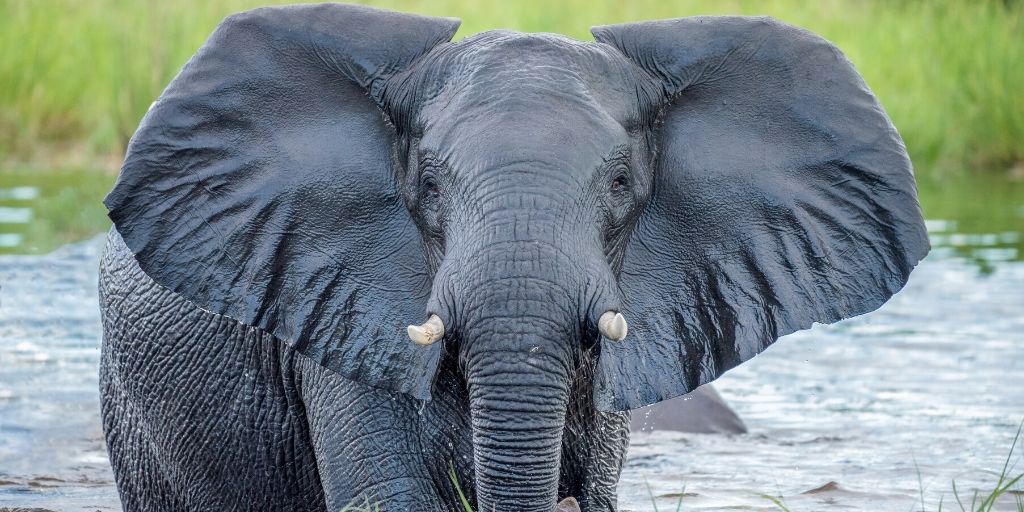
African elephants are the largest of the big five animals
The African elephant ( Loxodonta africana ) is the largest and heaviest land animal in the world, weighing up to 6 tonnes, and eating massive amounts of food each day.
Their distinguishing features include the dexterous trunk , large ears that cool the body when flapped, and elongated incisors in the form of tusks. There are actually two species of African elephant – the African bush elephant and the smaller African forest elephant. Both are herbivores that live in large groups, whilst the African bush elephant is the larger of the two species, and typically the species referred to as a member of the big five animals.
A bull elephant can be dangerous, as can herds or mothers with young elephants. Keep your distance from them, and if in a vehicle ensure that you have the means to drive away forwards – elephants can run faster than a car can reverse. An elephant flapping its ears, kicking up dust, and/or trumpeting is probably about to charge.
Group name: Herd
Size: Up to 3.3 meters tall, weighing 6,000kg.
Speed: Up to 40 km per hour.
Diet: Elephants are vegetarians, eating up to 160kg per day, made up of savannah grasses, bushes, small plants, fruit, twigs, tree bark, and roots. Read more about what elephants eat .
Range & Habitat: African Elephants are found across sub-Saharan Africa – from Mali in the north, through the central and west African forests, down to South Africa. They are adaptable animals, capable of surviving in many habitats, from lush wetlands to arid African deserts . Despite this, both species of African elephants are considered endangered species , and on the list of Africa’s most endangered animals .
Best places to see African elephants: Addo Elephant Park, South Africa, Chobe National Park , Botswana , Etosha National Park, Namibia , Hwange National Park, Zimbabwe , South Luangwa National Park, Zambia .
Read more about African elephants .
2. Cape Buffalo

A grumpy African buffalo
Weighing in at not too far short of a ton, the African buffalo ( Syncerus caffer ) has a reputation for being bad-tempered and dangerous. Whilst a solitary African buffalo is one of the most unpredictable safari animals (and dangerous, hence their inclusion in the term big five animals), they are usually a docile beast when in a herd… aside from their tendency to stampede en masse when alarmed.
Herds have clearly defined home ranges, the size of which is determined by the amount of food and water available.
Size: Up to 1.8 meters tall, and 800kg in weight.
Speed: They can run at speeds of up 57 kilometers per hour.
Diet: Cape buffalos are strictly herbivores and eat a wide variety of grasses, leaves, and other plants.
Habitat & Rage: Cape buffalo thrive in all sub-Saharan grasslands with access to water – from dry savanna to lowland floodplains.
Best places to see African Buffalo: Chobe National Park , Botswana , Katavi National Park, Tanzania , Kruger National Park, South Africa , Lower Zambezi National Park, Zambia.
Learn more about Cape Buffalo.
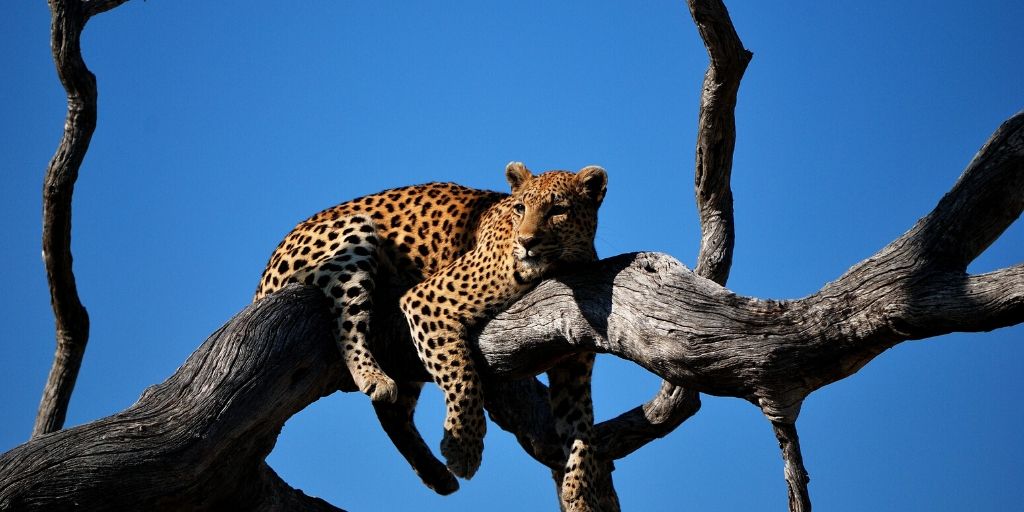
A stunning African leopard lounges in a tree in Kruger National Park, South Africa
Slightly smaller than their lion cousins, African leopards ( Panthera pardus ) are less rare than you might think, but rely on their animal camouflage and being active at night to stay hidden. Leopards are solitary, independent creatures, and rarely seen together except during mating, or a mother with cubs. As such they are totally self-reliant, and expert hunters – sometimes killing prey up to twice their size. During the daytime they often lounge around in trees and come to the ground after dark to hunt, taking their prey up into a tree to eat at their leisure.
Group name: Leap
Size: 1 meter high, weighing up to 100 kg.
Speed: 56 kilometers per hour.
Diet: Leopards are opportunistic carnivores and hunt a wide range of prey such as jackals , antelopes, gazelles , African monkeys , duiker, eland , impala , wildebeest , and more.
Range & Habitat: African leopards live in more places than any other types of big cat in Africa, and are comfortable in almost any habitat, including deserts, rainforests, woodlands, grassland savannas, mountain, scrub, and swamps. Leopards are one of the few big game species found outside national parks.
Best places to see Leopard: Londolozi Game Reserve, South Africa , Moremi Game Reserve , Botswana , Samburu National Reserve, Kenya, South Luangwa National Park, Zambia .
Learn more about leopards.

A male African lion and lioness relaxing
The African lion is the largest and most sociable of Africa’s cats , and one of Africa’s most dangerous animals . At up to 225kg, the lion ( Panthera leo ) really is the king of the savanna (it’s not a jungle animal !). Living in prides of up to 40 lions, it’s the lionesses who do all the hunting, usually sharing with the males of a pride. Lions are very territorial, and the females generally spend most of their lives within their home ranges.
If you encounter an African lion on foot don’t turn and run (easier said than done), as a running target that looks like prey will probably be viewed as such. Instead, try to make yourself look big, and back away gradually.
Group name: Pride
Size: 1.2 meters, weighing up to 225kg.
Speed: At a maximum speed of 80 kilometers per hour, the lion is the second fastest land animal in Africa .
Diet: African lions are apex predators and generally hunt the larger animals in their surroundings – buffalo, rhino, zebra, giraffe, and antelopes. Learn more about what lions eat .
Range & Habitat: Lions tend to prefer grassland, savanna, dense scrub, and open woodland. They are found across sub-Saharan African national parks, and also in a small part of north-east India.
Best places to see Lion: Kgalagadi Transfrontier Park, South Africa, Kruger National Park, South Africa , Maasai Mara National Reserve, Kenya , Ngorongoro Conservation Area, Tanzania , Okavango Delta, Botswana .
Read more about lions.
5. Rhinocerous

A white rhino walking in the bush
Once widespread through sub-Saharan Africa, the rhino has been hunted to the brink of extinction, and is probably the hardest of the big five to spot in the wild.
There are two species of rhinoceros in Africa – the critically endangered black rhino ( Diceros bicornis ) and the white rhino ( Ceratotherium simum ). Whilst white rhinos have made a comeback through conservation efforts across the continent, black rhinos are still very much one of Africa’s endangered animals . The fundamental differences between the white rhino and black rhino are not color, but rather size, temperament, food preference, and mouth shape. White rhinos have a flat, wide mouth, and their name comes from a mispronunciation of the Afrikaans word wide – “wijd”.
Both black rhinos and white rhinos tend to be wary of humans, but occasionally charge vehicles that get too close. If you’re on foot, then their bad eyesight should work in your favour – if they do charge you the apparent life-saving technique involves letting them get as close as possible, then stepping aside at the last second.
Group name: Crash
Size: 1.9 meters high and weighing up to 2,300kg
Speed: 50 kilometers per hour
Diet: All species of rhino are herbivores, grazing on a wide variety of fruits, stems, twigs, grasses, and leaves.
Range & Habitat: White rhinos are found throughout Asia and sub-Saharan Africa in habitats ranging from dense rainforests and swamps to grassy plains.
Best places to see Rhinoceros: Tends to be in Southern Africa – Etosha National Park , Namibia , Hluhluwe–Imfolozi Park, South Africa , Kruger National Park , South Africa, Lewa Wildlife Conservancy, Kenya , Mkomazi National Park, Tanzania.
Learn more about rhinos.
Best places to see all of the big five animals
Whilst we’ve highlighted national parks above to see each of the members of the big five animals, the ultimate thrill is to see all five animals on one safari. It’s not easy – not least because even if all five animals are present in an area they can still be very difficult to see! However, it is possible, as there are a number of hotspots in southern and east Africa that are rich in variety and can support an extremely dense wildlife population. Our top picks to see all of the big five together are:
- Chobe National Park, Botswana
- Etosha National Park in Namibia
- Kruger National Park in South Africa
- Londolozi Game Reserve in South Africa
- Maasai Mara National Reserve, Kenya
- Moremi Game Reserve, Botswana
- Ngorongoro Conservation Area, Tanzania
- South Luangwa National Park in Zambia
5 great quotes about each of the big five animals
Elephant quotes.

“They say an elephant never forgets. What they don’t tell you is, you never forget an elephant.”
Bill Murray
“Nature’s great masterpiece, an elephant; the only harmless great thing.”
“If anyone wants to know what elephants are like, they are like people only more so.”
Pierre Corneille
“He who mounts a wild elephant goes where the elephant goes.”
Randolph Bourne
Lion quotes

“Do not try to fight a lion if you are not one yourself.”
African proverb
“You know you are truly alive when you’re living among lions.”
Isak Dinesen
“Until the lion tells his side of the story, the tale of the hunt will always glorify the hunter.”
Zimbabwean proverb
“Lions make leopards tame.”
William Shakespeare
“In the jungle, the mighty jungle The lion sleeps tonight.”
Solomon Lina, “Mbube”
Leopard quotes

“At the top of the mountain we are all snow leopards. “
Hunter S. Thompson
“The leopard does not change his spots.”
King James Bible
“This world without a leopard…I mean, who would want to be here?! “
Diana Vreeland
“Leopard is an animal design, and my designs come from nature. “
Roberto Cavalli
“A leopard feels at home with leopard. “
George Eliot
Buffalo quotes
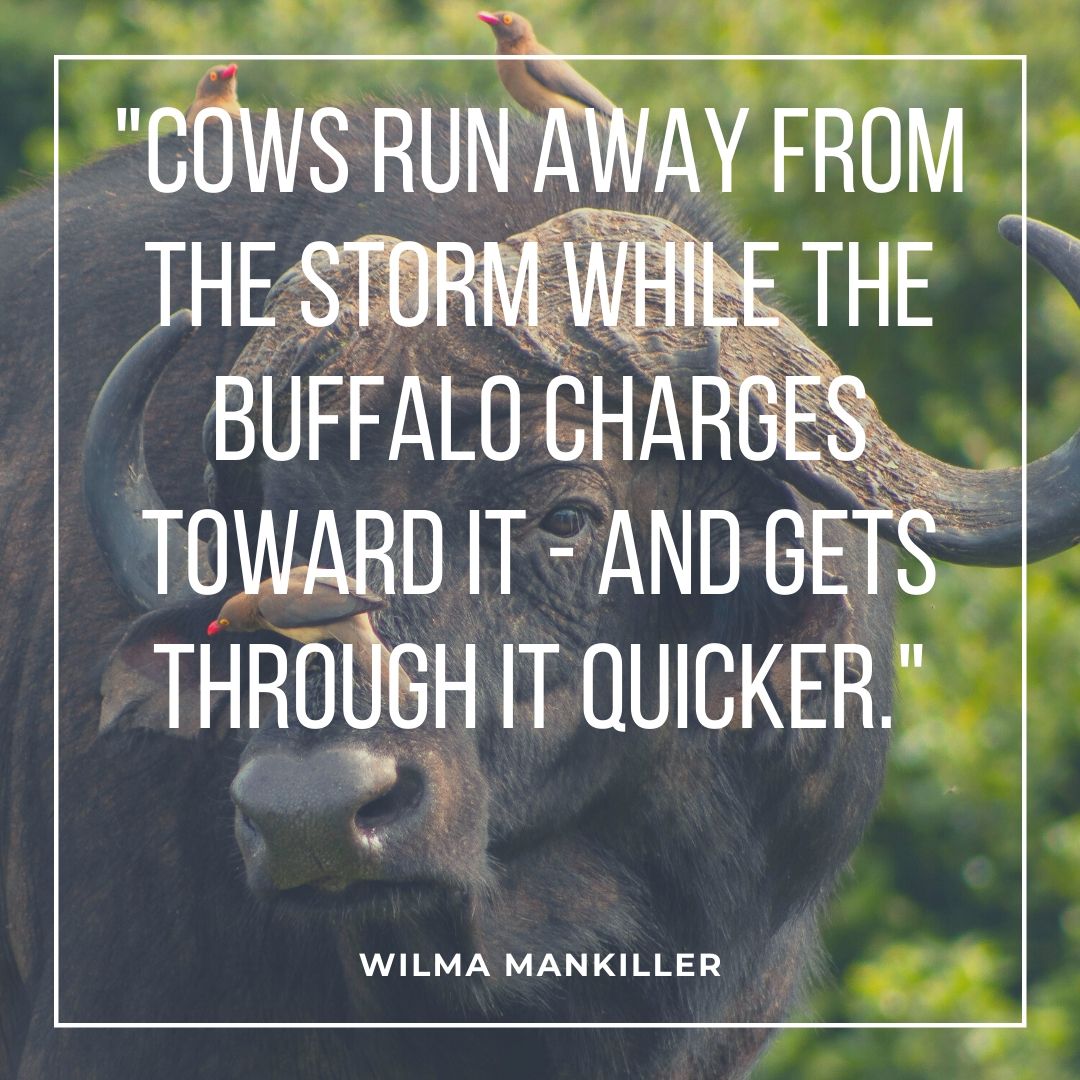
Cows run away from the storm while the buffalo charges toward it – and gets through it quicker. Whenever I’m confronted with a tough challenge, I do not prolong the torment, I become the buffalo.
Wilma Mankiller
The buffalo is a surprisingly stupid animal.
Ellsworth Huntington
So is the savage buffalo, especially delighting in dark places, where he can wallow in the mud and slake his thirst without much trouble
John Hanning Speke
At the rate science proceeds, rockets and missiles will one day seem like buffalo – slow, endangered grazers in the black pasture of outer space.
Bernard Cooper
The coat of the buffalo never pinches under the arm, never puckers at the shoulders; it is always the same, yet never old fashioned nor out of date.
Theodore Parker
Rhino quotes
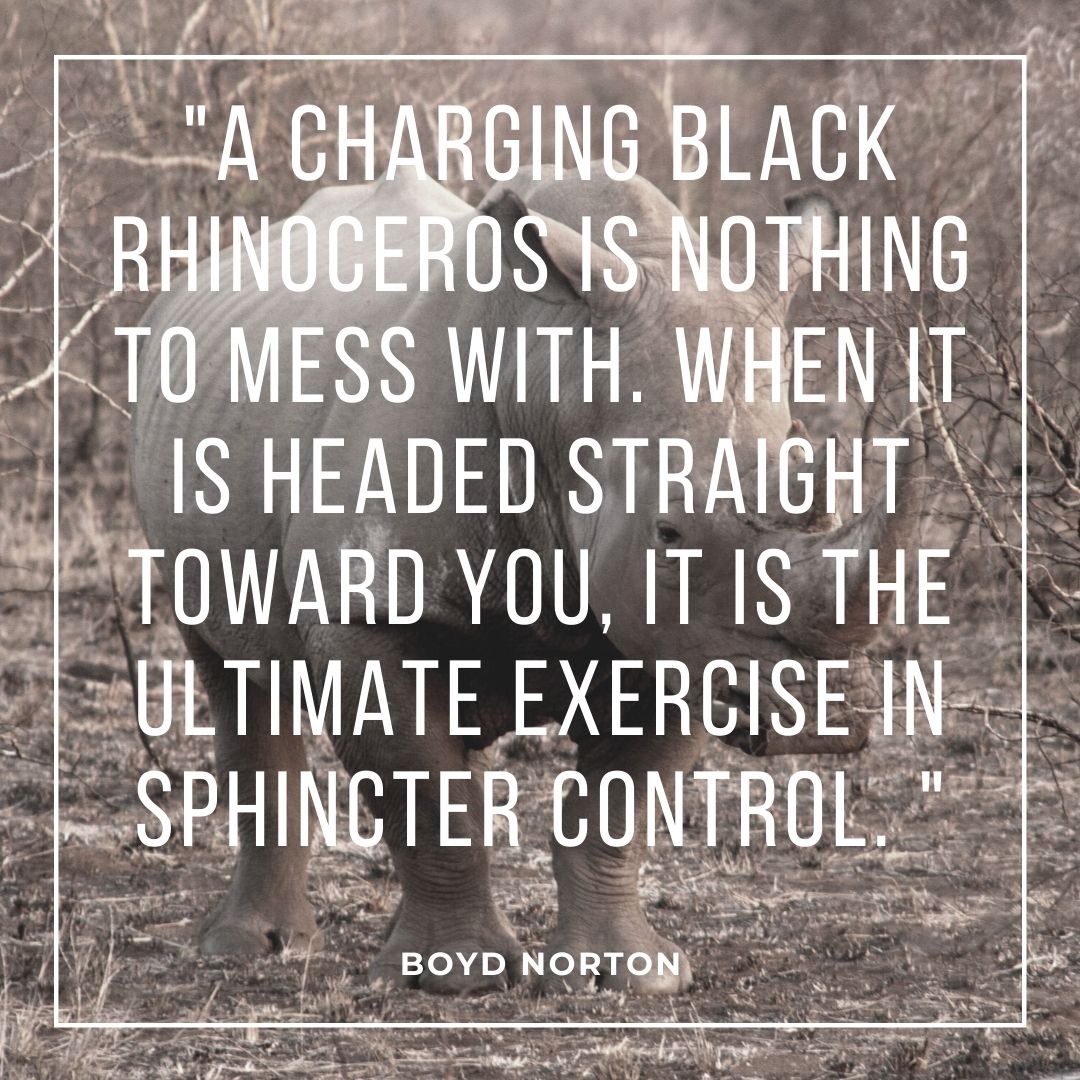
A charging black rhinoceros is nothing to mess with. When it is headed straight toward you, it is the ultimate exercise in sphincter control.
Boyd Norton
It is one thing to be amazed at gorgon or a griffin, creatures which do not exist; but it is quite another and much higher thing to be amazed at a rhinoceros or a giraffe, creatures which do exist and look as if they don’t.
G.K.Chesterton
The only way to save a rhinoceros is to save the environment in which it lives, because there’s a mutual dependency between it and millions of other species of both animals and plants.
David Attenborough
The rhinoceros stood about five hundred yards away, not a twentieth-century animal at all, but an odd, grim straggler from the Stone Age.
Winston Churchill
A rhinoceros is as ugly as a human being, and it too is going to die, but at least it never thinks that it is beautiful.
Peter S. Beagle
Other wildlife ‘fives’
Have you seen the big five animals and are are looking for a new wildlife challenge – other animals to hunt for your photo safari? For safari aficionados up for ticking all the ‘I’ve seen’ boxes, have you heard about the other groups of 5 animals?

World’s Ugliest Fish
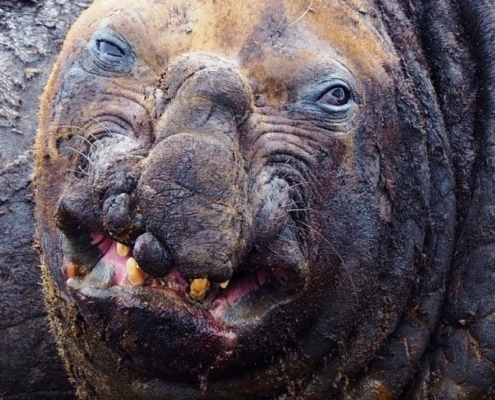
Ugly Animals
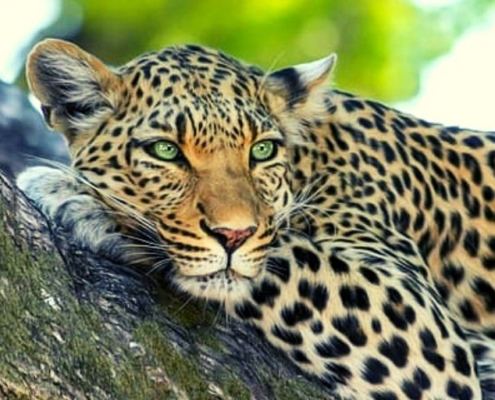
Best Places For The Big 5 In South Africa
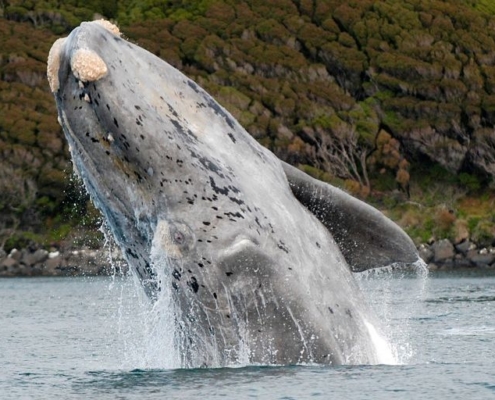
The Big Seven Animals – What They Are & Where To See Them
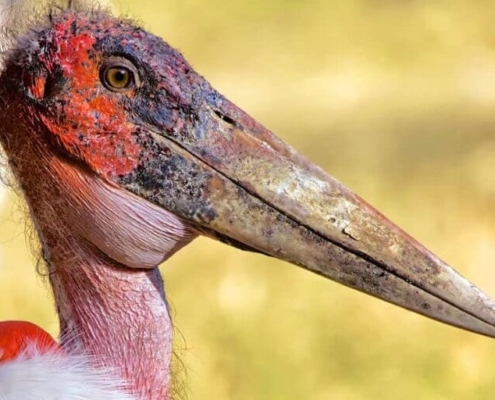
What Are ‘The Ugly Five’ Animals?
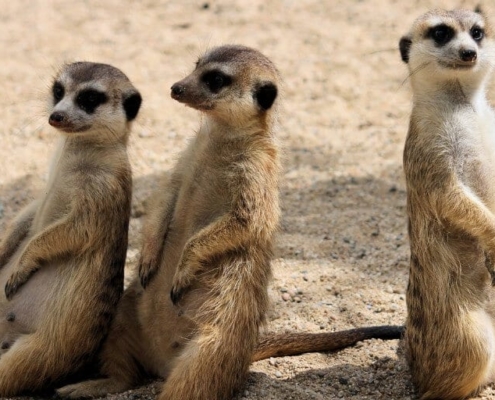
What Are ‘The Shy Five’ Animals?
Discover more of our wildlife posts…, guide to big cats of the world, the heaviest animals in the world, what are ‘the big five’ animals, 13 of the world’s rarest animals, the world’s largest flying birds, seal vs sea lion: how to tell the difference, the 11 fastest land animals on earth, facts about elephant musth.
I like the big five very much, but alittle bit surprised. The hippo i big than lion and leopard why is it not on the list. We heard that hippos are one of the animals which kills more people than elephants and rihnos
Hippos mainly live in the water, the Big Five live on land.
Hi Martin, the name is not everything! Hippos weren’t in the group of animals hunted for their skin or heads, so didn’t make the big five list ;)
The Big five are the animals that i love so much but they left the TIGER and its deserves to be on of them… if one could make them pets i’d long had one.
Unfortunately tigers are not native to Africa.
The big five is found all over Kenya and other parts of Africa.
Big five are found in Africa most distinctive in Tanzania, am proud of it.
My best animals are the big five
In my opinion the “Big Five” and all other wild animals wherever they are in the world should not be hunted down by big game hunters or poachers and the cowards who carry out these atrocities should themselves be hunted down and prosecuted to the fullest by the governments of those countries in which those activities occur.
Absolutely agree Eric – big game hunting is not something I can say I’m a fan of…
very useful to my resarch…
Glad to hear it Ryan ;)
Top countries for safaris
- Botswana safaris
- Kenya safaris
- Namibia safaris
- South Africa safaris
- Tanzania safaris
- Uganda safaris
Safari basics
- Safari animals
- How to find the right safari company
- When to go on safari
- What to take on safari
- Safari clothing – what to wear
- Safari rules & etiquette
- Wildlife spotting tips
Most read articles
- All about the ‘big five’ animals
- Collective nouns for animals
- Safari movies to watch before you go
- The world’s fastest land animals
- Apex predators
- 10 Fascinating African tribes
- The biggest animals in the world
- 17 Epic hybrid animals
- The world’s ugliest animals
- Why are flamingos pink?
Africa’s best game reserves
- Chobe National Park, Botswana
- Etosha National Park, Namibia
- Kruger National Park, South Africa
- Masai Mara National Reserve, Kenya
- Okavango Delta, Botswana
- Serengeti National Park, Tanzania

Session expired
Please log in again. The login page will open in a new tab. After logging in you can close it and return to this page.
30 African Safari Animals You Need To See (With Pictures)

Africa’s natural beauty is unmatched, luring you to gaze at the passive stride of a lioness that you forget to breathe and marvel at a giraffe’s tripod bent to water.
The continent’s jungles, savannahs, forests, and other natural habitats contain mysteries that even a wise man cannot understand.
Therefore, seeing one-tenth of these African animals would bring about an incredible safari escapade.
It would be impossible to find all of Africa’s wildlife species, prompting us to compile a list of thirty African safari animals you need to see, including lions, elephants, zebras, and antelopes, among others.
Each animal we will consider has its scientific name, geographical range, conservation status, and photo highlighted, with a description that features the best places to find them.
So come along with us as we explore the beautiful world of these animals you can see on an African safari.
African Safari Animals You Should See
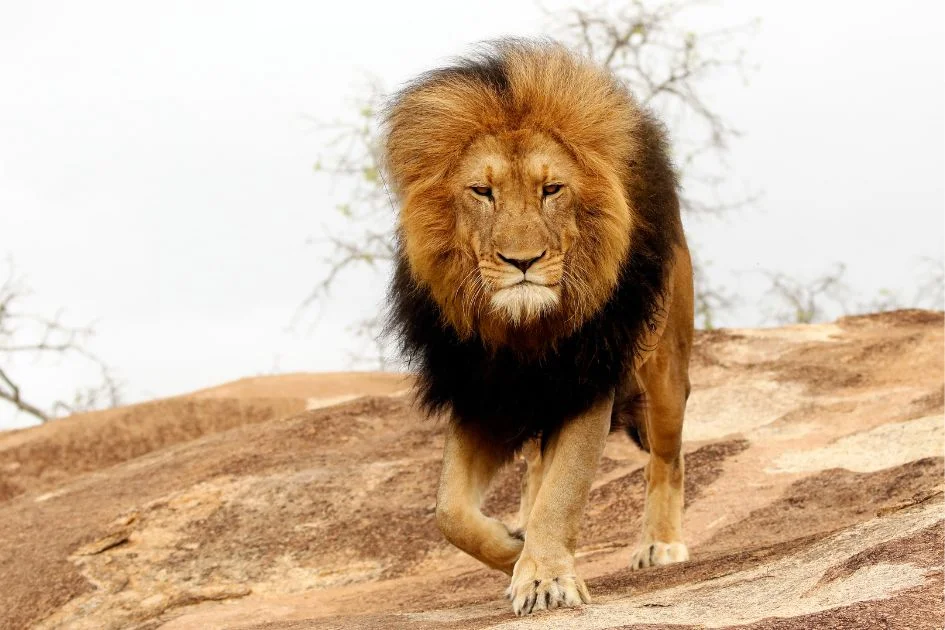
- Scientists Name: Panthera Leo
- Conservation Status: Vulnerable
Lions are endemic to Africa, occluding in savannahs, scrublands, grasslands, grassy plains, open woodlands with bushes, and bordering rivers.
Between 300 and 1,500 mm of annual rainfall, Savannahs constitute most African lion habitats.
Some populations reside in West African tropical moist forests and montane forests.
Sadly, Africa’s lion population has declined substantially by fifty percent in only twenty years. 1
However, one can still find lions in the Kgalagadi Transfrontier Park, South Africa, and Serengeti National Park, Tanzania.

- Scientific Name: Panthera pardus
- Conservation Status: Not Extinct
The leopard resides across sub-Saharan Africa and is aboriginal to many African nations.
These spotted cats inhabit the Cape Provinces of South Africa, Somalia, Ethiopia, and West Africa, occurring in mountainous forests, grasslands, and savannahs.
Leopards are among Africa’s “Big Five” safari, attracting many tourists; Zambia’s South Luangwa National Park and South Africa’s Sabi Sands Game Reserve are some of the most prominent leopard centers in the continent.
The Virunga National Park in the Democratic Republic of the Congo has recorded leopard sightings as the animals drink the park’s thermal waters.
3. Elephant
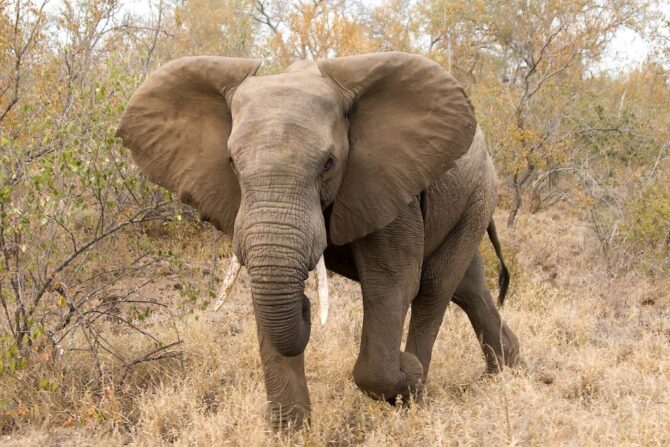
- Scientific Name: Loxodonta africana
- Conservation Status: Endangered
African elephants are considered endangered by the IUCN; still, they are indigenous to the continent, inhabiting the Sub-Saharan arid regions and Sahelian scrub.
They also reside in the continent’s jungles in tropical rainforests, mopane, and miombo woodlands.
African elephants primarily have populations in Central Africa.
Still, they exist in the Chobe National Park in Botswana, the Amboseli National Park in Kenya, East Africa, and the Hwange National Park in Zimbabwe, Southern Africa.
Also See: List of Animals with Big Heads (with Pictures)
4. Rhinoceros
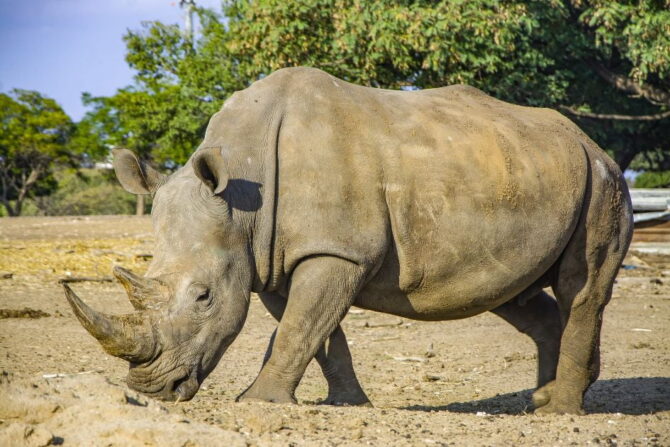
- Scientific Name: Rhinoceros
- Conservation Status: Critically Endangered
The black rhino species is endemic to Africa, living in its eastern and southern regions.
Rhino populations inhabited eleven countries, but most wild rhinos today, from the estimated six thousand, occupy only four countries — Zimbabwe, South Africa, Namibia, and Kenya.
They roam the open savannahs and grasslands and naturally exist in Etosha National Park, Namibia, Ziwa Rhino Sanctuary in Uganda, Nairobi National Park, Kenya, and Kruger South Africa.
Black rhinos have a size worthy of making them major African wildlife, growing up to 5.2 feet, and weighing 1,760 to 3,080 pounds.

- Scientific Name: Syncerus caffer
- Conservation Status: Near Threatened
Various species of the African buffalo occupy every part of the continent. The Cape buffalo inhabits Southern and East Africa, while the forest buffalo occurs in Central and West Africa.
These species are enormous, measuring up to 5.6 feet in shoulder height and weighing up to 1,900 lb.
They live in savannahs, swamps, mopane grasslands, and densely covered habitats.
Some wildlife parks include Masai Mara National Park in Kenya, Chobe National Park in Botswana, and Serengeti National Park in Tanzania.
6. Hartebeest
- Scientific Name: Alcelaphus buselaphus
- Conservation Status: Least Concern
The hartebeest is an antelope species native to the black continent.
It is a large-sized species with a prominent hump, a large chest, and a long face that distinguishes it from other antelope species.
Hartebeests are primarily grazers, with grasses making their menu, but they mostly occupy wooded grasslands, dry savannas, and open plains in Central, West, southern, and southeast Africa.
The hartebeest roams in their natural habitats in the Kruger and Bontebok National Parks in South Africa, Etosha National Park in Namibia, and Camp Linyanti in Botswana.

- Scientific name: Tragelaphus eurycerus
The bongo is another antelope species native to African jungles, with white-yellow stripes and black-and-white markings on its reddish-brown coat.
Bongos exist in tropical forest mosaics with dense undergrowth around West and Central Africa.
The Aberdare National park in Kenya is one major spot to find the bongo.
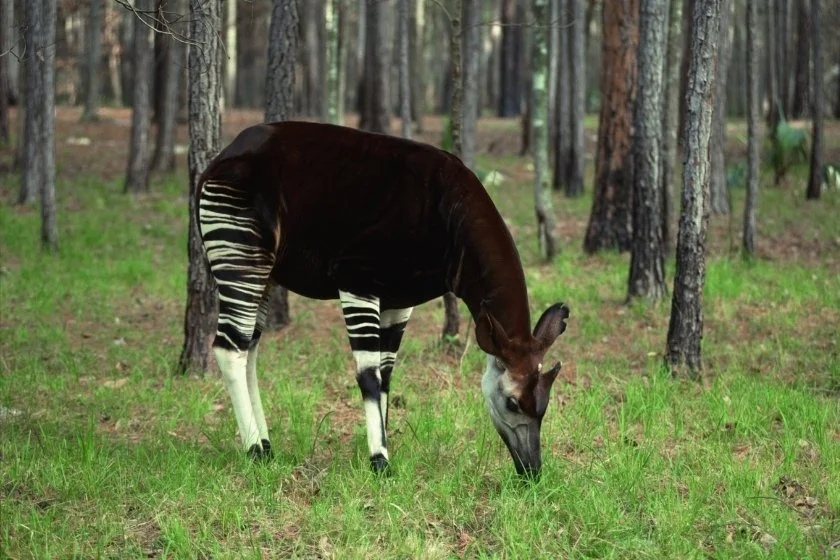
- Scientific name: Okapia johnstoni
- Conservation Status: Endangered
The okapi, a zebra look-alike, is the only extant member of the Giraffidae family along with the giraffe.
However, the okapi is not as tall as a giraffe, measuring only four feet and eleven inches.
It occupies canopy forests but is essentially solitary, with wildlife populations in the Okapi Wildlife Reserve, Ituri Rainforest, and Virunga National Park in the Democratic Republic of Congo.
9. African Wild Dog
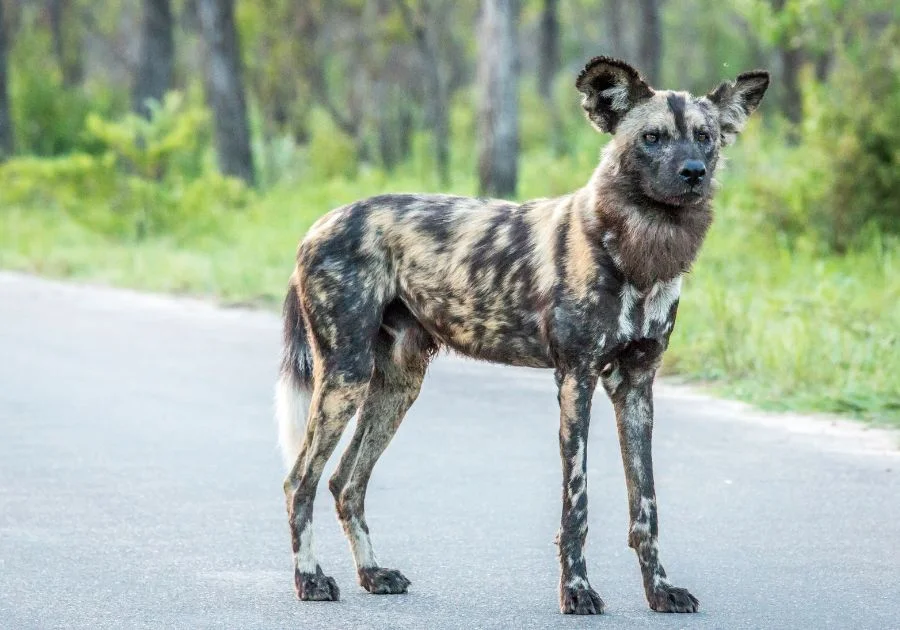
- Scientific Name: Lycaon pictus
The African wild dog is a threatened species now mostly located in the southeast of Africa, with only over 6,000 individuals left. 2
These wild dogs primarily inhabit Africa’s savannas and dry regions, preying mainly on antelopes.
African wild dogs have a strong sense of socialization to form packs of about thirty dogs.
The best places to find the African wild dog include woodlands, scrublands, and mountains, and they are open to the public in their natural habitats in:
- Madikwe Game Reserve in South Africa
- Mana Pools National Park in Zimbabwe
- Moremi Game Reserve in Botswana
- Selous Game Reserve in Tanzania
- South Luangwa National Park in Zambia
Also See: Different Types Of Wild Dogs (Species List With Pictures)
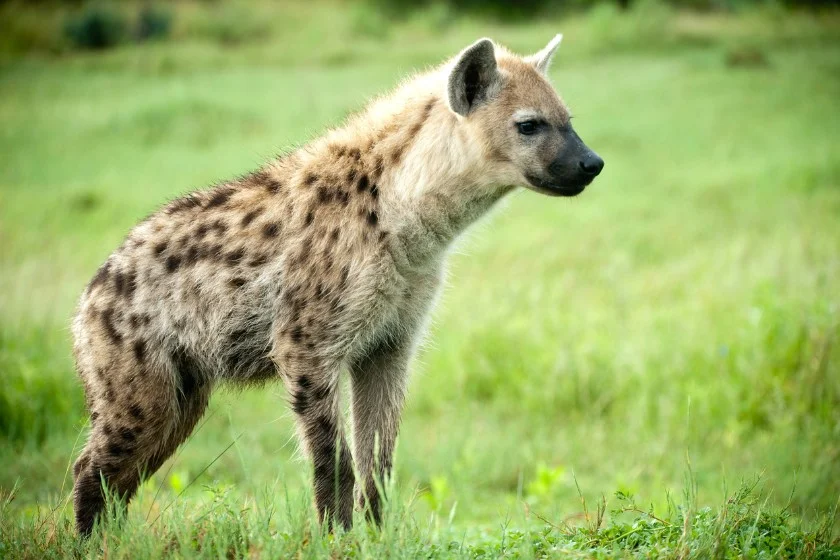
- Scientific Name: Hyaenidae
Hyenas occupy Africa’s savannas, sub-desserts, grasslands, forest edges, and woodlands and hold an apex position on the food chain.
Hyenas control prey populations and prevent the spread of diseases, primarily by consuming animal remains that could rot and cause diseases.
They have unparalleled bone-crushing abilities, helping them fight off potential competitors. 3
Hyenas may not be among the most beautiful animals, but they attract visitors around Kruger National Park and Pilanesberg National Park in South Africa.
11. Wildebeest
- Scientific Name: Connochaetes taurinus
The antelope’s imposing appearance is why the Afrikaans named it the wildebeest.
However, it is never too fearsome to the African wild cats, wild dogs, and hyenas that constantly prey on it.
Wildebeests are among the jungle animals in southern Africa that also occupy grassy plains and open woodlands that support their grazing routine in Angola, Botswana, South Africa, Mozambique, and Tanzania.
The Serengeti National Park in Tanzania and Masai Mara National Reserve in Kenya are some of the best places to watch the wildebeest.
12. Warthog
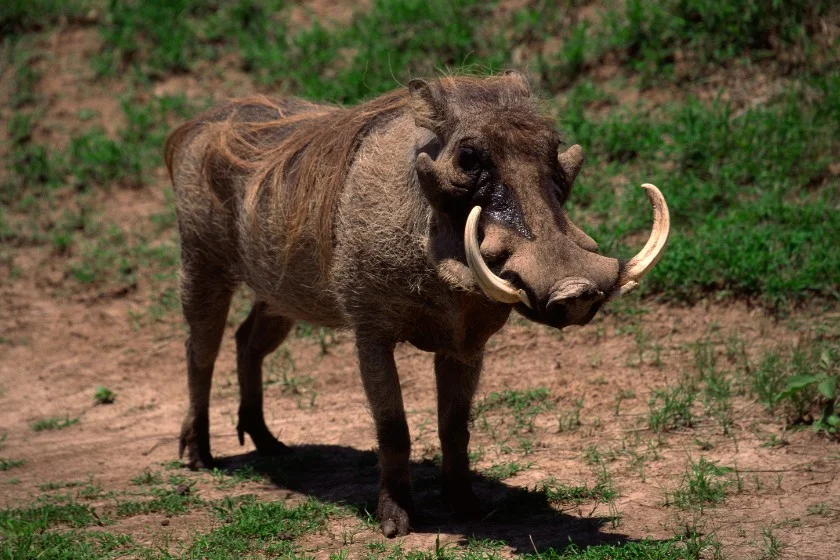
- Scientific Name: Phacochoerus africanus
The common warthog is a plump, hooved wild pig with little fur, a mane through the spine to the middle of its back, and upper tusks that protrude upwards from the mouth.
Warthogs, commonly called Pumba by many safari guides, are among Africa’s highly-watched safari animals.
They reside in grasslands, savannas, and woodlands in sub-Saharan Africa, across western, eastern, central, and southern Africa.
The Kruger National Park, South Africa, and Meru National Park, central Kenya, are famed for housing the warthog.
13. Vulture
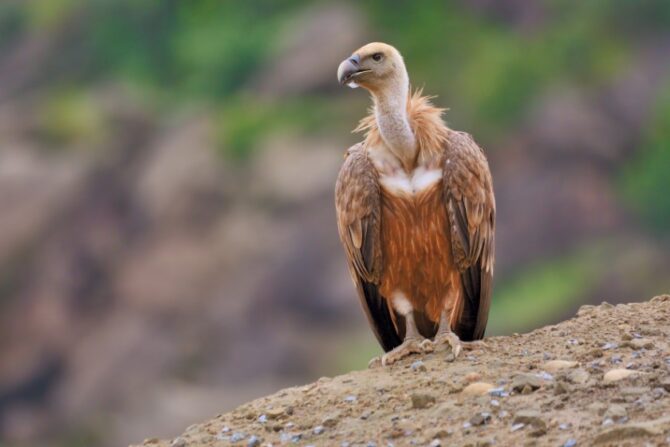
- Scientific Name: Accipitridae (Old World vultures); Cathartidae (New World vultures)
About eleven vulture species from the Accipitridae and Cathartidae families reside in Africa, popular among many as a scavenger and keystone species in most of the continent’s ecosystem.
Sadly, about seven of eleven African vulture species are critically endangered, with West Africa losing about ninety percent of the native White-backed vulture. 4
However, vultures spread across the black continent in west, north, east, central, and southern African cliffs and tall trees.
The Kruger National Park in South Africa and Comoé National Park have vultures, and one might be fortunate to find one while visiting.
Also See: African Birds: 30 Amazing Safari Bird Species, With Pictures
14. Marabou Stork
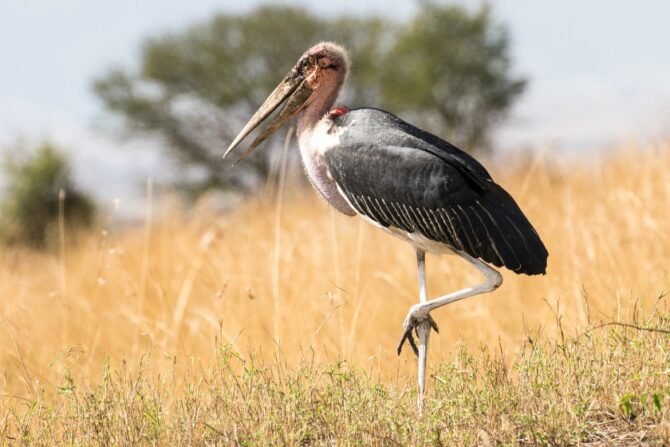
- Scientific Name: Leptoptilos crumenifer
While most storks are beautiful, the marabou stork has a reputation for horror due to its black cloak, large, fleshy pouch, and featherless features.
However, even the world’s most unattractive creatures attract large fanbases, explaining why the marabou stork ranks among Africa’s safari animals you should see.
Marabou storks are also large birds, reaching four feet, eleven inches in height, and 6.5 feet in wingspan length.
The IUCN ranks these birds as ‘Least Concern,’ with a stable population to support their evaluation.
Therefore, one can find the marabou stork in the west, east, central, and southern Africa.
One can find the marabou stork in Ben Lavin Nature Reserve and the African Bird of Prey Sanctuary in South Africa.
- Scientific name: Beatragus hunteri
The hirola is the world’s rarest antelope, native to Kenya and southwest Somalia.
White spectacles around its eyes, a white tail through to the hocks, and lyre-shaped horns are distinctive features that distinguish the hirola from other antelope species.
The hirola occupies parched environments with relatively low annual rainfall.
However, it is a primary grazer, enjoying grasses with more leaves than stems. Hirola populations exist in Tsavo East National Park, Kenya.
16. Giraffe
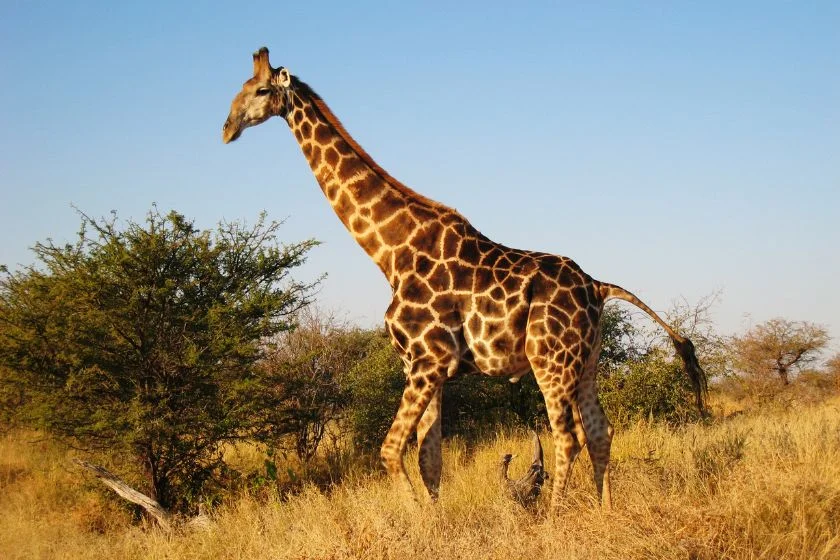
- Scientific Name: Giraffa camelopardalis
- Conservation Status: Vulnerable
Everyone wants to watch the world’s tallest living terrestrial and largest ruminant creature.
Giraffes occupy semi-arid savannah and savannah woodlands and are highly distinguished by their extremely long necks and legs.
Some best places to find the Giraffe in its natural habitat include:
- Africa’s Murchison Falls National Park in Uganda
- Etosha National Park in Namibia
- Serengeti National Park in Tanzania
- Maasai Mara National Reserve in Kenya
- Kruger National Park in South Africa
- Kouré in Niger
Also See: Amazing Long Neck Animals (List With Pictures)

- Scientific Name: Equus
Three zebra species reside in Africa, but the common zebra is the most popular. They all share black-and-white striped coats, but patterns are unique to each species.
The common zebra ( Equus quagga ) occupies much of southern and eastern Africa, the mountain zebra ( Equus zebra ) in southern Africa, and the Grévy’s zebra ( Equus grevyi ) in east Africa.
Zebras are herbivores and inhabit grasslands, savannahs, shrublands, woodlands, and mountainous areas.
The best places to find Zebras in their natural habitats include:
- Makgadikgadi Pans in Botswana
- Lewa Conservancy in Kenya
- Klein Karoo in South Africa
18. Hippopotamus

- Scientific name: Hippopotamus amphibius
Hippos are famed for their round and cute appearance and a fearsome reputation for being the world’s deadliest land mammal, killing an estimated 500 people annually in Africa.
They weigh up to 2,750kg, with large tusks and speeds reaching 30 km/h. Hippos are everywhere in the black continent, occurring in Central, Eastern, and Southern Africa.
The hippo’s history with man implies that encountering it in the wrong place might not end well.
However, the South Luangwa and Lower Zambezi National Parks in Zambia, Okavango Delta in Botswana, and Selous in Tanzania are among the best places to view the hippopotamus.
19. Common Ostrich

- Scientific Name: Struthio camelus
The common ostrich is the world’s largest and heaviest extant bird . However, such feats make the bird incapable of flight due to its immense weight.
However, the common ostrich makes up for its lack of light with speed, running up to forty-three kilometers per hour.
They are also impressive with using their long, powerful legs as defensive weapons.
A mature ostrich can grow to a height of nine feet and weigh up to 160 kilograms, a size worthy of ranking among African Safari animals one should see.
Many zoos feature ostriches in captivity, but the Kidepo Valley National Park in Uganda and the Kruger National Park in South Africa are nice places to find the common ostrich in their natural settings.
20. Shoebill
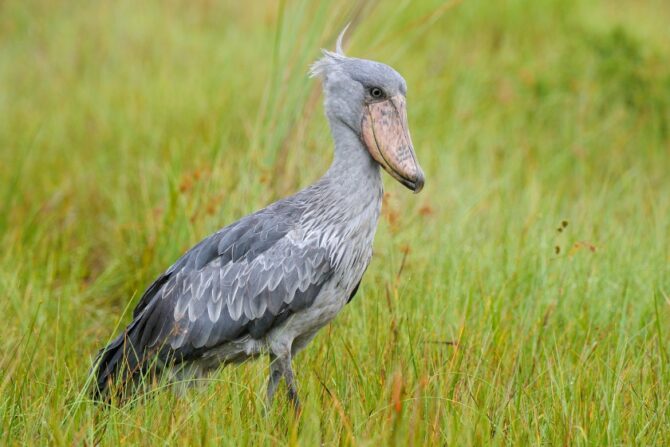
- Scientific Name: Balaeniceps rex
The bird’s large, striking shoe-shaped beak earns it the distinguished name. However, its enormous bill is just one of its features.
The shoebill is one of the world’s largest birds, growing up to four feet, eleven inches, thus becoming one of the five most captivating birds in Africa, according to birdwatchers.
The shoebill can be found in the Murchison Falls National Park in Uganda, Kasanka National Park in Zambia, and a few wildlife centers in the continent present views of shoebill storks.
21. Leopard Tortoise
- Scientific Name: Stigmochelys pardalis
The leopard tortoise is one of the smallest wildlife Africa’s safari offers. However, the leopard markings on its shell account for the most prominent feature.
The leopard tortoise has populations scattered across Africa’s semi-arid shrubland of the Sahara, from Sudan to the cape of South Africa.
The tortoise’s leopard markings are not its only distinctive feature, but its ability to swim is unique as it is the only Testudinidae with such an ability.
The Serengeti National Park in Tanzania and Mountain Zebra National Park in South Africa are wonderful destinations to find the leopard tortoise.
22. Meerkat
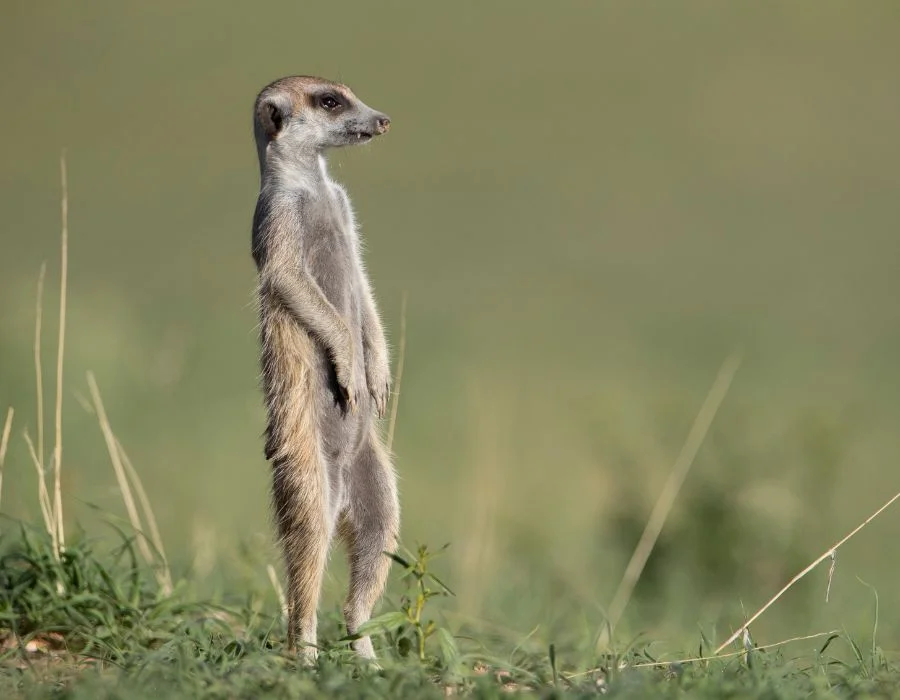
- Scientific Name: Suricata suricatta
Mongooses are popular for killing snakes, and here is the meerkat, an animal belonging to the same family — Herpestidae.
The meerkat is a small mongoose native to Southern Africa, inhabiting arid, open habitats containing little woody vegetation in Namibia, Botswana, and South Africa.
Mongooses have a distinctive banded pattern, big eye circles, thin tails, and sharp, curved foreclaws that support digging.
They dig burrows in the Kgalagadi Transfrontier Park and Tswalu Kalahari Reserve in South Africa.
- Scientific Name: Tragelaphus
- Conservation Status: Least Concern
The kudus are two large-sized antelope species found in East and Southern Africa.
The most distinctive feature differentiating both species is size, with the greater kudu measuring over five feet and the lesser kudu within the four-foot range.
They inhabit savanna near Acacia and Commiphora shrubs, relying on thickets for protection.
Therefore, these antelopes are found in the Addo Elephant National Park and Hluhluwe-Imfolozi Game Reserve in South Africa, Chobe National Park in Botswana, and Etosha National Park in Namibia.
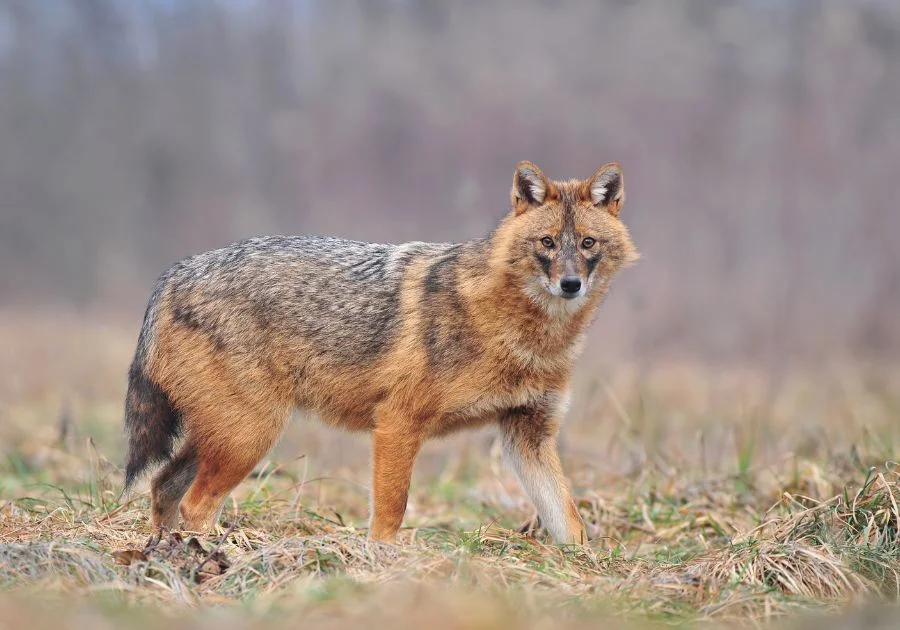
- Scientific Name: Canis aureus
Jackals are dog relatives of the genus Canis. Three jackal species exist — black-backed, golden, and side-striped, all occurring in different parts of Africa, especially the eastern and southern countries.
The black-backed jackal inhabits savannas and wooded areas; the golden jackal occupies dry environments, including deserts, open savannas, and arid grasslands.
The side-striped jackal lives in damp savannas, marshes, bushlands, and mountains.
Visiting the Kruger National Park, Shongweni Resources Reserve, and the wildlife parks offers the intriguing sights of jackals in South Africa.
The Tsavo West National Park in Kenya, Chobe National Park in Botswana, and Etosha National Park in Namibia are other nice places to find a jackal.
25. Cheetah
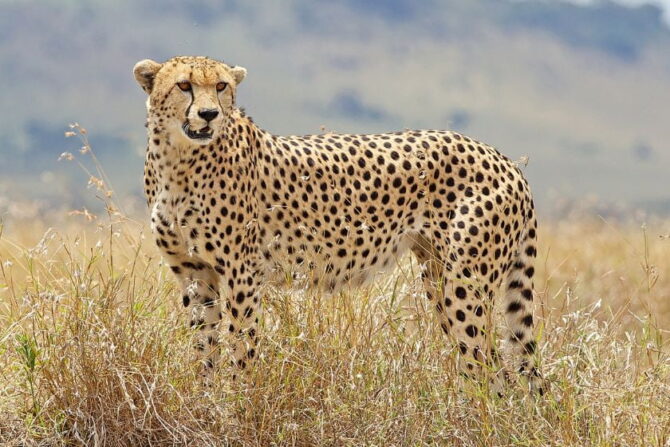
- Scientific Name: Acinonyx jubatus
Watching the world’s fastest land animal stalk its prey and initiate its signature high-speed chase is a dream sight to anyone willing to enjoy the untamed beauty of the African safari.
Therefore, some of the best places to watch a cheetah in your next safari escapade include:
- Okavango Delta in Botswana
- Phinda Private Game Reserve in South Africa
- Phinda Private Game Reserve in Tanzania
- Kidepo Valley National Park in Uganda
- Kafue National Park in Zambia
- Scientific Name: Aepyceros melampus
The Impala is one of the most elegant antelope species, featuring a graceful stride, plush, glossy, reddish brown coat, and slender, curved horns.
While you might love to admire them, it will be more thrilling to watch them jump clear of obstacles, leaping up to ten meters long and three meters high.
Such a sight lies in the Lake Mburo National Park and Katonga Wildlife Reserve in Uganda, Kruger National Park, Hluleka Nature Reserve in South Africa, and Masai Mara National Reserve in Kenya.
27. Waterbuck
- Scientific Name: Kobus ellipsiprymnus
It would help if You never get tired of seeing antelopes if you visit Africa for its safari.
The waterbuck is among the many antelope species you may find, especially if you cruise through Chobe National Park in Botswana, Serengeti National Park in Tanzania, Kruger National Park in South Africa, or Lake Nakuru National Park in Kenya.
Waterbucks are large, robust antelopes with reddish-brown to shaggy gray coats that become darker with age.
As the name suggests, the waterbuck depends on water, thus inhabiting areas close to water sources.
28. Kori Bustard
- Scientific Name: Ardeotis kori
- Conservation status: Near Threatened
Kori bustards are very large birds — the heaviest flying bird native to Africa. Male kori bustards weigh between seven and eighteen kilograms.
The male kori bustard’s wingspan ranges from seven feet seven inches to nine feet.
Even though they have large wings, they do not frequently fly unless necessary.
Therefore, there is much to admire in this feathered giant, bringing you to the Etosha National Park in Namibia and the Serengeti National Park in Tanzania, where it occupies sparsely wooded savannas and open grasslands.
29. Nile crocodile

- Scientific Name: Crocodylus niloticus
- Conservation status: Least Concern
Some insects and amphibians might be insignificant during a safari escapade, but not large reptiles and apex predators like the Nile crocodile.
The crocodile occupies various habitats, including rivers, lakes, and marshes, and earns a fearsome reputation for its size, fearlessness, and extremely powerful bite.
One can find the Nile crocodile in Serengeti National Park in Tanzania, Maasai Mara National Reserve in Kenya, the Okavango Delta in Botswana, and Murchison Falls National Park in Uganda, among others.
30. Grey-crowned Crane
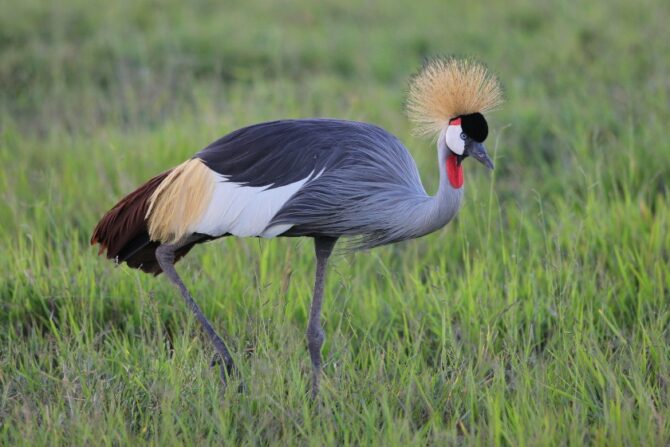
- Scientific Name: Balearica regulorum
- Conservation status: Endangered
The large, attractive bird, growing over three feet in height, with plush blueish-gray plumes and a golden crest, would be one of the most majestic creatures to see on one’s African safari.
The grey-crowned crane primarily inhabits dry savannas in Sub-Saharan Africa but could occur in cultivated areas and grassy flatlands in Kenya, Uganda, and South Africa.
The Amboseli and Lake Nakuru National Parks in Kenya and the Serengeti in Tanzania.
Also See: Beautiful Birds With Mohawks (With Pictures)
Frequently Asked Questions
What animals feature on africa’s top safari.
Africa’s safari features several animals, but lions, rhinos, leopards, elephants, and buffalos are the continent’s top-five safari animals.
Some of the world’s most popular animals, including zebras, cheetahs, giraffes, and antelopes, also feature on an African safari.
Would you see a tiger on an African safari?
While Africa is home to some of the world’s largest wild cats, including lions and cheetahs, it is very unlikely to find a tiger that is not in captivity in Africa.
However, one can find the tiger in a zoo or special reserve; the Laohu Valley Reserve, Tiger Canyon, Jugomaro Predator Park, and Pilanesberg National Park in South Africa are some places to find the world’s largest wild cat.
What is the most common animal on the safari?
The lion tops most people’s wishlists of animals to find on a safari. Without a doubt, it is one animal almost everyone coming on a safari would want to see, thanks to the beast’s title as the king of the jungle and the continent’s top carnivore.
What is the largest safari animal?
Lions, giraffes, hippos, and buffalos are in contention for Africa’s largest safari animals, but they do little to match the African bush elephant ( Loxodonta africana ).
The mammal can grow up to 13 feet and weigh almost 23,000 pounds, more than any other safari animal.
What African habitats support wildlife?
Most African habitats support wildlife, including savannas, rainforests, semi-deserts, wooded grasslands, deserts, and plains, because they have the perfect climate and terrains to support specific animals.
One might never get enough of Africa’s scenic terrains and the breathtaking explorations of its safari.
However, various challenges, including habitat degradation, human activities, and climate change, pose considerable threats to the survival of several African safari animals, driving some of these species to extinction.
Therefore, it will be more helpful for all to support conservation efforts to ensure the continuity of the continent’s beauty of undomesticated animals.
References & Notes
- Bauer H., Chapron G., et al. 2015. Lion (Panthera leo) populations are declining rapidly across Africa, except in intensively managed areas . PNAS.
- Alexis Valdes. 2018. Painted Ferocity: The Social Behaviors of African Wild Dogs, Threats to Survival, and Resulting Conservation Initiatives [pdf] . Liberty University.
- Binder W., Valkenburgh V. B. 2000. Development of bite strength and feeding behavior in juvenile spotted hyenas (Crocuta crocuta) . Journal of Zoology.
- White-backed Vulture Gyps africanus . BirdLife International.
Related Posts:
- African Birds: 30 Amazing Safari Bird Species, With Pictures
- 310+ Unique Monkey Names (Famous, Cute, Funny, Creative)
- Black And White Birds (30 Species, With Pictures)
- Types Of White Birds (30 Beautiful Species, With Pictures)
- 20 Most Beautiful Birds In The World & Where To Find Them
- Types Of Yellow Birds (31 Stunning Species, With Pictures)
About The Author
Jake Wilson
Related posts.

7 Interesting Animals in Jamaica
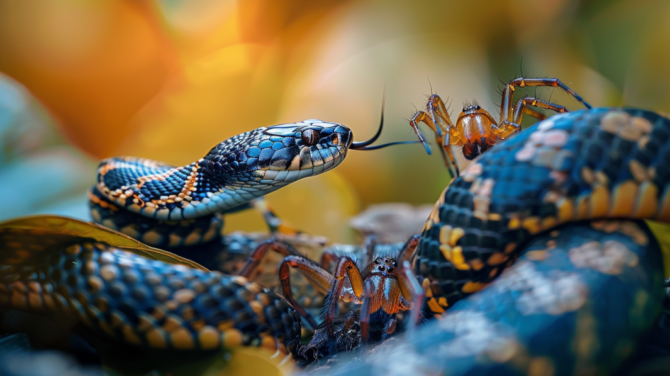
10 Common Dangerous Animals In Ohio

What Does A Black Wolf Symbolize?
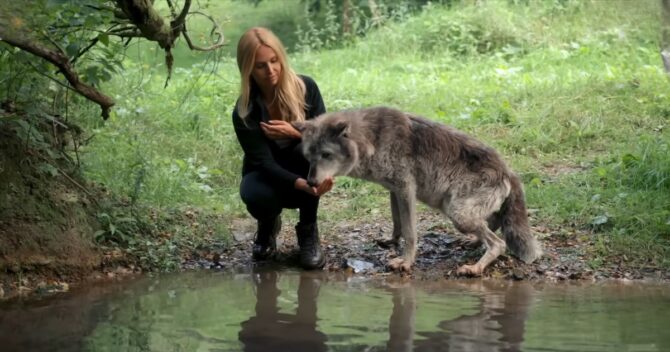
What Is A Female Wolf Called? – Unveiling Wolf Terminology and Behavior

A Guide To Animals That Are Not Mammals
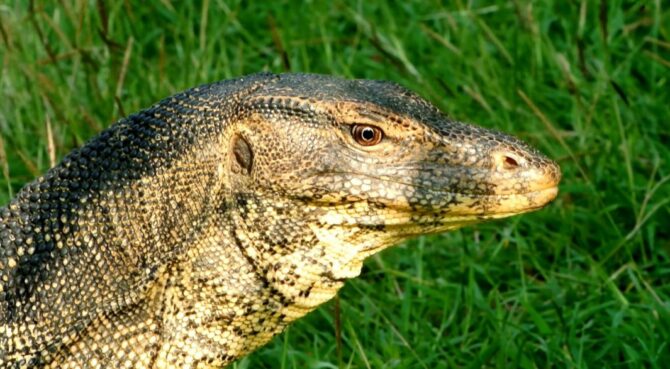
10 Common Dangerous Animals In Thailand You Need to Avoid
TOP DESTINATIONS
- Kruger Park
- Okavango Delta
- Serengeti National Park
- Victoria Falls
TOP COUNTRIES
- South Africa
TRAVEL DEALS
View All Travel Deals
SOUTHERN AFRICA
East africa, indian ocean islands, top experiences.
- Beach Holidays
- Family Safaris
- Honeymoon Safaris
- Desert Safaris
- Luxury Rail Safaris
- Multi-Generational Safaris
- Positive Impact Safaris
- Photographic Safaris
- Walking Safaris
WILDLIFE SAFARI
- Big Five Safaris
- Birding Safaris
- Gorilla Trekking Safaris
- Migration Safaris
- Mobile Camping Safaris
- Horseback Safaris
FEATURED EXPERIENCES
Comfort levels, property types.
- Tented Camps
- Boutique Hotels
Featured Safari Collections
- Elewana Collection
- Natural Selection
- The Safari Collection
- Saruni Basecamp
- Desert & Delta
GET TO KNOW US
- Meet The Team
- Pricing Explained
- Traveller Reviews
- Traveller Stories
- Why Book With Us?
- HerdTracker
- Safari Cost Calculator
- South Africa In 360
- Trusted Safari Partners
What are you looking for?
- Safaris & Tours
Destinations
Experiences.
- Accommodations
- Why book with us?
Hello traveller!
It's in Cape Town now.
We're sorry. Our safari planners aren't available now. Our office hours are 08:00 - 19:00 (GMT+2).
Call us to speak to an experienced safari planner.
Alternatively, we recommend...
Schedule a phone or Zoom call with one of our safari planners
Complete our travel enquiry form to connect with a safari planner
99 Best Africa Lion Safaris for 2024/2025
Comfort level, trip length.
99 match of 209
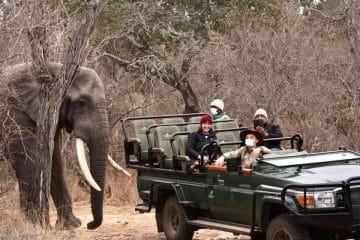
Greater Kruger Safari Short and Sweet
From $ 1360 /USD

Affordable Sabi Safari
Southern Africa South Africa Sabi Sands
From $ 1490 /USD
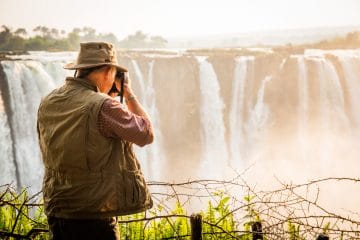
Livingstone Discovery
Zambia Livingstone Victoria Falls
From $ 1570 /USD
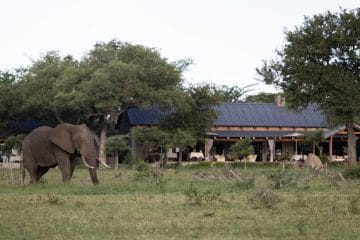
Timbavati Safari Short and Sweet
Southern Africa South Africa Johannesburg Timbavati
From $ 1850 /USD

Affordable South Luangwa Safari
Zambia South Luangwa
From $ 1890 /USD
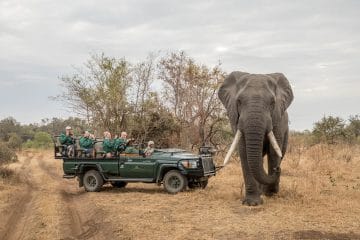
Affordable Greater Kruger Safari Combo
Southern Africa South Africa Timbavati
From $ 1900 /USD
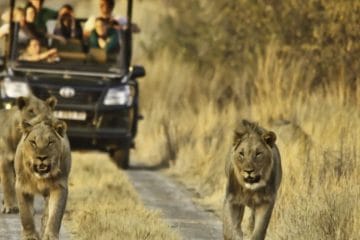
Kruger Park Safari
Southern Africa South Africa Kruger National Park
From $ 2100 /USD
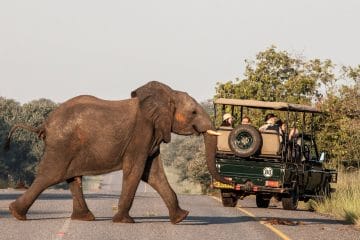
Victoria Falls and Chobe National Park Discovery
Zimbabwe Victoria Falls Botswana Chobe Chobe River Southern Africa
From $ 2130 /USD
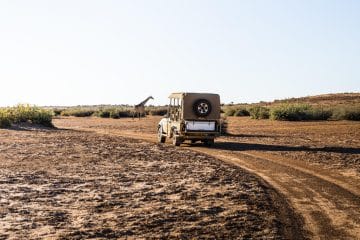
Namibia Highlights Group Tour
Southern Africa Namibia Sossusvlei Damaraland Etosha Swakopmund
From $ 2290 /USD
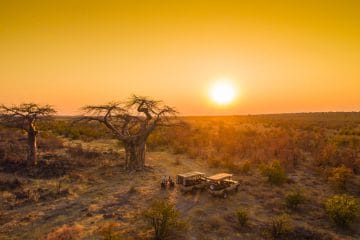
Elephant Kingdom with a Chobe – Savute Safari
Southern Africa Botswana Chobe Savuti
From $ 2500 /USD
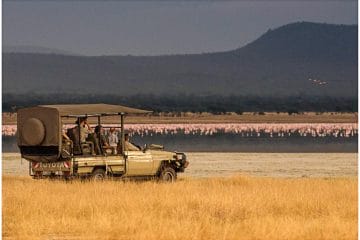
Highlights of Tanzania Group safari
East Africa Tanzania Safaris Lake Manyara Serengeti Ngorongoro Crater
From $ 2600 /USD
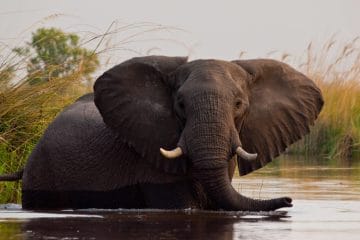
Value For Money Botswana Safari
Botswana Chobe Chobe River Moremi Southern Africa Okavango Delta
From $ 2740 /USD
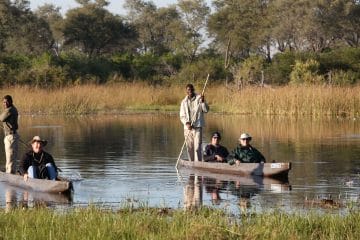
Botswana Mobile Safari
Botswana Moremi Okavango Delta Southern Africa
From $ 2745 /USD
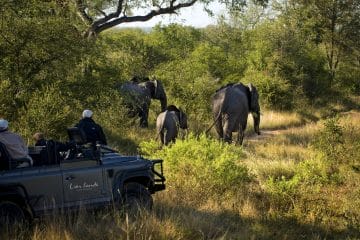
Luxury Kruger Park Safari
From $ 2800 /USD
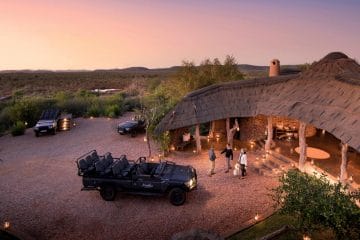
Malaria-Free Big 5 Safari in Madikwe
Southern Africa South Africa Madikwe
From $ 2880 /USD
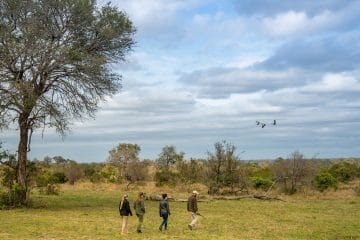
Sabi Sands and Kruger Safari
From $ 2950 /USD
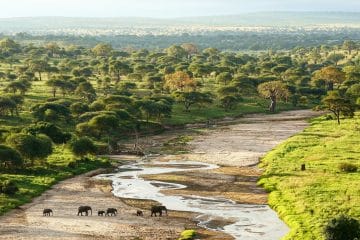
Budget Safari Bliss: Exploring Tanzania's North...
Tanzania Safaris Tarangire Ngorongoro Crater Lake Manyara
From $ 2980 /USD
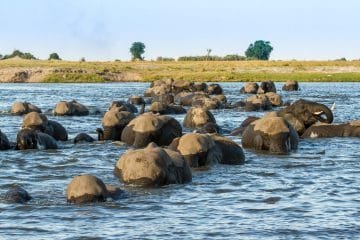
Victoria Falls, Chobe and Moremi Affordable Safari
Southern Africa Zimbabwe Victoria Falls Botswana Chobe Okavango Delta
From $ 3200 /USD
We offer a wide range of safari tour packages to suit every budget and preference. Whether you’re looking for a luxury safari experience or a budget-friendly adventure, we’ve got you covered.
Our safari vacation packages are designed to give you the best possible wildlife viewing experience. We offer tailor-made tours that can be customized to fit your specific needs and preferences. Whether you want to go on a traditional safari drive, a walking safari , or a combination of both, we can create a package that’s perfect for you.
If you’re new to safari tours and aren’t sure where to start, we offer a range of pre-designed safari packages to choose from. These packages include everything from luxury safari accommodation and transport to meals and activities, so you can sit back and relax while we take care of the details.
Our team of expert safari guides have extensive knowledge of the local wildlife and habitats, and they’ll be with you every step of the way to ensure you have a safe and enjoyable experience. We also work with a network of trusted partners to provide you with the best possible service and value for money.
If you’re looking for something truly unique and special, we offer tailor-made safari packages that can be customized to fit your specific needs and preferences. These safari tour packages are perfect for those who want to create their own dream safari experience.
Whether you’re an experienced safari-goer or a first-timer, we have something for everyone. So why wait? Start planning your dream safari adventure today and let us take you on an unforgettable journey through the breathtaking landscapes and diverse wildlife of Africa. So, these are the Safari Packages, Tailor-made Packages, and Tailor-made Tours we offer. Thank you for choosing us as your preferred safari tour partner.
What Our Guests Have to Say?
Read recent reviews from travellers who have planned and booked their trips with us.
8 Day Cape Town & Lalibela Safari Review
Rachel, United Kingdom 16 Nov 2023
Great journey through namibia.
Namibia Safari Review
Kristel, Belgium 15 Sep 2021
Antoinette is not only kind and attentive, but truly wonderful.
Kruger & Sabi Sand Safari Review
Michelle, United States 17 Jun 2021
Memorable trip to namibia - fantastic accommodations.
Namibian Safari Review
Kristen R., United States 20 Aug 2018
A most memorable adventure..
The Amazing South African Adventure Review
Margery, United States 04 Jul 2016
Our wedding planning ran so much smoother with discover africa..
A Wedding Safari Review
Dorinda & Charl, South Africa 01 Mar 2013
Speak to an expert safari planner.
Schedule a video or phone call with one of our African Safari Experts to plan a tailor-made tour around your interests, wishes and budget.

Ready to plan a tailor-made safari?
Enquire now and a Travel Expert will get back to you within 24 hours.
Registered Members of these Organizations

USEFUL LINKS
- Safari Tours
- Accommodation
- Why Book with us?
- Safari Cost Estimator Tool
- Wildebeest Migration
- Privacy Policy
- Website Terms of Use
POPULAR COUNTRIES
- View All Countries
POPULAR DESTINATIONS
- View All Destinations
- Cape Town Holidays
- Kruger National Park
- Etosha National Park
- Chobe National Park
TRAVEL BLOGS
- Travel News Digest, 7 June: SA named friendliest country in the world, Tiffindell closes permanently, and more
- Qatar Airways adds New Africa Gateway to DRC
- Travel News Digest, May 31: Tanzanian tourism industry on the up, OR Tambo is Africa’s busiest airport, and more
- Africa Hits Full International Tourism Recovery, as Seasonality Shift
- Travel News Digest, May 24: AU Passport Call Intensifies, Fuel Price Cuts expected in June
OUR LOCATION
- 2nd floor, Tygervalley Chambers One, 27 Willie van Schoor Avenue, Bellville, Cape Town , 7530
15 Animals to See on an African Safari
:max_bytes(150000):strip_icc():format(webp)/DSC00412-5b73daf7c9e77c0057ca2198.jpg)
The word "Africa" is an evocative one that usually goes hand-in-hand with mental images of vast savanna plains dotted with exotic game. The majority of overseas visitors to Africa will go on safari and, in doing so, discover that there is nothing more magical than a close encounter with the continent's incredible wildlife. Most of the species one sees on safari are unique to Africa, and many of them are instantly recognizable. In this article, we look at 15 of the continent's most iconic animals, including those that make up the African Big Five .
TripSavvy / Felicia Martinez
To see a lion in its natural habitat is one of the most humbling, impressive sights an African safari can offer. However, while witnessing a kill is the ultimate prize, you're more likely to see one sleeping than in active pursuit of dinner. Lions spend up to 20 hours a day at rest and are most active at dusk and dawn. They are the most social of all wild cat species, living in prides consisting of between five and 10 adult lions. Tragically, lions are threatened by human expansion throughout Africa, with experts prophesying that populations could fall by as much as five percent in the next 20 years.
Best Places to See Lions: Head to Kgalagadi Transfrontier Park on the border of South Africa, Namibia, and Botswana; or to Tanzania's Serengeti National Park during the wildebeest migration.
There is nothing quite like the first time you see an African elephant in the wild. As the largest living terrestrial animal on Earth, their size alone is overwhelming; but many visitors also find themselves drawn by the elephants' tangible aura of wisdom. Elephants are found in various sub-Saharan habitats, including forests, deserts, and savanna. They are herbivorous, processing up to 600 pounds of vegetation per day. Although most elephants are peaceful by nature, they can be dangerous if provoked; however, they are far more at risk from humans than we are from them.
Best Places to See Elephants: Vast elephant herds roam Hwange National Park in Zimbabwe and Chobe National Park in Botswana.
As the tallest animal on Earth, you'd think that giraffes would be easy to spot on safari. However, their distinctive brown and white markings serve as excellent camouflage, and it's not unusual for giraffes to materialize out of the bush just a few feet away. There are nine subspecies found across sub-Saharan Africa, all of which boast blue tongues, stubby horn-like protrusions on their heads, and of course, outrageously long necks. To drink without losing consciousness, the giraffe's neck contains unique veins and valves that regulate the flow of blood to its head.
Best Places to See Giraffes: Spot large herds of Masai giraffe in the Serengeti, or head to Murchison Falls National Park in Uganda to see the endangered Rothschild's giraffe.
The elusive African leopard is a subspecies of leopard found only in sub-Saharan Africa. Despite its wide range, leopards are among the most difficult of all safari animals to see, as they are both nocturnal and exceptionally wary of humans. Leopards use trees as observation platforms and for protection, and that is where they are most often spotted during daylight hours. They are solitary animals with exceptional predatory skills, including the ability to climb, swim, and drag prey weighing up to three times their body weight up into the trees. Leopards are classified as vulnerable on the IUCN Red List.
Best Places to See Leopards: South Africa's Sabi Sands Game Reserve and South Luangwa National Park in Zambia are famous for leopard sightings.
White Rhino
Thomas Halle/ Getty Images
The easiest way to tell Africa's two rhino species apart is by the shape of their bottom lip: wide and square for white rhinos and pointed for black rhinos. The name "white" rhino comes from a mistranslation of the Dutch word for "wide." Although the survival of both species is threatened by widespread poaching, white rhinos are more numerous and therefore easier to spot, especially in Southern Africa, where they prefer grassland and savanna habitats. White rhinos are the largest of five extant rhino species. Adult males averaging around 5,100 pounds are also one of the world's heaviest land mammals.
Best Places to See White Rhinos: Hluhluwe–Imfolozi Park and Kruger National Park in South Africa offer a good chance of spotting white rhinos.
Black Rhino
Manuel ROMARIS/Getty Images
Once found across Southern and East Africa, the black rhino is now considered critically endangered, with fewer than 5,000 individuals left in the wild and three subspecies already classified as extinct. Adult black rhinos have no natural predators, and their population collapse is predominantly due to poaching. They are killed for their horns, made of keratin, and exported to Asia for use in traditional Chinese medicine. Unlike white rhinos, which can sometimes be seen living in herds, black rhinos are generally solitary (although the bond between mother and calf is strong). They favor thick scrub and bushland.
Best Places to See Black Rhinos: Etosha National Park in Namibia is a rhino conservation success story with a thriving black rhino population. Kenya's Ol Pejeta Conservancy is another renowned sanctuary for black rhinos.
TripSavvy / Jess Macdonald
The cheetah is the most slender of Africa's big cats, a magnificent animal known for its incredible speed. They are capable of short bursts of up to 70 miles per hour, making them the world's fastest land animal. However, cheetahs often have their kills stolen by other, more powerful predators despite their speed. They are a vulnerable species with only around 7,100 individuals left in the wild, including a tiny population of approximately 40 individuals in Iran. Cheetahs are found throughout Southern and East Africa in wide-open spaces that allow them to reach their top speed while pursuing prey.
Best Places to See Cheetahs: The Maasai Mara National Reserve provides the ideal habitat for cheetahs. Alternatively, track rehabilitated cheetah on foot at Okonjima Game Reserve in Namibia.
African buffalo have a robust build and distinctive fused horns. They are grazers, typically moving in herds, with no natural predators except lions and crocodiles. Unlike other species of wild buffalo, the African buffalo has never been successfully tamed, thanks to its naturally aggressive and unpredictable nature. Although seeing a buffalo herd ranging across the savanna is undoubtedly an unforgettable sight, it's crucial to treat these animals with respect. They are responsible for multiple human fatalities every year and are considered one of the continent's most dangerous species.
Best Places to See Buffalo: Katavi National Park in Tanzania is famous for its enormous buffalo herds. Chobe National Park is another good bet.
Hippopotamus
Hippos are a common sight in Southern and East Africa's rivers, swamps, and lakes. Often found in groups of up to 100 individuals, hippos spend most of their life in water, only leaving their aquatic homes to graze on the riverbanks at dusk. They have several fascinating adaptations, including webbed feet, large canine tusks, and the ability to secrete a kind of natural sunscreen. Male hippos are territorial and, like buffalo, can be exceptionally aggressive when provoked. Similarly, take care never to get between a hippo mother and her calf.
Best Places to See Hippos: Zambia's Luangwa Valley is home to the world's largest concentration of hippos. The Okavango Delta in Botswana is also full of them.
Nile Crocodile
After the saltwater crocodile, Nile crocodiles are the world's largest living reptile, with the biggest on record exceeding 20 feet in length. In sub-Saharan Africa, they are found in various aquatic habitats, including lakes, rivers, and deltas. Crocodiles are well camouflaged in the water and are most often spotted sunning themselves on the riverbank. They have been around for millions of years, and with heavily armored skin and powerful jaws, they certainly look prehistoric. Nile crocodiles are perfect predators, employing ambush tactics to take their prey unawares.
Best Place to See Crocodiles: Watch herds of wildebeest and zebra crossing the Mara River during East Africa's annual migration to see Nile crocodiles in action.
There are three species of zebra in Africa; the plains zebra most commonly seen throughout East and Southern Africa , and the rarer mountain and Grévy's zebras. Although they may look like domestic horses, zebras are almost impossible to tame; their distinctive stripe patterns are unique to each individual as a human's fingerprints. Zebras live on grass, and in some areas, form great migratory herds to seek out the best grazing grounds. They often create a mutually beneficial relationship with another African species during the migration, the wildebeest .
Best Places to See Zebra: For sheer numbers, you can't beat the Serengeti or the Maasai Mara during migration season. To see the endangered Grévy's zebra, head to Lewa Wildlife Conservancy in northern Kenya.
Thomas Retterath/Getty Images
Easily recognizable by their tan, black, and white fur, African wild dogs are the largest (and one of the rarest) canids in Africa. They are highly social animals, living in packs led by an alpha male and female and communicating with a series of high-pitched twittering sounds. Wild dogs hunt as a team, chasing their prey until it collapses from exhaustion. Unlike other social carnivores, weaned pups are allowed to eat first at the kill to give them the best chance of survival. Nevertheless, African wild dogs are endangered, with populations declining due to habitat fragmentation, human conflict, and diseases spread by domestic dogs.
Best Places to See Wild Dogs: Top destinations for spotting wild dogs include Ruaha National Park in Tanzania, Madikwe Game Reserve in South Africa, and Hwange National Park in Zimbabwe.
The most common large carnivore on the African continent, the Hyaenidae family comprises four species of hyena: spotted, brown, striped, and aardwolf. Though their mighty jaws and strong digestive tract are ideally suited for scavenging, hyenas only feed on carrion and other refuse for 30 percent of their meals; for the other 70 percent, they prey on animals of all different sizes and shapes, including wildebeest, antelope, birds, and snakes. Hyena clans can consist of up to 100 members, and individuals will communicate with each other through wailing, screaming, and "laughing." Hyenas (particularly spotted) live in a range of habitats throughout sub-Saharan Africa, from savannas and grasslands to subdeserts and mountains.
Best Places to See Hyena: You can find hyenas in many national parks in Africa, including Hwange National Park in Zimbabwe, Namibia's Cape Cross Seal Reserve , and Ruaha National Park in Tanzania. For your best chance at seeing them, plan to sign up for a night safari.
This antelope species can be subdivided into the greater kudu and the lesser kudu subspecies, both of which can be identified by their white vertical stripes, spots, and chevron pattern between their eyes. Greater kudus are most prevalent throughout southern Africa's lowland Bushveld but can also be found throughout East Africa—particularly Kenya and the Horn of Africa region; similarly, lesser kudus tend to prefer the dense thornbush around East Africa. Males, characterized by elongated horns that can grow up to 6 feet in length, can typically be seen alone or with other bachelors, though you may find them with females during mating season. On the other hand, female kudus live in small herds with their offspring.
Best Places to See Kudu: Greater kudus are best seen in Kenya's Tsavo National Park and Serengeti National Park in Tanzania.
Warthogs thrive in savanna woodland, grasslands, and marshes, taking up natural burrows and abandoned aardvark holes. With the use of their strong neck muscles and padded knees, warthogs will spend the day foraging for food, digging through soil to uncover tubers, roots, berries, and grass. Sows can be found in matriarchal groups comprising up to 40 female warthogs and piglets, while boars prefer to live alone or with other bachelors.
Best Places to See Warthog: Warthogs live all over sub-Saharan Africa but are most common in the eastern and southern parts of the continent. If you want to spot them on safari, consider planning a trip to Kruger National Park , Masai Mara , or South Luangwa National Park in Zambia.
The Top 5 Places to See Leopards in Africa
Fun Facts About African Animals: The Cheetah
Serengeti National Park, Tanzania: The Complete Guide
Akagera National Park, Rwanda: The Complete Guide
Top 10 Unmissable African Safari Destinations
The Top 12 National Parks to Visit in Africa
An Introduction to Africa's Big Five Safari Animals
13 Amazing Trips to Take Before You Turn 40
10 Destinations to Top Your Africa Bucket List
The Top 5 Places to See Lions in Africa
The Ultimate Guide to Choosing the Right Safari for You
Best Places to Visit in Tanzania
Okavango Delta, Botswana: The Complete Guide
The 18 Best Things to Do in Tanzania
Fun Facts About Africa's Baby Safari Animals
How to Experience the Great Migration in Kenya and Tanzania

Lion Hunt in South Africa: Ultimate Lion in South Africa Guide
In the vast bushveld of Africa, where the circle of life plays out, one animal is the true king of the bush, the magnificent African Lion. As a member of the dangerous game and Big Five animals, the Lion embodies strength, grace, and abundant courage. With its majestic mane and awe inspiring presence, it stands as the king of beasts in the animal kingdom. A lion hunting safari is not to be taken lightly, but a thrilling pursuit that tests the limits of human resolve, skill and courage. You will experience an adrenaline rush as the hunter faces the challenge of outwitting these magnificent predators in their natural wild habitat. The challenge of a hunt in South Africa for Lion is an incredible adventure that brings together the allure of Africa’s wild places, the indomitable spirit of the African Lion, and the ultimate test of human resolve.
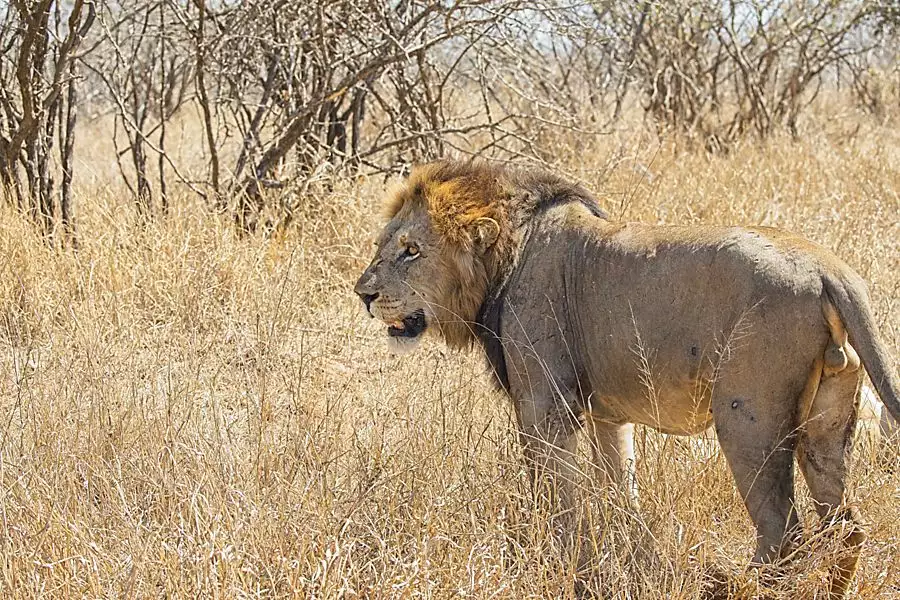
Lion Hunts Prices and Packages
Hunting methods for lion in south africa.
Lion hunting methods used on a South African hunting safari encompass a varied range of strategies tailored to the area and conditions.
The Baiting Method
One widely employed technique is hunting over bait. Large baits such as Buffalo or Zebra are strategically positioned to attract lions at the height of a grown mans head. Hanging baits at this height prevents other predators such as Hyena, Jackal and Leopard from feeding on the carcass. Once a Lion starts to feed on the bait the signs such as tracks and long mane hairs are evaluated to determine if a big maned male is present. A ground blind or elevated platform known as a machan are then built and the hunters wait for the lion to return.
An alternative method is to carefully stalk the bait at sunrise or sunset, in the hope of finding the lion still feeding. This method demands stealth and precision as the hunter stalks the lion on the bait, carefully closing the distance while maintaining the utmost caution and stealth to avoid being seen or heard.
Track and Stalk Method
The Track and Stalk Method of lion hunting is method often employed on a hunt in the Kalahari desert of Botswana and areas where you have sandy terrain. It begins by finding fresh lion tracks, carefully examining the imprints left on the ground to gauge the direction and possible proximity of the lion. This process requires a good tracker and an intimate knowledge of their habits, enabling the hunter to anticipate their possible intentions and proceed accordingly.
As the tracks lead deeper into the thick bush, the hunter must walk at a decent pace in order to catch up with the lion. This requires physical endurance and mental focus, as the pursuit can cover vast distances through entangled brush. The tension builds as the hunters navigate through thick vegetation, fully aware of the inherent dangers that may lie in wait close by. Lions are powerful and stealthy animals, capable of hiding within dense vegetation, making it imperative for the hunter to remain cautious and alert throughout the tracking process.
African Lion Hunting – The Approach
Safety considerations are of the utmost importance during a lion hunt, and experienced hunters must make critical decisions based on the circumstances. If the conditions become too hazardous or the risks outweigh the potential rewards, the hunt may be aborted to prioritize the safety of all involved. If the situation remains manageable, the hunter continues the hunt with cautious determination.
Approaching a lion requires the utmost care. The hunter must move silently, minimizing any sudden movements that could alert the lion to their presence. Finding a suitable position for a clear shot is essential, ensuring a clean and effective kill. The adrenaline surges as the hunter prepares to take the shot, fully aware that shot placement is crucial for a successful outcome. The vital areas, such as the heart and lungs, are targeted to swiftly incapacitate the lion, minimizing suffering and ensuring a humane kill.
Make the first shot count, you do not want to wound these big cats, this creates an extremely dangerous situation. In the event of a dangerous situation, a quick reload and the involvement of a backup shooter will become essential. Lions are formidable adversaries, and the ability to react quickly and decisively is vital for the safety of everyone involved. The backup shooter (normally a competent P H) provides an additional layer of protection, ready to intervene if the situation becomes precarious. Should a lioness be present you can generally expect a charge from her straight after the shot goes off. Unlike a Leopard a wounded lion will normally growl before a charge.
The overwhelming excitement and the realization of a successful lion hunt are incomparable to any other big game hunting. The culmination of tracking, stalking, and executing the perfect shot fills the hunter with a sense of accomplishment and respect for these majestic cats. It is a moment that encapsulates the primal connection between mankind and the wilderness, reminding us of our place in the intricate tapestry of nature.
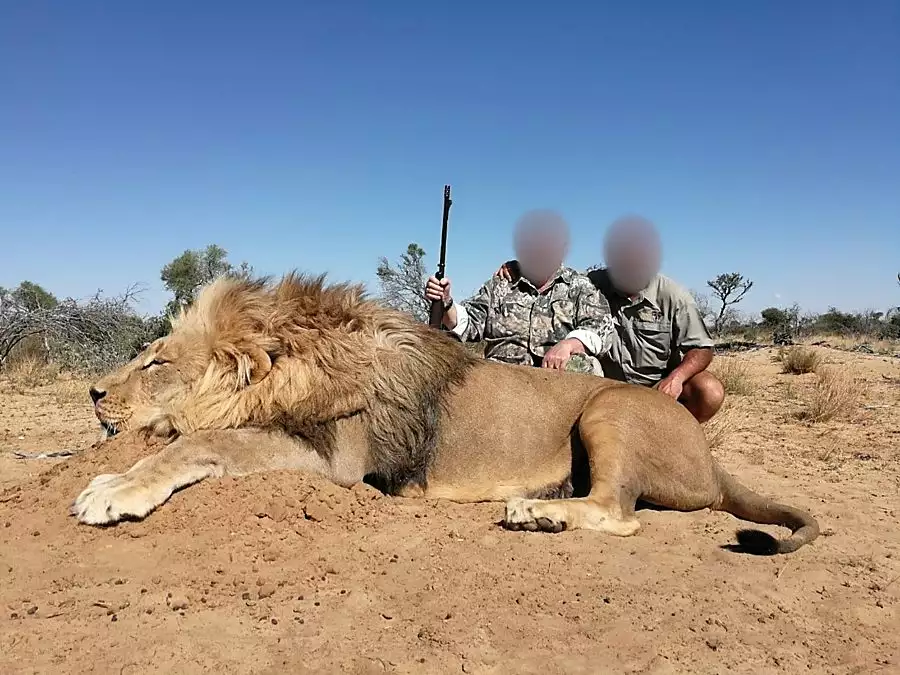
Trophy Lion Hunts
Trophy evaluation is an integral part of lion hunting, requiring the Professional guide to assess the quality and maturity of the animal. The evaluation often takes into account factors such as skull size and the quality of the lion’s mane. A larger skull indicates an older and more mature lion, while the larger and darker the mane signifies a top trophy. This evaluation process contributes to the conservation efforts of ensuring the sustainability of lion populations by selectively targeting older males, thereby allowing younger males to assume dominant roles and ensuring the genetic diversity and health of lion prides.
Conservation efforts and the need to protect this iconic species have led to strict regulations governing lion hunting. Hunting permits are carefully managed and allocated to ensure sustainable practices and prevent overexploitation. This approach acknowledges the intrinsic value of lions as apex predators and the importance of maintaining their populations for the overall health and balance of the ecosystem. Responsible hunters recognize the significance of these restrictions and actively participate in conservation efforts while engaging in legal and controlled Lion hunting.
Shot Placement on Safari
Shot placement is a critical aspect of hunting, particularly when targeting powerful and formidable animals like lions. It refers to the precise location on the animal’s body where the bullet or arrow should be placed to ensure a swift and ethical kill. In the context of lion hunting, where you place your shot is of the utmost importance to minimize suffering and ensure the hunting party’s safety. The objective is to deliver a well placed shot that targets vital areas such as the heart and lungs. Aiming for these specific areas maximizes the chances of incapacitating the lion quickly, leading to a efficient humane kill. Knowledge of the animals anatomy, understanding their skeletal and muscular structure are crucial factors that contribute to the hunter’s decisions on shot placement. This level of precision and accuracy in shooting is not only a testament to the hunter’s skill but also a reflection of their ethical commitment to ensuring the principles of responsible hunting.
To achieve this, hunters are recommended to use calibers with sufficient stopping power, such as the .375 H&H Magnum or 416 Rigby or Remington magnum. The .375 is considered the minimum caliber for hunting Lion or any other dangerous game in most African countries. These cartridges provide the necessary kinetic energy to effectively incapacitate the lion, minimizing suffering and ensuring a clean kill. While lions can be effectively put down with a 30-06, 300 Winchester Magnum or similar cartridge this practice is not recommended on a dangerous game hunt.

Safety and Ethical Considerations When Hunting Lions
Safety and ethical considerations are of paramount importance in lion hunting, reflecting the responsible approach of hunters towards both their own well-being and the preservation of these magnificent cats. Working with Hunting Outfitters and well qualified Professional Hunters ensures a structured and informed approach to the hunt, with hunters adhering to their instructions and guidance. This collaboration emphasizes safety protocols, including the use of proper rifle cartridges, adherence to firearm safety, and understanding the behavior and warning signs that lions emit. Prioritizing safety measures during encounters with lions is crucial, as these apex predators command respect and demand caution. Maintaining a safe shooting distance, avoiding unnecessary risks, and being prepared for uncontrolled and unpredictable situations are fundamental aspects.
Ethical considerations encompass the conservation of lion populations and the promotion of sustainable hunting practices. This involves adhering to strict hunting regulations and licensing restrictions, selectively targeting older males to allow younger males to assume dominant roles and contribute to the genetic diversity and health of lion prides, contributing to the conservation of these iconic beasts.
Lion hunting encapsulates the challenges of engaging with one of Africa’s most iconic animals. The pursuit of a big male African Lion represents a dream fulfilled for many hunters, as they embark on a thrilling adventure that tests their skills and deepens their connection with the untamed wilderness. Working closely with Professional guides and respecting conservation efforts is an essential part of a dangerous game hunt. Lions play a vital role in the delicate balance of the ecosystem, and the appreciation of their significance further enriches the hunting experience. With an understanding of the primal nature of these creatures, the fulfillment of a lifelong dream, and the commitment to responsible hunting, the pursuit of lions becomes a testament to the harmonious coexistence of humans and wildlife in the vast African bushveld.
FAQ’S Frequently Asked Questions
Where can i hunt lions in south africa.
Lion hunting in South Africa is primarily conducted on game reserves and private hunting concessions. These areas offer controlled hunting as a means of controlling lion populations in line with conservation policies. Some of the best lion hunting regions in South Africa include the Limpopo province and Mpumalanga province. In these areas, there are various hunting outfitters and professional guides who offer lion hunting opportunities. It is important to note that lion hunting in South Africa is regulated and requires proper permits and licenses. Working with a reputable hunting outfitter or booking through a registered safari operator is recommended to ensure compliance with local laws and regulations and a great African hunting Safari experience.
Is lion hunting Legal in South Africa?
Yes, lion hunting is legal in South Africa under specific regulations and with the necessary permits and licenses.
What is the best rifle and caliber for a lion hunt?
The best rifle and caliber for lion hunting would typically be a bolt-action or double rifle chambered in a caliber with sufficient stopping power. The .375 H&H Magnum is often considered the minimum caliber for lion hunting due to its ability to deliver the necessary energy for a clean kill. However, larger calibers such as .416 Rigby or Remington Magnum, .458 Winchester Magnum, or even .470 Nitro Express are also popular choices, offering increased stopping power and penetration. It is crucial to consult with experienced Professional Hunters and adhere to all regulations with regards the specific rifle and caliber requirements for lion hunting in the particular region.

Adrian Anderson first obtained his Professional Hunters license in 1991. He is a Big Five and Dangerous Game licensed Professional Hunter and Hunting Outfitter. He has a tremendous love for wildlife and the African bush and enjoys sharing his knowledge with the hunting clients that he guides. Guiding hunters in Africa’s wild places is a passion and seeing them succeed with their goals brings satisfaction. With knowledge of the Safari industry built up over 32 years he is well qualified to give guidance to his hunting clients.

19 Surprising Facts About African Lion Safari
Written by Cilka Horan
Modified & Updated: 29 May 2024
Reviewed by Sherman Smith
- African Wildlife Facts
- Animal Conservation Facts
- Big Cats Facts
- Endangered Animals Facts
- Endangered Species Facts
- Exotic Wildlife Facts
- Safari Adventure Facts
- Wildlife Education Facts
- Wildlife Facts
- Wildlife Park Facts
- Zoo Experience Facts
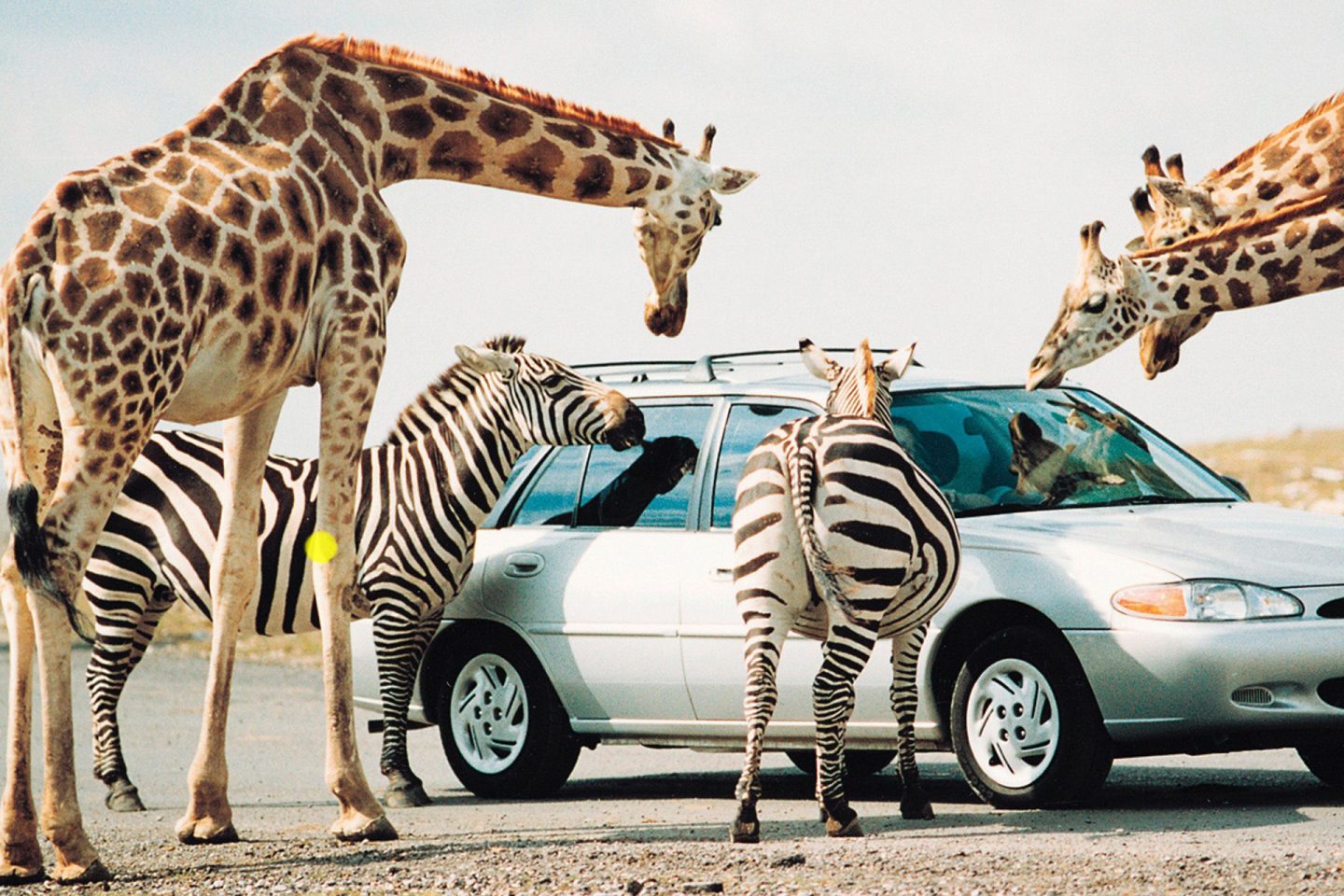
African Lion Safari is a fascinating and unique wildlife park located in Ontario, Canada. It is home to a wide variety of exotic animals, including the majestic lions that give the park its name. But there’s more to African Lion Safari than meets the eye. In this article, we will uncover 19 surprising facts about this renowned safari park that will leave you amazed and eager to plan your visit.From its humble beginnings as a lion breeding facility in 1969, African Lion Safari has grown into one of the premier destinations for animal lovers and adventure seekers. With its commitment to conservation and education, the park offers visitors a chance to get up close and personal with incredible animals, while also learning about the importance of protecting their habitats.So, fasten your seatbelts and join us on an exciting journey through these surprising facts about African Lion Safari. Get ready to discover hidden gems and intriguing stories that make this wildlife park truly extraordinary.
Key Takeaways:
- Explore African Lion Safari’s drive-through experience, elephant swim, and educational shows. Get up close with over 1,000 animals and enjoy behind-the-scenes tours and seasonal events for a wild adventure!
- African Lion Safari offers interactive experiences like feeding animals, photography workshops, and the “Monkey Walk.” Learn about conservation efforts, enjoy picnic areas, and find unique souvenirs at gift shops.
Home to Over 1,000 Animals
African Lion Safari is home to over 1,000 animals , including rare and endangered species. It serves as a conservation centre, dedicated to protecting these incredible creatures.
Drive-Through Safari Experience
One of the unique features of African Lion Safari is the drive-through safari experience. Visitors can drive their cars through the park and witness animals roaming freely in their natural habitat.
Feeding the Animals
During the safari tour, visitors have the opportunity to feed some of the animals with specially provided animal feed. This interactive experience brings you face to face with giraffes, zebras, and more.
Educational Shows
African Lion Safari offers various educational shows throughout the day. These interactive presentations allow visitors to learn more about the behavior, habitat, and conservation efforts for the different animal species in the park.
The Lion Pride
As the name suggests, the African Lion Safari is well-known for its impressive lion pride. Visitors can witness the majestic lions up close and even hear their powerful roars .
Safari Trek
The Safari Trek is a guided bus tour that takes you through the park’s expansive grounds. Knowledgeable guides provide interesting facts and information about the animals you encounter along the way.
The Great Lake
African Lion Safari boasts its own lake, aptly named “The Great Lake.” This picturesque body of water adds to the park’s natural beauty and serves as a habitat for various aquatic species.
The “Elephant Swim”
One of the most popular attractions at African Lion Safari is the daily “Elephant Swim.” Visitors can witness the massive elephants showcase their swimming abilities, a truly remarkable sight.
Bird Kingdom
African Lion Safari is also home to the Bird Kingdom, a sanctuary for a diverse range of stunning bird species. Visitors can explore aviaries and learn about different bird species.
The “Monkey Walk”
The “Monkey Walk” experience allows visitors to interact with a troop of friendly monkeys in a designated walk-through area. It’s an opportunity to observe these fascinating creatures up close.
Discover the Australian Outback
African Lion Safari’s Australian Outback exhibit lets visitors explore the unique wildlife of Australia, including kangaroos, wallabies, and emus.
Photography Workshops
For photography enthusiasts, African Lion Safari offers immersive photography workshops where participants can capture stunning images of the park’s wildlife under the guidance of professional photographers.
Behind-the-Scenes Tours
African Lion Safari provides behind-the-scenes tours that offer a glimpse into the daily operations and care of the animals. Visitors can learn about the park’s conservation efforts and meet the dedicated staff.
“Jungle Playground”
Perfect for families with children, African Lion Safari features a playground known as the “Jungle Playground.” Kids can enjoy slides , climbing structures, and interactive play areas.
Conservation Initiatives
African Lion Safari actively participates in various conservation initiatives, supporting research and breeding programs to help protect endangered species and their habitats.
Animal Enrichment Programs
The park’s animal enrichment programs ensure that the animals receive mental and physical stimulation in their environments. These programs replicate natural behaviors and provide a stimulating atmosphere for the animals.
Picnic Areas
African Lion Safari offers designated picnic areas where visitors can relax and enjoy their own packed lunches amidst the beautiful surroundings.
At African Lion Safari, you’ll find a variety of gift shops offering a range of souvenirs, clothing, and toys. It’s the perfect place to find a memento from your visit.
Seasonal Events
African Lion Safari hosts various seasonal events throughout the year, including holiday celebrations, themed weekends, and animal-focused activities, providing visitors with new and exciting experiences.
Embark on a wild adventure at African Lion Safari and discover the wonders of the animal kingdom. With its impressive variety of wildlife, educational shows, and immersive experiences, this safari park offers an unforgettable journey for the whole family.
In conclusion, African Lion Safari is a fascinating destination that offers a unique and unforgettable wildlife experience. With its impressive collection of animals, exciting safari rides, and educational programs, it is no wonder that African Lion Safari has become a popular attraction for animal enthusiasts and families alike. Visitors have the opportunity to observe and learn about various wildlife species, including the majestic African lions, in a natural and immersive setting. The park’s commitment to conservation and education further enhances the overall experience, making it both enjoyable and informative. Whether you are captivated by the sight of lions roaming freely or intrigued by the intricate behaviors of different animal species, African Lion Safari offers something for everyone. So, why not plan your visit and embark on an unforgettable adventure at African Lion Safari?
1. What is African Lion Safari?
African Lion Safari is a wildlife park located in Ontario, Canada . It is home to a variety of exotic animals, with a particular emphasis on African species such as lions, zebras, giraffes, and elephants.
2. How big is African Lion Safari?
The park spans over 750 acres, providing ample space for the animals to roam freely and recreate their natural habitats.
3. Can visitors go on a safari ride?
Yes, visitors can embark on a safari tour, where they can get up close and personal with the animals. The safari ride takes place in a designated area of the park, allowing visitors to experience the thrill of being surrounded by wildlife.
4. Are there other attractions besides the safari?
Apart from the safari ride, African Lion Safari offers various other attractions, including bird and animal presentations, a splash pad, a boat cruise, and opportunities for educational programs and interactions with some of the animals.
5. Is African Lion Safari involved in conservation efforts?
Yes, African Lion Safari is actively involved in conservation and breeding programs. They strive to protect endangered species and promote awareness about the importance of wildlife conservation.
6. What are the hours of operation?
African Lion Safari is open from May to September, with specific hours varying throughout the season. It is best to check the park’s official website for the most up-to-date information regarding operating hours.
Craving more captivating animal encounters? Uncover exotic animals in all their glory, plan an unforgettable family outing filled with fun and laughter, or embark on a thrilling safari adventure that will leave you breathless. From the wilds of Africa to the excitement of Chuck E. Cheese, there's no shortage of incredible experiences waiting to be discovered.
Was this page helpful?
Our commitment to delivering trustworthy and engaging content is at the heart of what we do. Each fact on our site is contributed by real users like you, bringing a wealth of diverse insights and information. To ensure the highest standards of accuracy and reliability, our dedicated editors meticulously review each submission. This process guarantees that the facts we share are not only fascinating but also credible. Trust in our commitment to quality and authenticity as you explore and learn with us.
Share this Fact:

Travelling Without a Passport

Best Safari Destinations in Africa for 2024
The Big Five have never been more appealing. Here are our big five safari destinations Africa for 2024 and beyond

“There is something about safari life that makes you forget all your sorrows and feel as if you had drunk half a bottle of champagne—bubbling over with heartfelt gratitude for being alive.” Karen Blixen, of Out of Africa fame, waxed rhapsodic about the wonders of the mighty continent and the appeal of a safari. Most of us have only seen wild elephants and lions in documentaries, but there’s nothing more thrilling than seeing these mighty beasts in their natural habitat. An elephant calf playfully following the herd, an ochre-hued lion gazing intently at wildebeests, a giraffe slowly chewing the branches from an acacia tree. Witnessing these animals on a safari in Africa truly transforms you and your views on conservation and sustainability.
Africa boasts dozens of countries, each with their own cultures, languages and norms, but across this dynamic continent, from north to south, lie wilderness parks, savannahs and velds where the Big Five—lions, elephants, cape buffalos, rhinos and leopards—and other animals live peacefully under the watchful eye of park rangers and conservationists. Check out our top five best safari destinations in Africa for 2024.
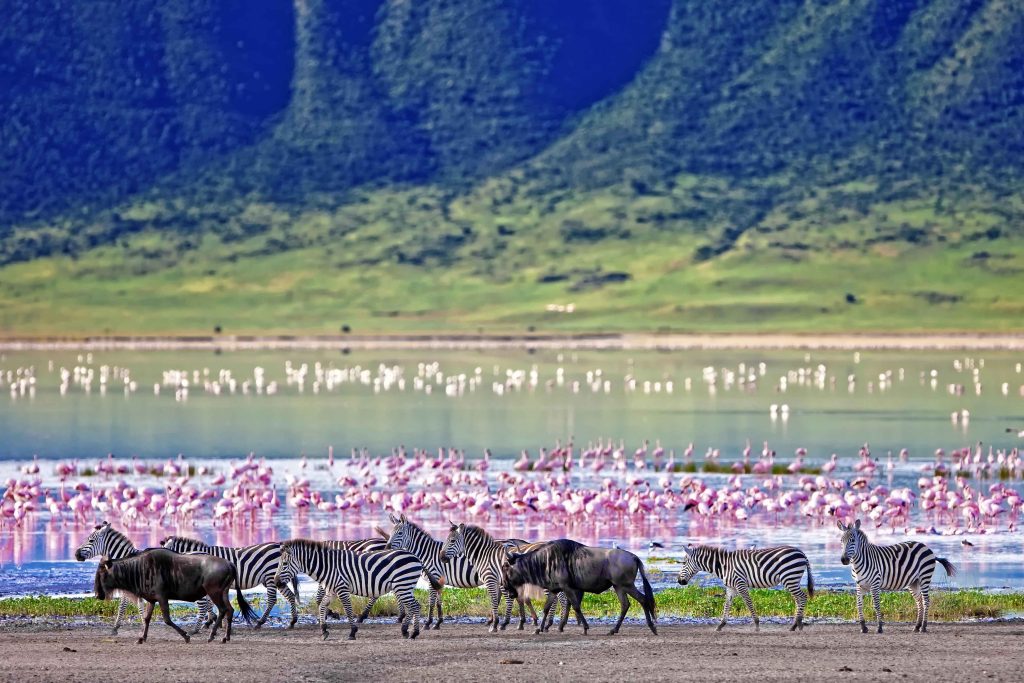
Botswana boasts so many natural wonders, it’s hard to pick a place to start when heading here for a safari adventure. The Okavango River Delta, the largest inland delta in the world, offers miles upon miles of myriad waterways, lagoons and grassy flood plains where one can admire mighty beasts from a safe vantage point in an overland truck. Get as close as you can get to African elephants as well as lions and leopards on a Botswana safari .
The Moremi Game Reserve, situated in the heart of the delta, is the perfect campsite for any driving safari as you’ll be rewarded with hippos, Cape buffalos, lions, leopards and the ever elusive Tawny Eagle. If you love elephants as much as we do, Chobe National Park on the border of Botswana and Zambia, boasts a herd population of around 50,000 elephants across the savannah. A Botswana safari is the perfect choice if you want to splurge on a private African safari tour as you get personal chefs and other amenities.
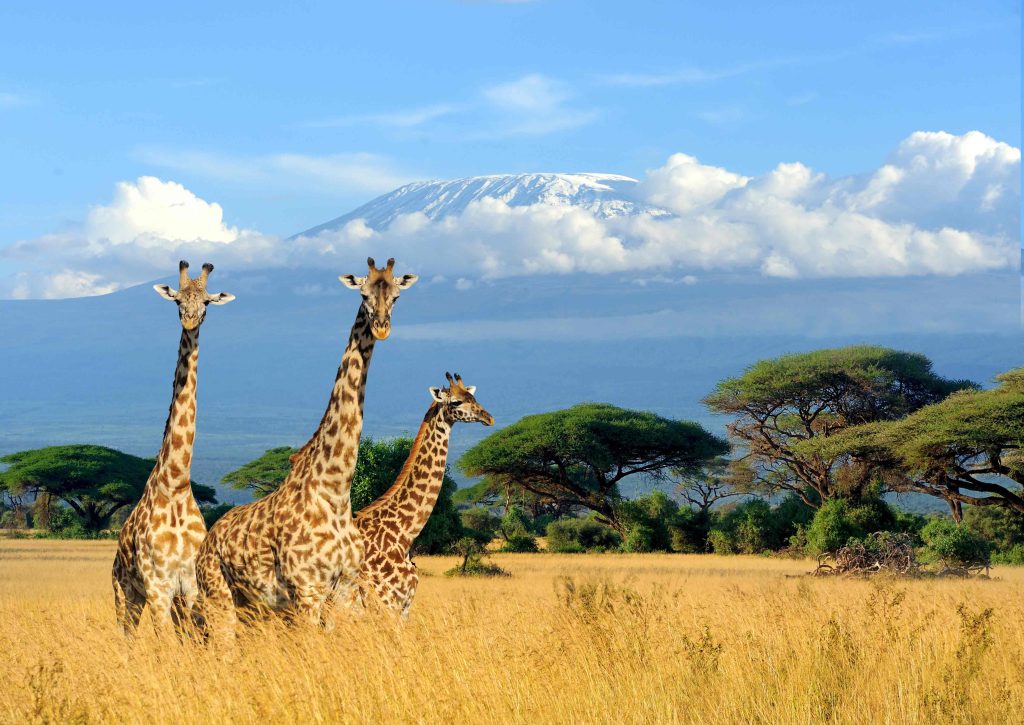
Kenya offers tantalizing glimpses of wildlife from any budget or luxury African safari tour. With more than 800 safari tours to choose from, travelers will find it hard to pick just one. Head to the Masai Mara for gaming drives that ensure you see at least one or two of the Big Five. Tsavo West National Park goes beyond the Big Five and offers rhinos, hippos, cheetahs and plant and bird species that you can’t find anywhere else. This rugged wilderness boasts verdant plains thanks to watering holes such as Mzima Springs.
Mt. Kilimanjaro is the resident icon here and with its snow-capped peaks as a backdrop, you’ll find elephants migrating from one watering hole to another at Amboseli National Park. Lake Naivasha, a freshwater lake, is a great vantage point to admire birds as well as hippos among papyrus reeds and flat-topped acacias. After six days of trekking and hiking, relax in your air-conditioned hotel in Nairobi when you’re done.
South Africa
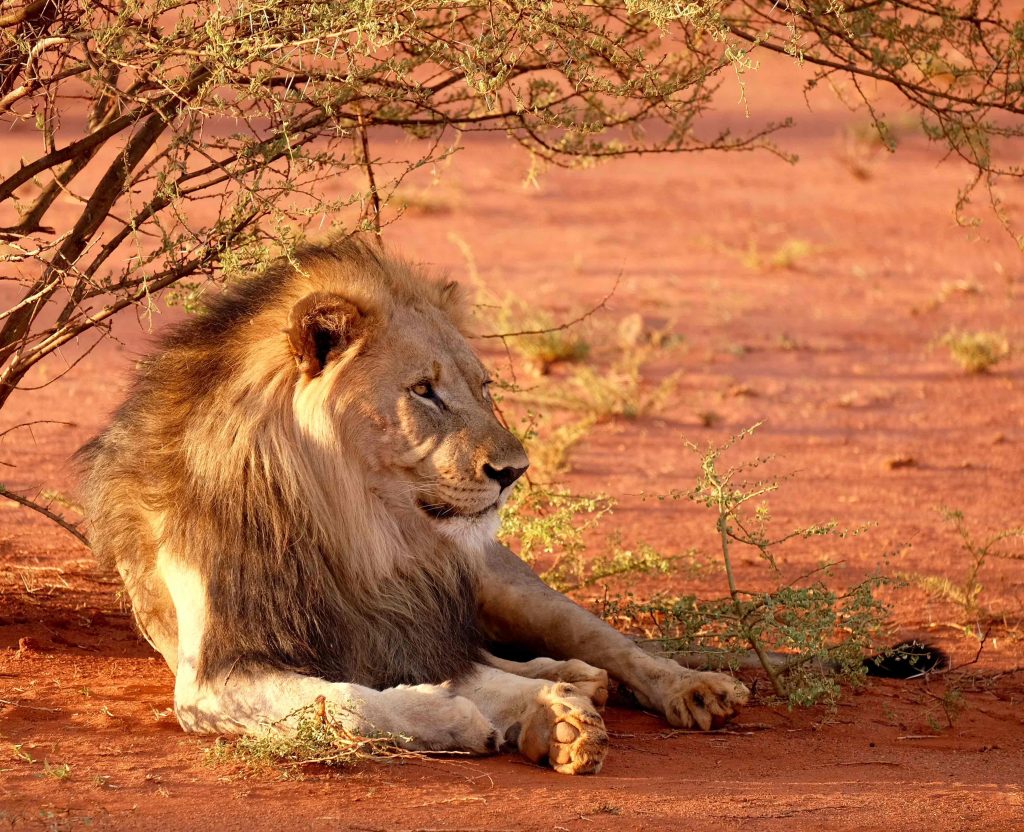
When one thinks of the Big Five, South Africa immediately comes to mind as it’s considered the place to see all of these animals in their natural habitat. A safari in South Africa means you’ll be guaranteed lions, leopards, rhinos, and other wildlife across a five- to eight-day African safari.
From the verdant banks of Lake Saint Lucia in iSimangaliso Wetland Park to the grassy plains of Kruger National Park, South Africa teems with wildlife that is indigenous to the continent. Blyde River Canyon, the third largest of its kind in the world, boasts gorges and greenery like you’ve never seen anywhere else on earth. Expect views of the rivers and valleys laid out like a banquet feast for the senses. Meandering ribbons of blue traverse the landscape and waterfalls are carved into cliff sides, offering a pleasing respite from long days in an overland truck tour.
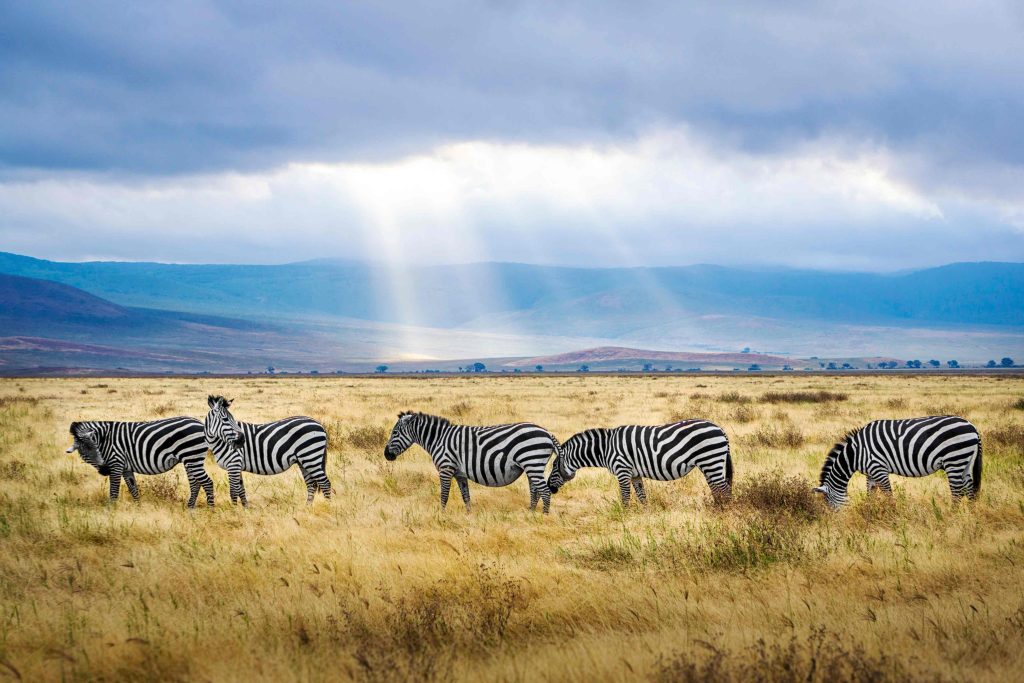
For African safari tours, Tanzania is always at the top when one thinks of best safari destinations in Africa. With sites such as Ngorongoro Crater, Mt. Kilimanjaro, Tarangire National Park, and Serengeti National Park it isn’t not hard to see why. A Tanzania safari is a one-of-a-kind experience thanks to the Great Migration. This annual event sees more than 2 million animals, mainly wildebeests, zebras and giraffes, traverse the golden plains of Serengeti National Park, from Tanzania to nearby Kenya. A safari in Tanzania is always appealing thanks to conservation efforts that preserve the Big Five and other wildlife as well as fertile soil and abundant watering holes.
On any given Tanzania safari, expect iconic wildlife while on a game drive and close-but-not-too close interactions with animals (perfect for anyone looking for an African safari photography tour); it’s one of our favorites because of this personal interaction. Descend into Ngorongoro crater where you might be lucky enough to spot an endangered black rhino or visit a Maasai village to learn about their way of life.
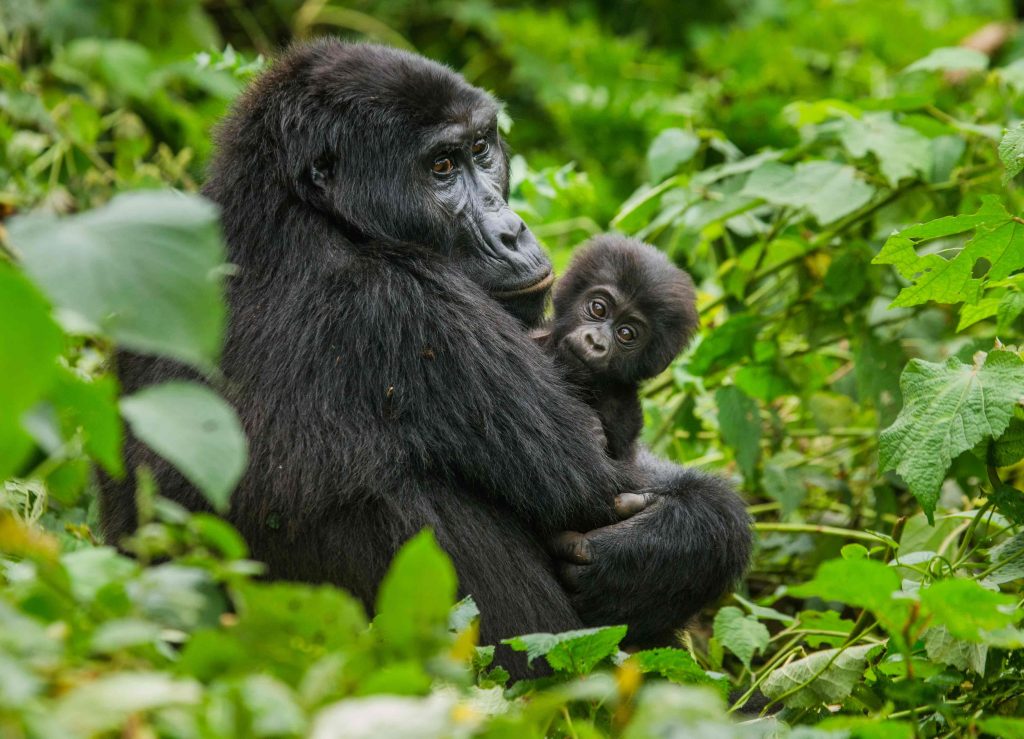
While most people head on an African safari to see the Big Five, there are other animals just as majestic and endangered as the mighty lion. Uganda boasts gorilla safaris so you can do your best Jane Goddall impression watching primates in their native habitat.
Before you get to the primates, travel to Ziwa Rhino Sanctuary to admire rare white rhinos, which have been saved from the brink of extinction by park rangers here. Track chimpanzees, our closest animal relatives, in Kibale Forest National Park. Then it’s time to hike 4-6 hours to see mountain gorillas.
In Bwindi Impenetrable Forest National Park you’ll get to spend one hour admiring these majestic beats in the dense foliage. Grab your camera and quietly take photos of these sociable creatures who are often in family groups of more than a dozen, led by an alpha male. These mighty animals can look placid but can be quite intimidating when viewed up close so don’t use your video camera or flash. You’ll leave your Uganda gorilla safari with a new appreciation for primates of all sizes.
See Also: Best Safari Destinations In the World

Shandana A. Durrani
Shandana A. Durrani is the Head of Content & Brand at TourRadar. A former Senior Editor at Cigar Aficionado and a former Dining Editor at Google, Durrani has written about travel for Condé Nast Traveler, Afar, Silverkris and Metro London and is the author of “Day Trips from New York City.”
Related Articles
- Destination Guide
- North America
- South America
- Tips & Tricks
Your 4 Must-Visit Inclusive Destinations
Nothing connects people from different parts of the world and disparate...
- Food & Drink
Your Guide to Amsterdam’s Secret Bars and Speakeasies
One of the most popular cities in Europe, Amsterdam has no...
Your Guide to Easter Around the World
Easter is a time to celebrate new beginnings. The symbols and...

Carnival Around the World
Get unlimited access to the world's best travel stories. subscribe now., privacy overview.

Animals Around The Globe (US)
Why Do Lion Not Attack When you Are In Safari Vehicle
Posted: June 9, 2024 | Last updated: June 9, 2024
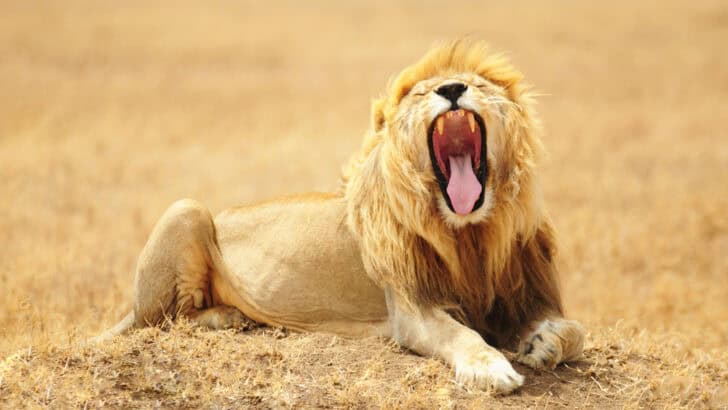
Why Do Lion Not Attack When you Are In Safari Vehicle?

Lions generally do not attack people in safari vehicles for a few reasons:
It is crucial, however, for visitors on safari to follow the rules and guidelines provided by their guides to ensure safety for both the tourists and the animals.
- Perception of the Vehicle as a Single Entity : Lions, like many wild animals , perceive a safari vehicle as a single, large entity rather than a collection of smaller parts (including people). This perception doesn’t trigger their predatory instincts as the vehicle does not resemble their natural prey.
- Lack of Threat : In the wild, lions are more likely to attack if they feel threatened. People in safari vehicles typically keep a respectful distance and do not act in a manner that the lions perceive as threatening.
- Habituation : Lions in areas frequently visited by safari tours become habituated to the presence of vehicles. Over time, they learn that these vehicles neither pose a threat nor offer an opportunity as prey. This habituation reduces the likelihood of an attack.
- No Provocation : Tourists are usually instructed not to make sudden movements or loud noises that might provoke or startle the lions. Staying still and quiet makes the lions less likely to view people as a threat or potential prey.
- Conservation and Protection Efforts : In many safari areas, conservation efforts have led to a situation where lions are not desperate for food due to healthy ecosystems, and they are not generally threatened by human activity, which reduces potential conflict.
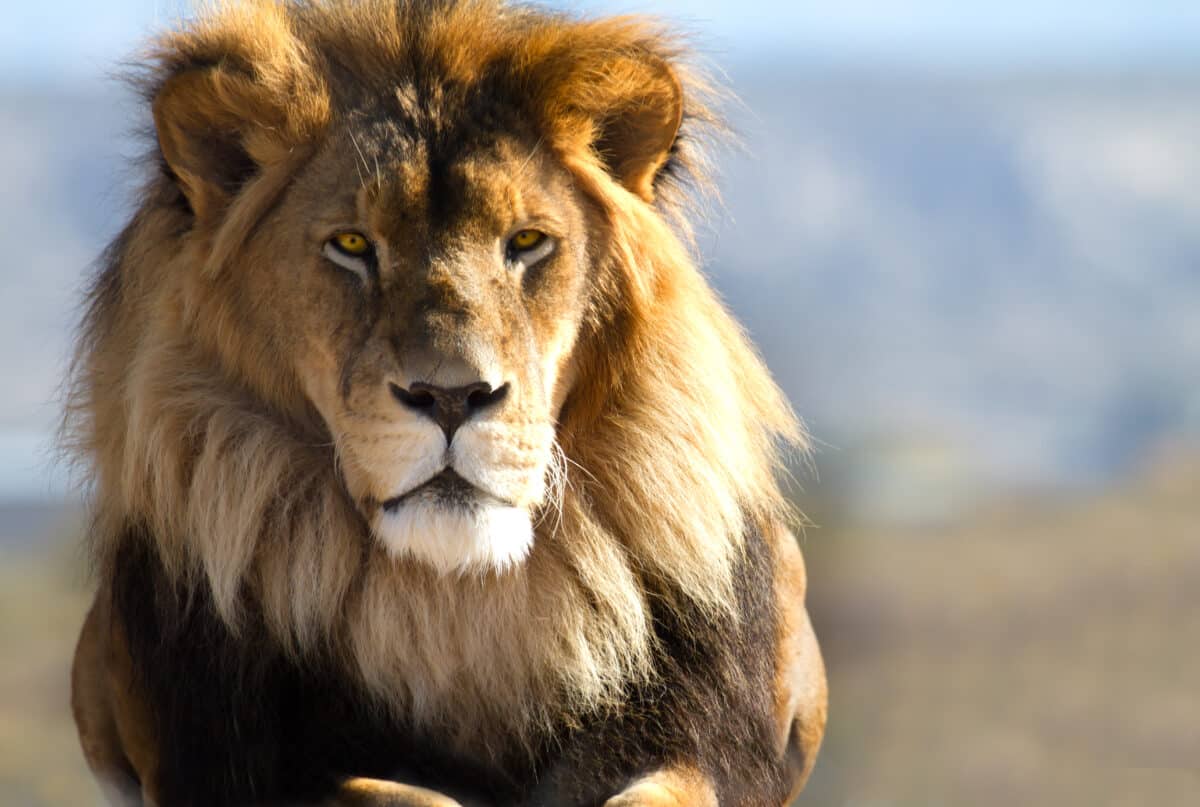
Lion Population in 2024
It’s important to note that the lion population has experienced a significant decline over the years. In the early 20th century, there were estimated to be as many as 300,000 lions in the wild. However, due to various factors such as habitat loss, human-wildlife conflict, poaching, and disease, the population has decreased substantially.
Tanzania holds the highest number of wild lions, with approximately 14,500 individuals, followed by South Africa with around 3,284 lions. Other countries with significant lion populations include Botswana (3,063), Kenya (2,515), and Zambia (2,349). In total, African lions are present in around 25 countries, but many of these nations have fewer than 250 individuals.
As of 2024, the global population of lions is estimated to be between 19,000 and 40,000 individuals, with a tendency towards the lower end of this range. The largest populations are primarily found in Africa, with a small population in the Gir Forest of India.
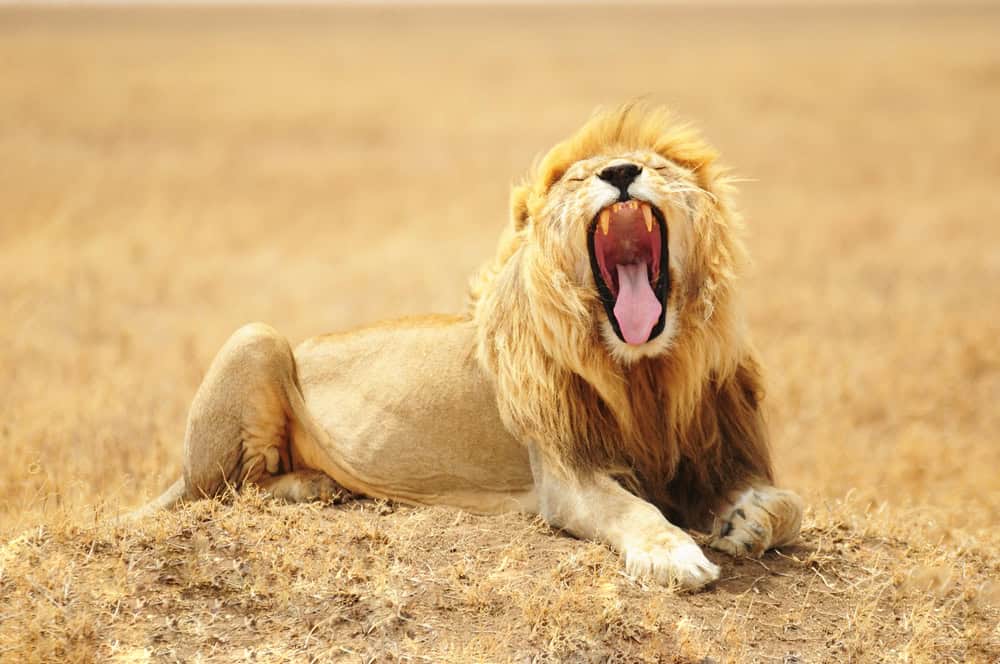
What are lions known for?
Lions are known for their powerful build, majestic mane (in males), and social behavior. They are apex predators and are often referred to as the “king of the jungle,” even though they primarily inhabit savannas and grasslands.
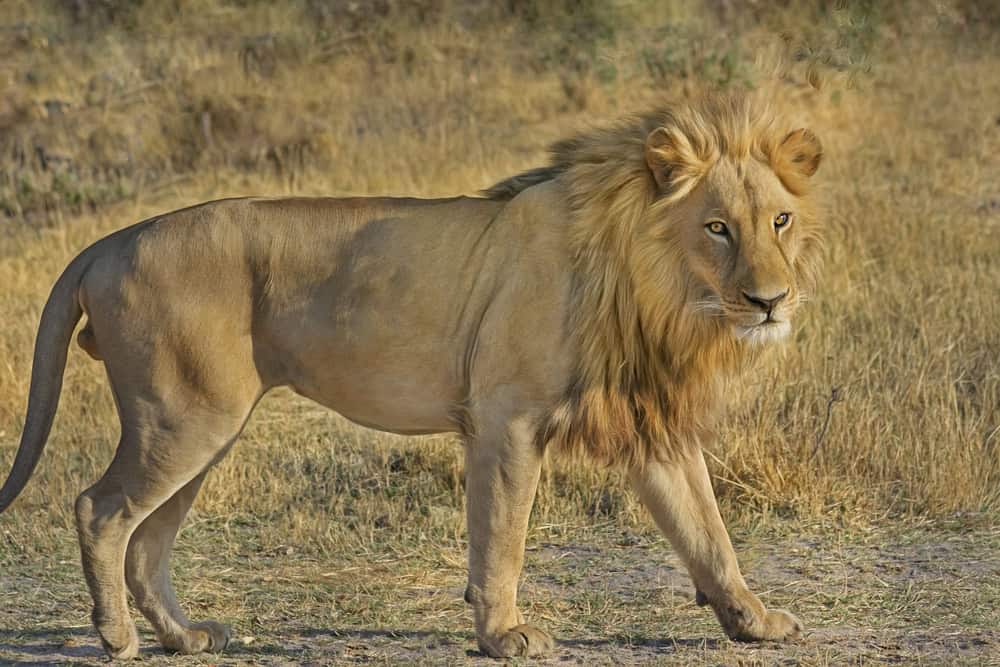
Where do lions live?
Lions are native to Africa and a small population exists in the Gir Forest of India. They prefer habitats that offer grasslands, savannas, dense scrub, and open woodlands, providing them with cover and ample prey.
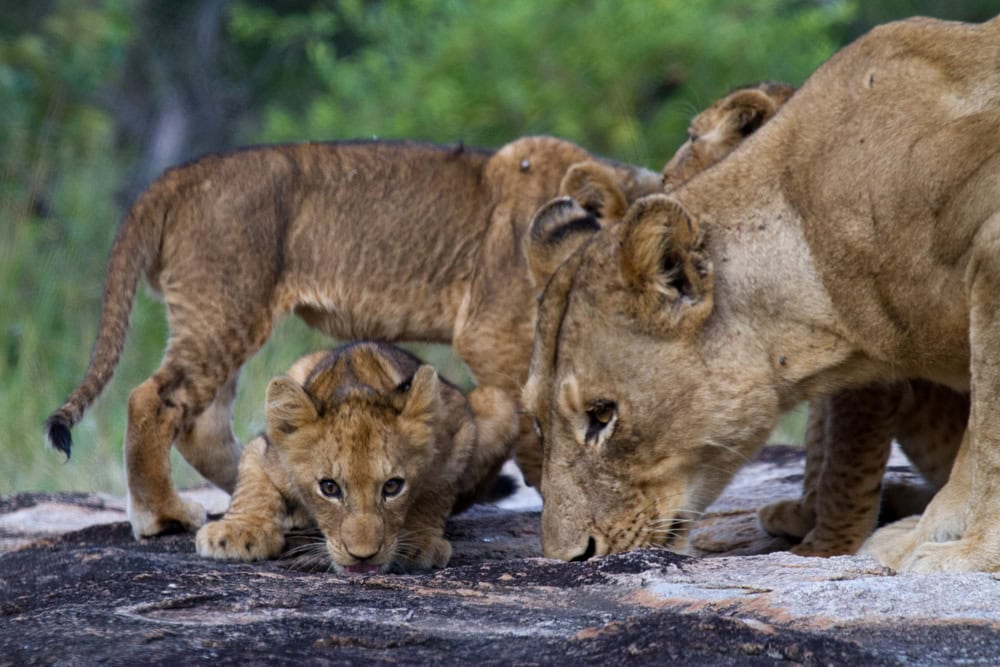
How do lions hunt?
Lions typically hunt in groups called prides, which are composed of related females, their offspring, and a small number of adult males. They use cooperative hunting strategies to take down large prey such as zebras, wildebeests, and buffaloes.

What is a lion's diet?
Lions are carnivores and primarily eat large ungulates. Their diet includes animals such as zebras, antelopes, buffaloes, and sometimes smaller animals like birds and rodents. They are also known to scavenge from other predators.
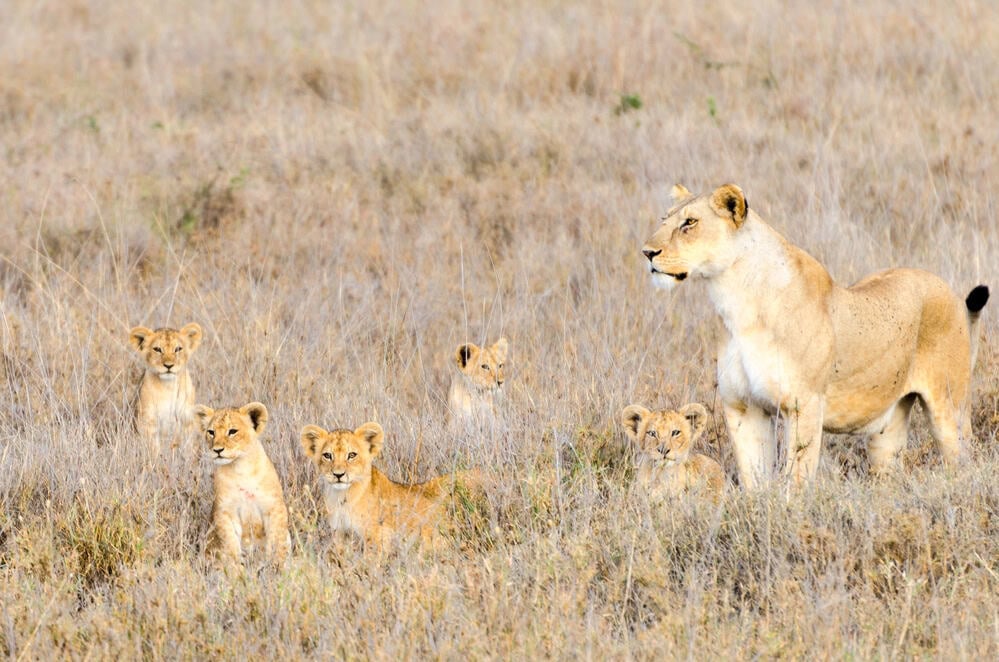
What is the social structure of a lion pride?
A lion pride is usually made up of related females and their cubs, along with a coalition of males who defend the pride’s territory. The females do most of the hunting and cub-rearing, while the males protect the pride from rivals.
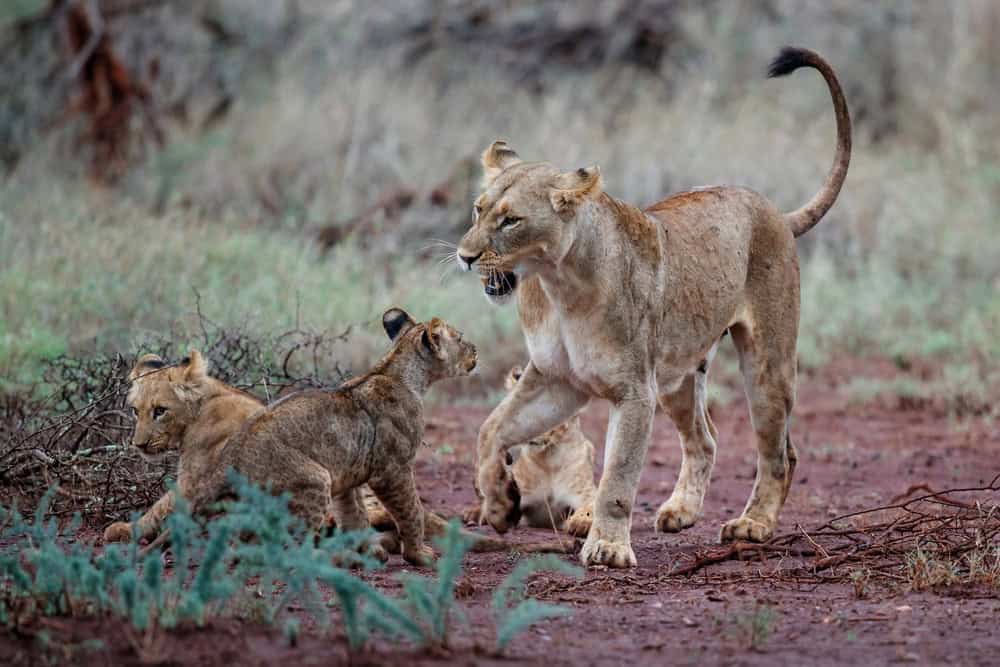
How long do lions live?
In the wild, lions typically live for about 10-14 years. In captivity, where they are free from threats like hunting and have consistent access to food, they can live up to 20 years.
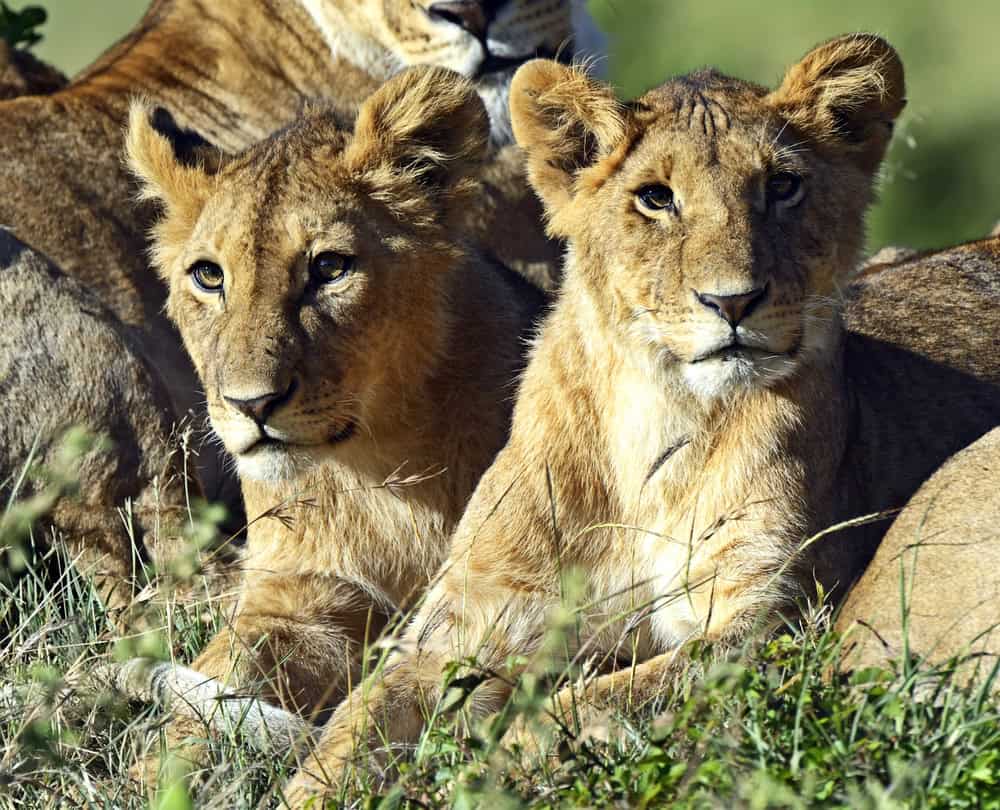
How do lions communicate?
Lions communicate through vocalizations like roars, growls, and grunts. They also use body language and scent marking to convey information about territory, reproductive status, and social hierarchy.
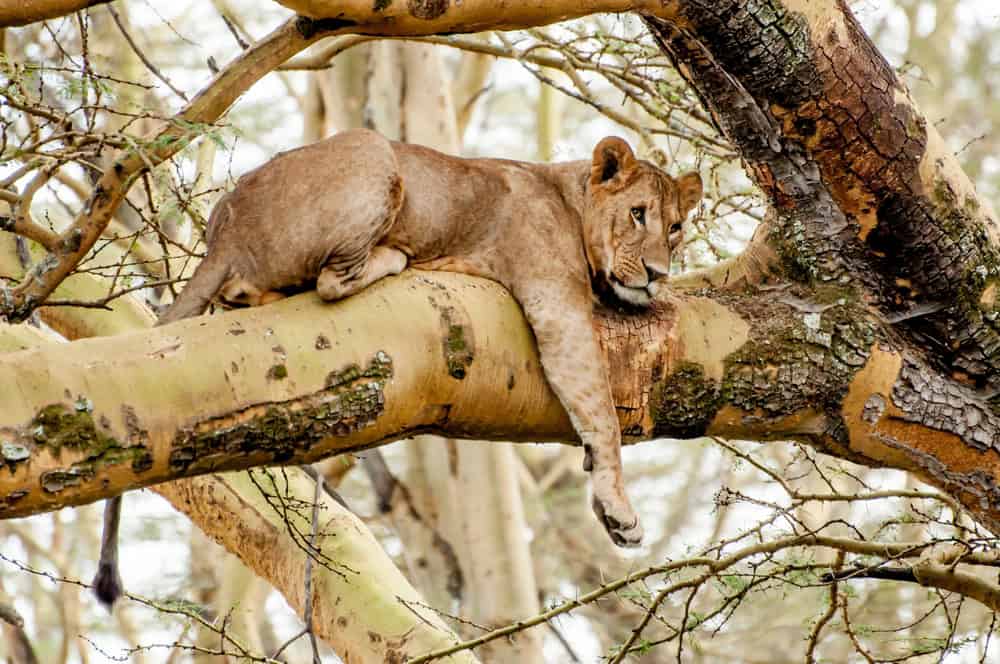
How do lions reproduce?
Lions do not have a specific breeding season and can reproduce throughout the year. After a gestation period of about 110 days, a lioness gives birth to a litter of 1-4 cubs, which she hides in dense vegetation until they are old enough to join the pride.
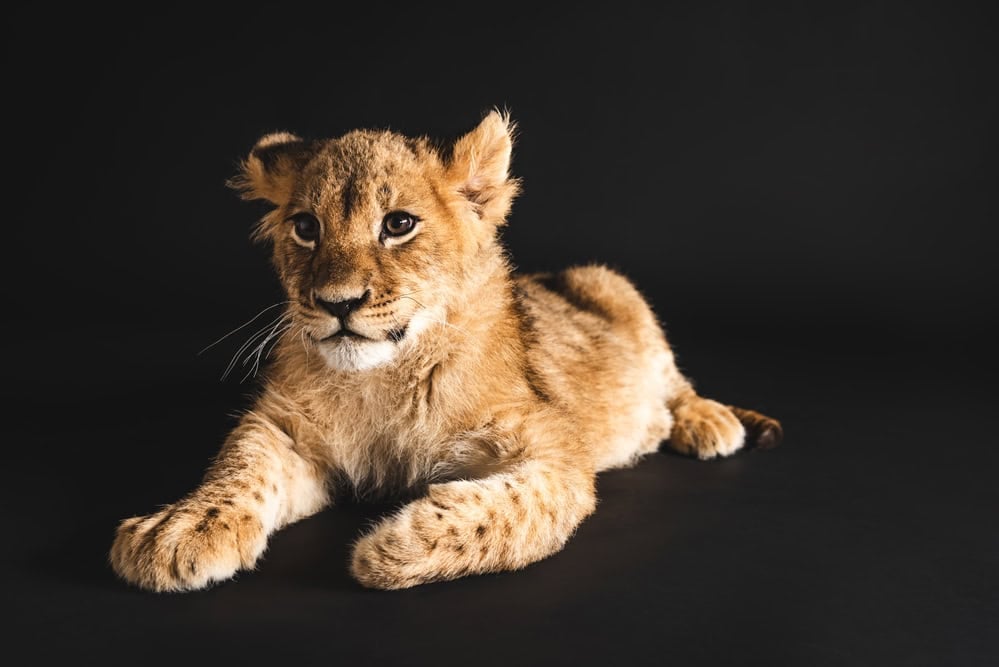
What threats do lions face?
Lions face several threats, including habitat loss, human-wildlife conflict, and poaching. They are also vulnerable to diseases such as canine distemper. Conservation efforts are critical to protect lion populations.
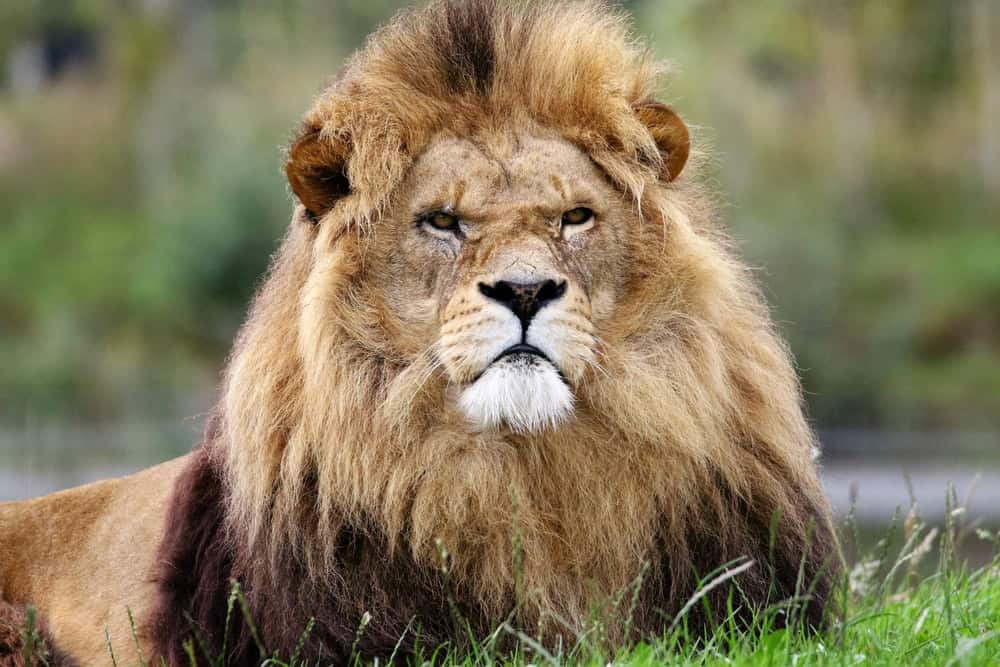
What is the conservation status of lions?
Lions are listed as vulnerable by the International Union for Conservation of Nature (IUCN). Their populations have declined significantly over the past few decades due to various threats. Conservation programs focus on habitat preservation, anti-poaching measures, and conflict mitigation to protect these majestic animals.
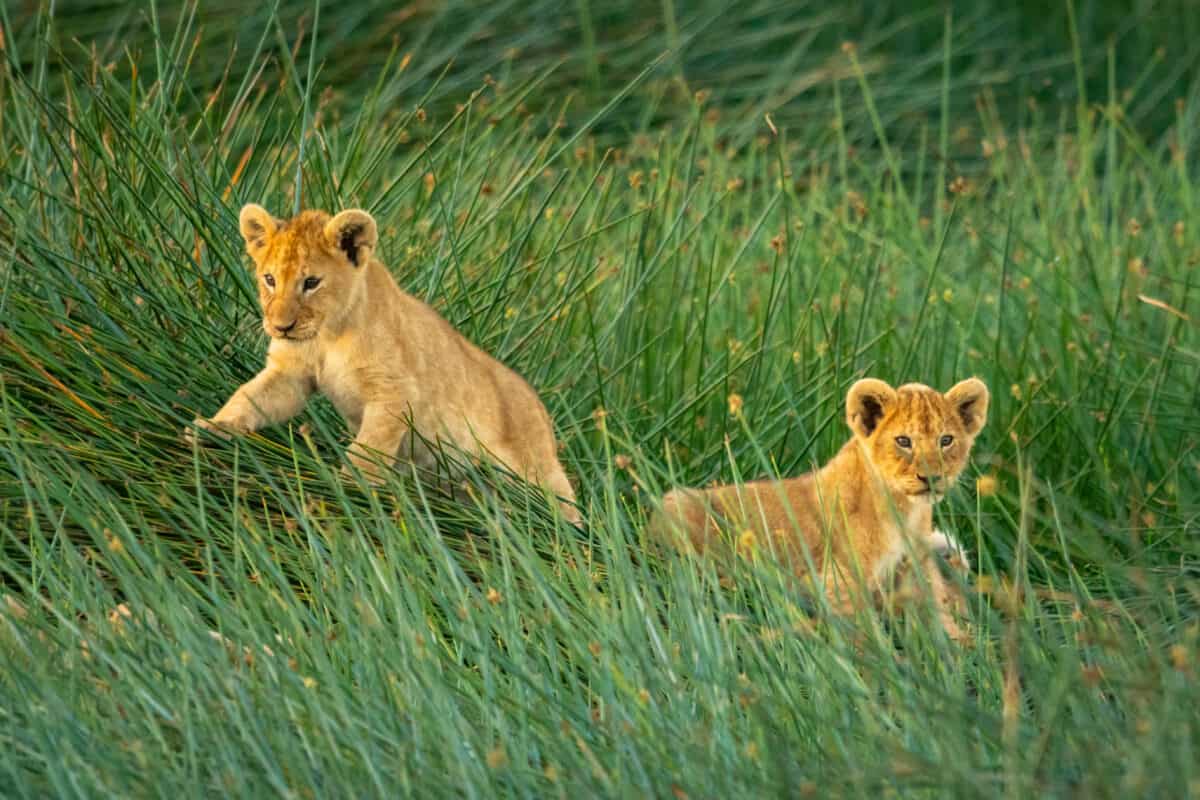
The post Why Do Lion Not Attack When you Are In Safari Vehicle appeared first on Animals Around The Globe .
Lion Pride Feasting on a King Crocodile
More like this:
The International Union for Conservation of Nature (IUCN) currently classifies the African Lion as Vulnerable, with a high risk of becoming Endangered if current trends are not reversed. The principal causes for the decline have been identified as indiscriminate retaliatory killing in defense of human life and livestock, habitat loss, and prey base depletion.
Conservation efforts are in place to try to reverse this decline, which include establishing protected areas, anti-poaching initiatives, and community-based conservation programs. Despite these efforts, the lion population continues to face challenges, and three-quarters of their population is in decline.
More for You
Lindsey Graham Rebukes Republican's Putin Remarks
Chopard, Dior, Saint Laurent Had the Biggest Brand Impact at Cannes With Bella Hadid, Demi Moore Moments
Trained, armed 'self-defense brigade' hits Hartford streets
The forgotten racial history of Red Lobster
‘We are blessed’: My mother, 72, gets $11,000 a month, not including income from retirement savings. Should she get long-term care insurance?
Brown vs. White Eggs: Here Are the Differences
Frustrated transit expert highlights major issues with popular truck design: 'There's no good reason for these to be legal'
See Courteney Cox Reenact Moves From Bruce Springsteen's ‘Dancing in the Dark' Video
Medical Mysteries: Dizzy and off-balance, she searched for the cause
‘That’s just not true’: Dave Ramsey surprises co-host by defending young Americans who need a ‘therapist’ to deal with the stress of tax season — why Ramsey’s on Gen Z’s side
'Monk': 10 Fun Facts About The Show
Should You Take Social Security at Age 62, 66, or 70? The Data Points to a Very Clear Answer
The Corn Shucking Hack That Makes Removing The Silk A Breeze
TRUST DROPS Supreme Court: Polls Reveal Americans Faith Waning
10 Things Everyone Forgets About The Datsun 240Z
Angel Reese Demands Change From Chicago Sky Teammates After Sixth WNBA Loss
The surprising effects loneliness has on your brain and body
25 Beach Towns You Can Actually Afford To Move To
Is long-term care insurance worth it for seniors in their 70s? Experts weigh in
America's Top 10 Most Dangerous Roads

George Lopez Video Shows He Warned Audience Before Storming Off Stage

Francesca Farago vs. Christina Milian Who'd You Rather?! (Fruity Swimwear Edition )

Taylor Swift Shuts Down Show Until Security Helps Fan in Viral Video

Guess Who This Lil’ Biker Turned Into!

Julia Louis-Dreyfus Calls Jerry Seinfeld's P.C. Stance A 'Red Flag'
Lions have sex on top of safari truck full of people, wild video, roaring sex lions get busy on top of safari truck ... tourists take it all in.
A couple of lions felt the love so much that they started banging on top of a tourist safari truck ... and the people inside certainly got an eyeful and then some.
A group of tourists partaking in a South African safari were recently left stunned as 2 randy big cats made themselves at home atop their vehicle.
The male lion is seen mounting a resting female lion ... confirming their boinking session with a couple of growls. The jeep noticeably shakes from side to side as they do it ... sparking laughter and gasps from the tourists seated below.
The lions' intimacy didn't last too long ... with the lioness lying tired to the side as the king of the jungle eventually disconnected.
While the encounter may have given some tourists the ick on the spot ... it's significantly less scary than the African elephant attack from earlier this month -- which ended in a death.
No one died here ... just a couple of kitties getting laid!
- Share on Facebook
related articles

Elephant Roams Montana Streets After Escaping Circus
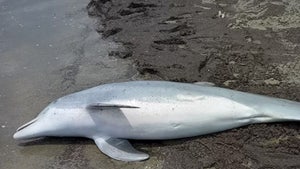
Dolphin That Washed Ashore in Louisiana Was Shot & Killed, Officials Say
Old news is old news be first.

IMAGES
VIDEO
COMMENTS
OPEN DAILY May 4 - September 15 & SELECT DATES September 18 - October 13. Misumu Bay Wetplay is open May 18 - September 2, 2024. We look forward to seeing you "On Safari!™"
In the game reserves and national parks of Southern Africa, the Big Five represents safari royalty: the African lion, the African leopard, the African elephant, the Cape buffalo, and the rhino (either white or black). The phrase was initially coined by early game hunters who recognized that these species were the most challenging and most ...
African Lion Safari is a family-owned safari park in Southern Ontario, Canada, located between the cities of Hamilton and Cambridge, located 100 kilometres (62 mi) west of Toronto.Guests may tour seven game reserves, with a total area of about 740 acres (300 hectares), on tour buses or in visitors' own vehicles, where animals roam freely in contained areas.
Just eight countries are believed to have at least 500 adult lions: Tanzania, Botswana, Kenya, Mozambique, South Africa, Zambia, Zimbabwe and Namibia. The lion is listed as Vulnerable by the International Union for the Conservation of Nature (IUCN). Where to go for your first safari in Africa.
Our African Lion Safari is the perfect way to learn all there is to learn about the lion and the other wild cat species in Africa. The characteristics and appearances of African wild cats vary greatly. There are 10 special wild cat species in Africa. They can be found in the Savannah, rainforests, and sand dunes.
In particular, the best African lion safari countries include Tanzania, Kenya, Namibia, Botswana, and South Africa. While all lions in Africa are the same species ( Pantera Leo), not all lion safari destinations are equal. While you can see these apex predators in Tanzania, Kenya, Zambia, Botswana, Namibia, Zimbabwe, and South Africa, different ...
Common Name - African Lion. Scientific Name - Panthera Leo. Current IUCN Red List Status - VU. Estimated no. of mature individuals - 23,000 -39,000. Lions are capable of living in a wide variety of habitats and are found across parts of sub-Saharan Africa (mostly Southern and Eastern Africa). Lions generally stick to areas such as ...
Once mostly targeted by hunters, these large species are "awe-inspiring" sights for safari-goers. If you've gone on an African safari, chances are you've heard of the Big Five, the must ...
African Lion. Enjoying the enviable position at the top of the food chain with no predators, the lion rules the wide-open African plains. The largest and grandest of all cats, lions live in small prides led by a single male. ... As the largest of the African safari animals in the antelope family, the eland is a majestic creature with a stocky ...
You'll enjoy all of the lion safari experiences without sacrificing your comforts and amenities as the night rolls in. LUXURY: For those discerning travelers, we offer incredible customizable luxury lion safaris where everything from private Tanzania safari tours to lavish private jets and opulent accommodations can be built into your bespoke 7 ...
Disclaimer: Almost all posts on this site contain Affiliate links, and this one about African Safari Animals: Big 5, Little 5 African Animals, Shy 5 African Animals, Impossible 5 African Safari Animals & Ugly 5 African Safari Animals is no different. This means that if you click on any of the links in this post (and make a purchase) I may receive a small commission at absolutely no cost to you.
African lion. African lions are revered the world over, but their population has shrunk in half over the past 25 years. Conflict with humans is one of the greatest threats they face. Photograph by ...
Unfortunately, the lion population has decreased by 43% in the last 21 years, to the current estimated population of only about 23,000 mammals today. Diet. The lion is an obligate carnivore, meaning it relies on flesh from animal tissues for its nutritional needs. A lion's body is unable to produce the amino acids it requires for survival.
The big five animals of Africa are African Elephant, Cape Buffalo, Leopard, Lion, and Rhinoceros. These five types of animals were named 'the big five' by big game hunters from African's colonial era, as they were considered the most difficult and dangerous African beasts to hunt on foot. These days, of course, any shooting of Africa's ...
It would be impossible to find all of Africa's wildlife species, prompting us to compile a list of thirty African safari animals you need to see, including lions, elephants, zebras, and antelopes, among others. Each animal we will consider has its scientific name, geographical range, conservation status, and photo highlighted, with a ...
Zambia South Luangwa. From $ 1890 /USD. per person per tour. VIEW SAFARI. 5 DAYS. Affordable Greater Kruger Safari Combo. Southern Africa South Africa Timbavati. From $ 1900 /USD. per person per tour.
Leopard. TripSavvy / Felicia Martinez. The elusive African leopard is a subspecies of leopard found only in sub-Saharan Africa. Despite its wide range, leopards are among the most difficult of all safari animals to see, as they are both nocturnal and exceptionally wary of humans.
In the vast bushveld of Africa, where the circle of life plays out, one animal is the true king of the bush, the magnificent African Lion. As a member of the dangerous game and Big Five animals, the Lion embodies strength, grace, and abundant courage. With its majestic mane and awe inspiring presence, it stands as the king of beasts in the ...
African Lion Safari is a fascinating and unique wildlife park located in Ontario, Canada. It is home to a wide variety of exotic animals, including the majestic lions that give the park its name. But there's more to African Lion Safari than meets the eye. In this article, we will uncover 19 surprising facts about this renowned safari park ...
1. Get the gear ready the night before to be sure you are well prepared. 2. Get up early so that you can be shooting in the first light when the big five are active. Plan your day around your shot ...
Panthera leo melanochaita , which is lions from Southwest Africa and Eastern and Southern Africa subpopulations.. Lion Family. The family lions belong to is Felidae, or cats. There are 41 species across this family that includes tigers, mountain lions, and bobcats.Lions belong to the subfamily Pantherinae which includes tigers, jaguars, leopards, clouded leopards, and snow leopards.
Tanzania. For African safari tours, Tanzania is always at the top when one thinks of best safari destinations in Africa. With sites such as Ngorongoro Crater, Mt. Kilimanjaro, Tarangire National Park, and Serengeti National Park it isn't not hard to see why. A Tanzania safari is a one-of-a-kind experience thanks to the Great Migration.
Lack of Threat: In the wild, lions are more likely to attack if they feel threatened. People in safari vehicles typically keep a respectful distance and do not act in a manner that the lions ...
Get closer than you ever imagined to majestic birds and animals from around the world as you drive along 9 kilometres of trail, through 7 large Game Reserves featuring Nairobi Sanctuary, Simba Lion Country, Timbavati Lion Country, Wankie Bushland Trail, Rocky Ridge Veldt, Australasia and The Americas. Weekdays: 10:00am - 4:00pm. Weekends: 10 ...
A couple of lions felt the love so much that they started banging on top of a tourist safari truck ... and the people inside certainly got an eyeful and then some. A group of tourists partaking in ...